By Sam Robinson |
at September 3, 2024 9:45 pm
Reaching their second Super Bowl in five seasons, the Eagles were a much-debated defensive holding call from having a shot to topple the Chiefs. Nick Sirianni‘s team then beat the defending champions in Kansas City last season. Philadelphia then saw its momentum stall, leading to one of the stranger collapses in recent NFL history. The Eagles went from an NFL-best 10-1 to ending the season in a wild-card blowout against a 9-8 team, leading to changes at many areas — including the offensive and defensive coordinator posts.
Sirianni was spared, as it would have been an interesting look for the Eagles to fire another Super Bowl coach not long after that appearance. But the fourth-year leader has moved to a hot seat. Sirianni’s relationship with Jalen Hurts is under the microscope, and Bill Belichick may be lurking. The Eagles, however, still boast a strong roster that could help their coach rebound from a disastrous finish. Despite the unraveling, the team got to work on fortifying both sides of the ball early.
Extensions and restructures:
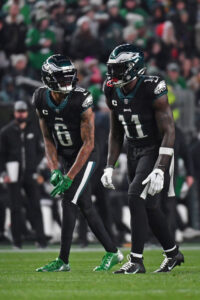 Playing 17-game seasons and coming along in a pass-friendly era, Brown now holds the top two spots on the franchise’s single-season receiving yardage list. Brown broke Mike Quick‘s 39-year-old record in 2022 and eclipsed it again last season. The Eagles did well to pry Brown from a Titans team that erred in assessing the changing WR market two years ago, and Philly’s latest agreement contributed to another positional boom this year.
Playing 17-game seasons and coming along in a pass-friendly era, Brown now holds the top two spots on the franchise’s single-season receiving yardage list. Brown broke Mike Quick‘s 39-year-old record in 2022 and eclipsed it again last season. The Eagles did well to pry Brown from a Titans team that erred in assessing the changing WR market two years ago, and Philly’s latest agreement contributed to another positional boom this year.
Shortly before the draft’s first night, the Eagles gave Brown a new deal that topped Amon-Ra St. Brown‘s record-setting AAV. After back-to-back 1,400-yard seasons, Brown landed a $32MM-per-year extension that moved guaranteed money up and gave the Eagles three more years of control. Given the changing market, that might be an issue down the road. The deal includes $84MM guaranteed in total. Brown, 27, also put to rest any rumored concerns he had with the Eagles by recommitting.
Brown’s contract, which runs through 2029, includes void years through 2034. Prorated option bonuses run through 2034, as the Eagles showed consistently this offseason — in rather innovative fashion — they will prioritize short-term cap position over down-the-road concerns.
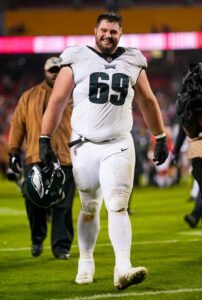 Just before the Brown extension, the Eagles made a bit of transaction history by locking down Smith. Since the 2011 CBA introduced the fifth-year option, teams have made those decisions annually since the first draft class eligible brought those decisions in 2014. No team in that span had paid a first-round receiver with two years of rookie-deal control remaining. The Eagles became the first, locking down Smith on an extension that became rather team-friendly as the offseason progressed. Smith’s deal both gives the Eagles five years of control and sets up the former Heisman winner as the NFL’s 11th-highest-paid receiver going into the season.
Just before the Brown extension, the Eagles made a bit of transaction history by locking down Smith. Since the 2011 CBA introduced the fifth-year option, teams have made those decisions annually since the first draft class eligible brought those decisions in 2014. No team in that span had paid a first-round receiver with two years of rookie-deal control remaining. The Eagles became the first, locking down Smith on an extension that became rather team-friendly as the offseason progressed. Smith’s deal both gives the Eagles five years of control and sets up the former Heisman winner as the NFL’s 11th-highest-paid receiver going into the season.
Bailing out the Eagles for their JJ Arcega-Whiteside and Jalen Reagor missteps, Smith has delivered as Brown’s wingman. He has joined the trade acquisition in elevating Hurts, who was tied to a run-heavy offense in Smith’s rookie year. Smith has posted back-to-back 1,000-yard seasons, scoring seven TDs in each campaign.
The Eagles having their 25-year-old WR2 as the NFL’s 11th-highest-paid wideout now should age very well, as the market figures to keep spiking or at least gradually increasing while the Alabama alum is tied to this pact. Smith still secured the chance, via a three-year deal, to cash in again in his 20s as well.
Known for taking early action along their offensive front, the Eagles made two steps in that direction this year as well. The first of the Eagles’ would-be Jason Kelce heir apparents — before staying at guard and becoming one of the NFL’s best — Dickerson enters this season as the NFL’s highest-paid guard. The Eagles gave Dickerson $21MM per year, topping Chris Lindstrom‘s previous position record. The former second-round pick became a quick study at left guard, quickly taking over for Brandon Brooks and later helping the Eagles feel comfortable letting Isaac Seumalo walk in free agency.
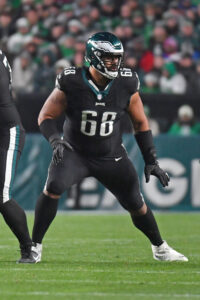 Developing under acclaimed O-line coach Jeff Stoutland, Dickerson ranked second in pass block win rate and first in run block win rate in 2022. Dickerson also led all interior O-linemen in run block win rate last season, while also ranking as a top-10 player in pass protection. Going into his age-26 season, Dickerson will be counted on as the Eagles aim to replace future Hall of Famer Jason Kelce.
Developing under acclaimed O-line coach Jeff Stoutland, Dickerson ranked second in pass block win rate and first in run block win rate in 2022. Dickerson also led all interior O-linemen in run block win rate last season, while also ranking as a top-10 player in pass protection. Going into his age-26 season, Dickerson will be counted on as the Eagles aim to replace future Hall of Famer Jason Kelce.
Stoutland completed a more impressive accomplishment with Mailata, leading the effort in the Eagles turning him from a rugby performer to long-term project to standout left tackle. Philly had drafted Andre Dillard to eventually succeed Jason Peters, but a seventh-round pick became the better option. Philly now has three $20MM-per-year O-linemen on an offense with a $50MM-per-year quarterback, an eight-figure running back and two highly compensated receivers.
Two seasons remained on Mailata’s initial Eagles extension (four years, $64MM), but the team operated proactively once again — with cap savings at the root of the move. Mailata’s $22MM-per-year deal tops Lane Johnson‘s AAV while ranking fifth among left tackles. The Australian has yet to draw a Pro Bowl invite, but Pro Football Focus has viewed him as a top-10 tackle in each of the past three years. Run block win rate slotted Johnson and Mailata at Nos. 1 and 2 last season. The Eagles now have their ascending LT signed through 2028, with the team’s usual batch of option bonuses and void years included to defray the cap hits.
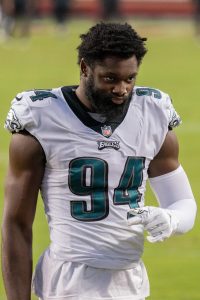 As the Eagles rearranged their edge-rushing setup, they prioritized Sweat over Haason Reddick. Though, they took trade calls on both players during an uncertain period ahead of free agency. A 2018 fourth-round pick, Sweat is nearly three years younger (at 27). Sweat was tied to a three-year, $40MM extension that expired after the 2024 season. He agreed to a compromise, accepting a one-year, $10MM redo that came nearly fully guaranteed. With Reddick gone, Sweat is positioned to remain a key piece.
As the Eagles rearranged their edge-rushing setup, they prioritized Sweat over Haason Reddick. Though, they took trade calls on both players during an uncertain period ahead of free agency. A 2018 fourth-round pick, Sweat is nearly three years younger (at 27). Sweat was tied to a three-year, $40MM extension that expired after the 2024 season. He agreed to a compromise, accepting a one-year, $10MM redo that came nearly fully guaranteed. With Reddick gone, Sweat is positioned to remain a key piece.
By agreeing to a reworking rather than an extension, Sweat has a platform year ahead and could become one of the 2025 free agent class’ top players with a standout season under the new DC. Sweat slowed late last season along with Reddick, as Philly’s defense crumbled, but he has been a three-year starter and notched 11 sacks as the team pushed for the 1984 Bears’ single-season record in 2022.
The Eagles have Nolan Smith waiting in the wings, and while they will need to see more from the pass-rushing specialist, their 2025 starting OLBs may well be Smith and Bryce Huff.
Free agency additions:
- Bryce Huff, DE. Three years, $51MM ($34MM guaranteed)
- Saquon Barkley, RB. Three years, $37.75MM ($26MM guaranteed)
- C.J. Gardner-Johnson, S. Three years, $27MM ($10MM guaranteed)
- Devin White, LB. One year, $4MM ($3.5MM guaranteed)
- Zack Baun, LB. One year, $3.5MM ($3.5MM guaranteed)
- Mekhi Becton, G. One year, $2.75MM ($2.75MM guaranteed)
Since trading LeSean McCoy in 2015 (on Chip Kelly‘s watch), the Eagles have kept costs low at running back. They did not re-sign Jay Ajayi, Jordan Howard or Miles Sanders and let D’Andre Swift walk this offseason. Swift’s price point became an issue for the Eagles, but Barkley’s subsequent contract revealed how wide of a gap Philly placed between Swift and its new starter. Plenty came out about Barkley’s free agency this offseason, thanks to Hard Knocks’ inaugural offseason effort, but Howie Roseman zagged after the RB market reached a crisis point in 2023.
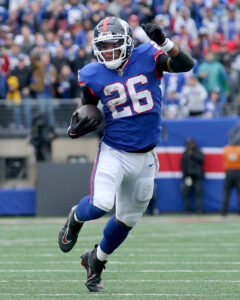 Barkley joined Josh Jacobs and Tony Pollard in being tagged and not extended. This came after the Vikings and Cowboys cut stalwart RBs Dalvin Cook and Ezekiel Elliott, and the offseason ended with Joe Mixon following Aaron Jones in taking pay cuts. Entering last season, no RB had been given an eight-figure-per-year contract since July 2021. After the cap’s record-setting $30.6MM spike, the RB market — following Jonathan Taylor‘s October extension — course corrected a bit. A host of starters landed decent deals in 2024, but the Eagles came in with an outlier pact that rewarded the top talent on the market. Barkley’s $26MM guarantee at signing leads the RB pack, and the Eagles pounced after the Giants passed on a second franchise tag.
Barkley joined Josh Jacobs and Tony Pollard in being tagged and not extended. This came after the Vikings and Cowboys cut stalwart RBs Dalvin Cook and Ezekiel Elliott, and the offseason ended with Joe Mixon following Aaron Jones in taking pay cuts. Entering last season, no RB had been given an eight-figure-per-year contract since July 2021. After the cap’s record-setting $30.6MM spike, the RB market — following Jonathan Taylor‘s October extension — course corrected a bit. A host of starters landed decent deals in 2024, but the Eagles came in with an outlier pact that rewarded the top talent on the market. Barkley’s $26MM guarantee at signing leads the RB pack, and the Eagles pounced after the Giants passed on a second franchise tag.
The Eagles won a bidding war that featured a lucrative Texans offer, along with Bears and Chargers interest, for a player who has dealt with a number of injuries but one that has shown difference-making ability when healthy. Barkley spent much of his prime trapped behind poor Giants O-lines. The Eagles are betting the two-time Pro Bowler has some of his prime remaining, and they will place him behind a top-tier offensive front. Barkley still finished in the top 10 in rushing yards over expected last season, and he powered the Giants to the 2022 divisional round despite that team being largely bereft of talent at the skill spots.
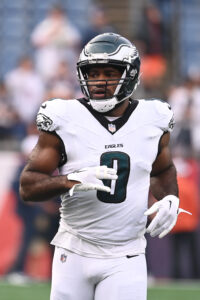 GM Joe Schoen citing the RB’s age (27) as a key factor behind the Giants moving on. Though, FA replacement Devin Singletary turns 27 today. The Giants will see the former Offensive Rookie of the Year again soon. Unlike the Falcons and Kirk Cousins, no tampering penalty ultimately emerged for the Eagles.
GM Joe Schoen citing the RB’s age (27) as a key factor behind the Giants moving on. Though, FA replacement Devin Singletary turns 27 today. The Giants will see the former Offensive Rookie of the Year again soon. Unlike the Falcons and Kirk Cousins, no tampering penalty ultimately emerged for the Eagles.
As the Jets’ standoff with Haason Reddick persists, the Eagles poached a player New York had deemed ill-equipped for full-time duty. The Eagles appear prepared to unleash Huff, who led the NFL in pressure rate (21.8%) during his 10-sack breakout season. The Jets passed on franchise-tagging Huff, and as they aim for Reddick to be an every-down player, the Eagles clearly viewed Robert Saleh‘s designated pass rusher as an underused asset.
The Jets gave Huff, a 2020 UDFA, just 480 defensive snaps last season. He flashed brightly for another imposing defense, albeit in a part-time capacity. Vic Fangio has a history of coaxing high-end production from edge players, with DPR-type Aldon Smith‘s early-career 49ers work coming to mind. The Eagles could come out of this Reddick-for-Huff switch looking good, though they will bet on a player PFF deemed a poor run defender being able to handle an increased workload.
Read more
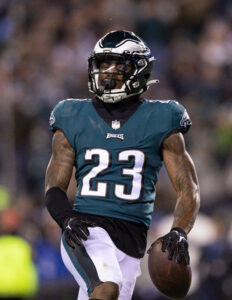 Conflicting reports came out about the Eagles and Gardner-Johnson in 2023, but the team clearly missed the versatile DB/trash talker extraordinaire. Injury and performance issues plagued the Eagles at safety in 2023, and Gardner-Johnson — who excelled for the 2022 Eagles edition, intercepting an NFL-high six passes despite missing five games — secured better terms than his Lions pact despite missing almost all of 2023 with a torn pec. Recovering from a late-season ACL tear, Sydney Brown landed on the reserve/PUP list. Converted corner James Bradberry is on IR. Gardner-Johnson, 26, will team with returner Reed Blankenship in the meantime.
Conflicting reports came out about the Eagles and Gardner-Johnson in 2023, but the team clearly missed the versatile DB/trash talker extraordinaire. Injury and performance issues plagued the Eagles at safety in 2023, and Gardner-Johnson — who excelled for the 2022 Eagles edition, intercepting an NFL-high six passes despite missing five games — secured better terms than his Lions pact despite missing almost all of 2023 with a torn pec. Recovering from a late-season ACL tear, Sydney Brown landed on the reserve/PUP list. Converted corner James Bradberry is on IR. Gardner-Johnson, 26, will team with returner Reed Blankenship in the meantime.
Typically replacing exiting O-linemen from within, the Eagles are set to fill Kelce’s shoes with a newcomer. Right guard Cam Jurgens made good on the team’s multiyear plan of sliding him to center, and 2023 third-rounder Tyler Steen had been the team’s preference to step into the starting lineup. Becton changed the plan, usurping Steen after the second-year blocker dealt with injuries during training camp. This will be quite the O-line subplot entering the season, as Becton has been a tackle since his Louisville days and has an extensive injury history.
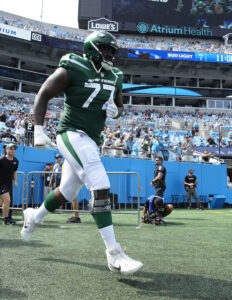 The former first-round pick missed all but one game from 2021-22, and although he returned for 16 starts (at both left and right tackle) for last year’s Jets edition, no market formed. The Eagles landed the slimmed-down blocker post-draft. They have some insurance in the event the converted tackle does not pan out, with Steen lurking and former Giants and Commanders starter Nick Gates on the practice squad.
The former first-round pick missed all but one game from 2021-22, and although he returned for 16 starts (at both left and right tackle) for last year’s Jets edition, no market formed. The Eagles landed the slimmed-down blocker post-draft. They have some insurance in the event the converted tackle does not pan out, with Steen lurking and former Giants and Commanders starter Nick Gates on the practice squad.
Last year’s plan to install Nakobe Dean as the Eagles’ linebacking centerpiece did not work out; the 2022 third-rounder missed most of the season. White and Baun are now in place, though each is tied to a stopgap contract. Baun only started 14 games in four Saints seasons, but he is set to work as a first-stringer. Dean is still slated to play a key role, but the Eagles added some interesting veterans after being caught shorthanded last season.
White was electric at points in Tampa, posting a nine-sack season as an off-ball linebacker, but his freelancing became an issue for the Buccaneers. Pro Football Focus had long viewed White as one of the NFL’s most overrated players, and after he sought a top-five ILB deal, the Bucs wrapped his contract year by reducing his playing time.
Re-signings:
- Brandon Graham, DE. One year, $4MM ($4MM guaranteed)
- Braden Mann, P. Two years, $4.2MM ($2.78MM guaranteed)
- Avonte Maddox, CB. One year, $2MM ($875K guaranteed)
- Albert Okwuegbunam, TE. One year, $1.4MM ($725K guaranteed)
- Rick Lovato, LS. One year, $1.26MM ($550K guaranteed)
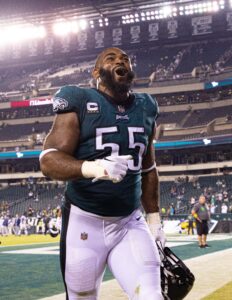 Graham edged Kelce for the Eagles’ games-played crown, with both surpassing David Akers‘ mark last season. Graham (195 career games), however, had wanted to become the first Eagle to play 15 years with the team. He is about to eclipse Chuck Bednarik‘s franchise longevity standard. Graham, 36, is back in place as a supplementary pass rusher. Fangio will be Graham’s ninth defensive coordinator (counting the Matt Patricia period) in a career that dates back to Sean McDermott‘s tenure in the post, making it interesting the Eagles have continued to value the 2010 first-rounder as they have.
Graham edged Kelce for the Eagles’ games-played crown, with both surpassing David Akers‘ mark last season. Graham (195 career games), however, had wanted to become the first Eagle to play 15 years with the team. He is about to eclipse Chuck Bednarik‘s franchise longevity standard. Graham, 36, is back in place as a supplementary pass rusher. Fangio will be Graham’s ninth defensive coordinator (counting the Matt Patricia period) in a career that dates back to Sean McDermott‘s tenure in the post, making it interesting the Eagles have continued to value the 2010 first-rounder as they have.
After a career-high 11 sacks during Fangio’s consulting season in 2022, Graham totaled three under Patricia and Sean Desai‘s guidance. The former Super Bowl hero is prepared to retire after this season. Of the Core Four, Lane Johnson has a ways to go in order to catch the Michigan product for Eagles service time.
The Eagles both cut and signed Maddox this offseason. The team moved on from Maddox’s 2021 extension, as he ran into persistent injury trouble on the deal. Similar to the Cowboys and Ezekiel Elliott, the Eagles are taking on dead money for a player they have since re-signed.
Maddox’s previous contract still counts $7.72MM on Philly’s payroll. Maddox, 28, is shifting from slot corner to backup safety this year. Given the Eagles’ injury trouble on the back end, Maddox may be valuable. Though, he has missed 21 games over the past two seasons. The Eagles have two DBs — Maddox and Gardner-Johnson — who made it back from September pec tears by season’s end.
Notable losses:
- Kevin Byard, S (released)
- Fletcher Cox, DT (retired)
- Zach Cunningham, LB
- Justin Evans, S
- Julio Jones, WR
- Jason Kelce, C (retired)
- Shaquille Leonard, LB
- Marcus Mariota, QB
- Nicholas Morrow, LB
- DeVante Parker, WR (retired)
- Bradley Roby, CB
- Boston Scott, RB
- D’Andre Swift, RB
- Quez Watkins, WR
- Olamide Zaccheaus, WR
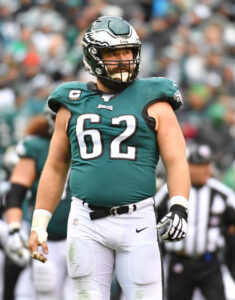 Kelce’s ESPN and Amazon deals will keep him in football fans’ lives for the foreseeable future, but the Eagles will miss a player who turned in one of the greatest after-30 stretches in NFL history. A zero-time All-Pro in his 20s, Kelce retired after collecting six of the past seven first-team honors at center. The Eagles counted on the gregarious presence for leadership purposes, a component that will also be missed for a team that imploded down the stretch last season.
Kelce’s ESPN and Amazon deals will keep him in football fans’ lives for the foreseeable future, but the Eagles will miss a player who turned in one of the greatest after-30 stretches in NFL history. A zero-time All-Pro in his 20s, Kelce retired after collecting six of the past seven first-team honors at center. The Eagles counted on the gregarious presence for leadership purposes, a component that will also be missed for a team that imploded down the stretch last season.
The Tush Push anchor — to the point it is worth wondering how well the Eagles will execute that play henceforth — became one of the greatest centers in NFL history, once boosted McCoy to a rushing title and later helped keep the 2017 squad afloat under Nick Foles. Playing lead roles for two Super Bowl-bound squads, Kelce played lead roles in both Hurts and Carson Wentz securing monster extensions. The Eagles continued to retain Kelce, 37, on a year-to-year basis; how their O-line looks without him will be fascinating to observe.
The Eagles are taking on $8.7MM this year for Kelce’s retirement, processed as a post-June 1 transaction that will see $16.4MM hit Philly’s books in 2025. Cox will count $4.2MM against the Eagles’ 2024 cap and $10.1MM on their ’25 payroll. The interior pillars proved worth this damage during their careers, with Cox spending a period as the NFL’s second-best D-tackle behind Aaron Donald.
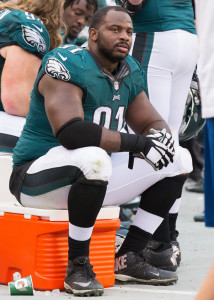 A six-time Pro Bowler, Cox contributed seven sacks to the Eagles’ record-setting push in 2022 and added five in his NFL finale. The Patriots double-teaming Cox on that seminal Super Bowl LII snap gave Graham a one-on-one matchup, leading to the latter’s strip of Tom Brady en route to the team’s conquest. The Eagles have Jordan Davis and Jalen Carter ready for more work, and while Cox (no Pro Bowls since 2020) may not be as difficult to replace as Kelce, this will still be a transition for a team that continued to keep its long-running OL/DL quartet around.
A six-time Pro Bowler, Cox contributed seven sacks to the Eagles’ record-setting push in 2022 and added five in his NFL finale. The Patriots double-teaming Cox on that seminal Super Bowl LII snap gave Graham a one-on-one matchup, leading to the latter’s strip of Tom Brady en route to the team’s conquest. The Eagles have Jordan Davis and Jalen Carter ready for more work, and while Cox (no Pro Bowls since 2020) may not be as difficult to replace as Kelce, this will still be a transition for a team that continued to keep its long-running OL/DL quartet around.
Taking a backseat to Kenneth Gainwell in Week 1 of last season, Swift took the reins quickly and delivered by far his best season. While the Eagles are aiming to use Barkley more as a receiver — as Hurts has not turned to RBs for help much in that department — the Bears probably have the same intentions with Swift, who was more dynamic in Detroit. Behind Philly’s top-shelf O-line, however, Swift amassed 1,049 rushing yards. His odometer reads 788 career touches (to Barkley’s 1,489), but the team is clearly convinced a substantial upgrade is coming.
Trades:
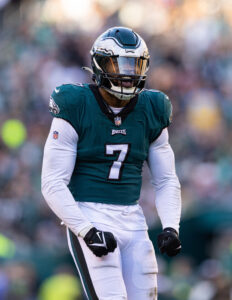 Reddick overdelivered on his three-year, $45MM Eagles deal, combining for 19.5 sacks between the 2022 regular season and playoffs and then adding 11 more last season. While Reddick ranks fourth among 2020s sackers with 50.5, he has never been paid like an elite rusher. That is now the Jets’ problem, after the Eagles landed Huff to team with Sweat. Though, Reddick’s holdout still impacts the Eagles, as the pick becomes a second-rounder if Reddick plays 67.5% of Gang Green’s 2024 snaps and records 10 sacks.
Reddick overdelivered on his three-year, $45MM Eagles deal, combining for 19.5 sacks between the 2022 regular season and playoffs and then adding 11 more last season. While Reddick ranks fourth among 2020s sackers with 50.5, he has never been paid like an elite rusher. That is now the Jets’ problem, after the Eagles landed Huff to team with Sweat. Though, Reddick’s holdout still impacts the Eagles, as the pick becomes a second-rounder if Reddick plays 67.5% of Gang Green’s 2024 snaps and records 10 sacks.
After granting Reddick permission to find a trade — one the Temple alum insisted he did not request — the Eagles tabled Reddick’s $1MM roster bonus to April 1. This all but ensured he would be dealt. The Jets made a low-ball offer before agreeing to trade for him, and he has held out for nearly six weeks.
Pickett faceplanted in Pittsburgh and did not exactly take his demotions for Mason Rudolph or Russell Wilson well. The Eagles will take a risk having him as Hurts’ backup, as the dual-threat starter missed time in 2021 and ’22 (when Gardner Minshew was QB2) and played through a leg injury last season.
 The Eagles made an offer to see about a reunion with Joe Flacco, briefly a Hurts backup in 2021, but the reigning Comeback Player of the Year joined the Colts. Pickett has managed 13 TD passes in 24 starts; two years remain on the former No. 20 overall pick’s rookie contract.
The Eagles made an offer to see about a reunion with Joe Flacco, briefly a Hurts backup in 2021, but the reigning Comeback Player of the Year joined the Colts. Pickett has managed 13 TD passes in 24 starts; two years remain on the former No. 20 overall pick’s rookie contract.
As Brown and Smith have thrived, the team has been unable to find a reliable third wideout. Quez Watkins and Julio Jones were not up to the task, and while Parris Campbell remains in the mix after joining the practice squad, the role may still be up for grabs. Enter Dotson, who returns to Pennsylvania after inconsistency in Washington.
The Penn State alum did not fare as well in Eric Bieniemy‘s offense, clashing with the OC and ranking near the bottom in ESPN’s open score metric in 2023. Two years remain on the former No. 16 pick’s rookie deal, and after two 500-plus-yard seasons with below-average QB play, the Eagles replicated their Pickett trade package to see if a better environment can bring an uptick.
Draft:
- Round 1, No. 22: Quinyon Mitchell (CB, Toledo) (signed)
- Round 2, No. 40 (from Bears through Commanders): Cooper DeJean (CB, Iowa) (signed)
- Round 3, No. 94 (from 49ers): Jalyx Hunt (EDGE, Houston Christian) (signed)
- Round 4, No. 127 (from Eagles): Will Shipley (RB, Clemson) (signed)
- Round 5, No. 152 (from Seahawks through Commanders): Ainias Smith (WR, Texas A&M) (signed)
- Round 5, No. 155 (from Steelers through Rams, Panthers and Colts): Jeremiah Trotter Jr. (LB, Clemson) (signed)
- Round 5, No. 172: Trevor Keegan (G, Michigan) (signed)
- Round 6, No. 185: Johnny Wilson (WR, Florida State) (signed)
- Round 6, No. 190 (from Saints through Packers): Dylan McMahon (C, NC State) (signed)
 The Eagles were the only team to primarily start two 30-somethings at outside cornerback last season. As the pass rush did not get home at the historic rate it did in 2022, the Darius Slay–James Bradberry pair did not play as well. Maddox also missed most of the year. Philly became connected to corners during the draft run-up, and buzz about a trade-up surfaced. The flood of QBs and tackles to come off the board early aided the Eagles, who did not need to climb up for Mitchell.
The Eagles were the only team to primarily start two 30-somethings at outside cornerback last season. As the pass rush did not get home at the historic rate it did in 2022, the Darius Slay–James Bradberry pair did not play as well. Maddox also missed most of the year. Philly became connected to corners during the draft run-up, and buzz about a trade-up surfaced. The flood of QBs and tackles to come off the board early aided the Eagles, who did not need to climb up for Mitchell.
Mitchell led Division I-FBS with 25 passes defensed in 2022, returning two of his five interceptions for touchdowns that year. The mid-major cover man did nothing to drop his stock in 2023, attaining All-American acclaim. Set to team with Slay and the reinstated Isaiah Oliver as starters, Mitchell enters his rookie season with plenty on his plate. The team has the 6-foot CB set for a three-down role, which looks likely to involve base-set boundary work and sub-package slot functions. It will be interesting to see how Mitchell moves from the MAC to a full-time NFL role.
Philadelphia jumped to No. 40 for DeJean, who starred at Iowa before suffering a fractured fibula last season. DeJean joined Mitchell in intercepting five passes in 2022; the Hawkeyes star returned three picks for TDs. Rumors about a move to safety naturally surfaced, as there has not been a white NFL starting corner since 2003. But Fangio confirmed the Eagles view DeJean as a corner. DeJean did not come off the Eagles’ NFI list until mid-August, pointing to a ramp-up period. Rodgers is in place as a potential bridge, giving the Eagles options on the boundary.
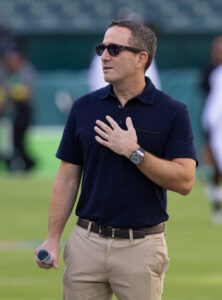 Hunt combined for 13.5 sacks in two seasons at Houston Christian, a Division I-FCS program. The Cornell transfer may not see too much time in 2024, with Graham and Sweat rostered. The Eagles will gauge the small-school product’s readiness, however, and Graham’s retirement and Sweat’s potential free agency exit would stand to open the door to a heavy rotational role behind Bryce Huff and Nolan Smith. Arriving in Philly just 15 years after his father’s Eagles career wrapped, Trotter could be a starter-in-waiting behind the likes of White and Baun.
Hunt combined for 13.5 sacks in two seasons at Houston Christian, a Division I-FCS program. The Cornell transfer may not see too much time in 2024, with Graham and Sweat rostered. The Eagles will gauge the small-school product’s readiness, however, and Graham’s retirement and Sweat’s potential free agency exit would stand to open the door to a heavy rotational role behind Bryce Huff and Nolan Smith. Arriving in Philly just 15 years after his father’s Eagles career wrapped, Trotter could be a starter-in-waiting behind the likes of White and Baun.
Making a record-setting (in the seven-round era) eight draft-weekend trades, Roseman also targeted what is expected to be a deeper 2025 draft by adding third-, fourth- and fifth-round picks via trade-down moves. NIL and the COVID-19 fifth year thinned this class’ talent pool, and the Eagles will have extra ammo — even after already using one of the third-rounders to acquire Dotson — next year.
Other:
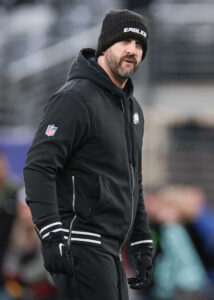 The Eagles’ undoing naturally prompted ownership to seek staff changes. While Doug Pederson did not respond well to such requests after the 2020 season, Sirianni moved on from Johnson and made the expected move to ditch his co-DC setup. It did not appear Sirianni was too close to losing his job, having gone 3-for-3 in playoff berths and nearly pushing the 2022 squad to the mountaintop, but the team showed interest in Bill Belichick after he became a coaching free agent (that interest is mutual). Sirianni is on the hot seat.
The Eagles’ undoing naturally prompted ownership to seek staff changes. While Doug Pederson did not respond well to such requests after the 2020 season, Sirianni moved on from Johnson and made the expected move to ditch his co-DC setup. It did not appear Sirianni was too close to losing his job, having gone 3-for-3 in playoff berths and nearly pushing the 2022 squad to the mountaintop, but the team showed interest in Bill Belichick after he became a coaching free agent (that interest is mutual). Sirianni is on the hot seat.
Chief among Sirianni’s issues, his relationship with Jalen Hurts deteriorated last year. Hurts grew frustrated with the offense’s direction, and as he sought to expand the scheme Sirianni brought with him from Indianapolis, drew hero-ball accusations. Hurts was accused of tuning out his coach — as his INT count spiked to 15 — and Sirianni minimized Johnson’s power to the point confusion existed about the unit’s play-caller. This ended with Johnson booted after one OC season. Hurts’ two-year position coach, whom the QB has known since childhood, dropped off the OC tier this offseason and is now the Commanders’ pass-game coordinator.
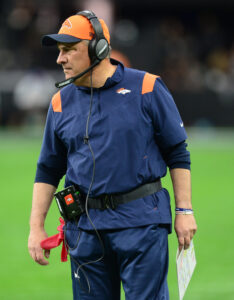 Sirianni and Hurts have attempted to mend fences this year, and the coach has stepped back to give Moore more autonomy than Johnson received. Formerly an HC carousel rider, Moore has the keys to a third team’s offense in three years.
Sirianni and Hurts have attempted to mend fences this year, and the coach has stepped back to give Moore more autonomy than Johnson received. Formerly an HC carousel rider, Moore has the keys to a third team’s offense in three years.
The former Cowboys play-caller drew a bad hand with the Chargers, as Mike Williams and Justin Herbert went down, but he has seen his stock dip since Dallas’ 2021 attack ranked first across the board. Moore has brought much-needed motion concepts, after the Eagles ranked last in 2023 motion usage. Hurts bouncing back would undoubtedly rocket the 35-year-old coordinator back into HC consideration.
Fangio ruffled feathers in Miami, alienating several players during his one-and-done Dolphins DC stay. The AFC East team let the veteran DC out of a contract that paid high-end coordinator money ($4MM-plus), and some Dolphins believed Fangio wanted to be back in Philly last season. The Pennsylvania native took the Miami job before Jonathan Gannon had made it clear he would leave for Arizona, complicating matters for the Eagles, whose defense regressed — dropping to 29th in DVOA — under Desai and Patricia.
Fangio, 66, is one of this era’s top defensive minds. Beginning his pro career as an assistant for the USFL’s Philadelphia Stars 40 years ago, Fangio is aiming to wrap his coaching run with the Eagles.
Top 10 cap charges for 2024:
- Lane Johnson, RT: $15.87MM
- Jalen Hurts, QB: $13.56MM
- A.J. Brown, WR: $11.83MM
- Jordan Mailata, LT: $11.62MM
- Darius Slay, CB: $10.65MM
- Dallas Goedert, TE: $9.13MM
- Brandon Graham, DE: $8.19MM
- DeVonta Smith, WR: $8.13MM
- Josh Sweat, DE: $8.03MM
- Landon Dickerson, LG: $5.99MM
Adding younger pieces in key defensive places and locking in cornerstone offensive talent to go along with last year’s Hurts extension, the Eagles laid out what looks like a better plan this offseason. Fangio and Moore bring far more experience than Philly’s initial post-Gannon/Shane Steichen coordinators carried. Superior parts being in place cranks up the heat on Sirianni.
With the Commanders rebuilding and the Giants clinging to a blueprint most do not believe will work, the Eagles still should have a smoother runway toward an NFC East title. They have traded the crown with the Cowboys for most of the past decade. The NFC still appears shallower than the AFC, and the Eagles will need to capitalize in order to extend Sirianni’s tenure. Hurts moving back on track could well be enough for the team’s CEO head coach, but as Belichick circles the NFC East, the Eagles are set for a pivotal rebound effort as a whole.
By Sam Robinson |
at September 2, 2024 10:01 pm
The Seahawks had been able to keep their operation afloat following the Legion of Boom’s gradual splintering, with Russell Wilson making his best statistical Hall of Fame case between Seattle’s mid-2010s Super Bowl seasons and the 2021 campaign that brought an injury and early decline signs. While Pete Carroll and GM John Schneider did well to cash in on their star quarterback in 2022, the team has not turned those assets into a true contender yet. This ended up costing Carroll his job.
Carroll’s right-hand man for 14 years, Schneider now has the final say. He landed on Mike Macdonald, whose Ravens defense took a leap last season. The Seahawks have gone from the NFL’s oldest HC to its youngest. They will hope Macdonald and his staff can better maximize the resources poured into the team following the Wilson trade.
Coaching/front office:
Carroll piloted the Seahawks to their highest peak — by far — in franchise history. It is difficult to make a strong case against the 2013 Seahawks being that decade’s best team and one of this century’s best squads. The Seahawks became the first team since the 1950s Browns — who obviously played in a much smaller NFL — to lead the league in scoring defense in four straight years. Carroll followed up his successful USC stay by guiding the Hawks to 10 playoff berths in 14 seasons, completing an NFL bounce-back effort after being a Jets one-and-done (1994) and being fired after three Patriots seasons.
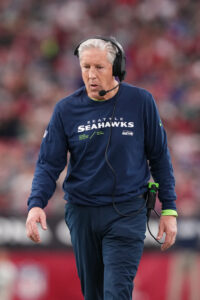 Another case can be made the Seahawks were not the same team once they gave Wilson the first of his three extensions. The Seahawks made the playoffs five times from 2015-20. They won three wild-card games in that span, but they partially benefited from Blair Walsh‘s 27-yard missed field goal (2015) and Carson Wentz sustaining an early concussion (2019). The Lions team they topped in 2016 also ranked 27th in DVOA. This is not to say those Seahawk editions were not worthy playoff squads, but the franchise’s post-Super Bowl XLIX period saw regular check-ins as a second-tier contender. No conference championship appearances have followed since the infamous Marshawn Lynch “what if?”
Another case can be made the Seahawks were not the same team once they gave Wilson the first of his three extensions. The Seahawks made the playoffs five times from 2015-20. They won three wild-card games in that span, but they partially benefited from Blair Walsh‘s 27-yard missed field goal (2015) and Carson Wentz sustaining an early concussion (2019). The Lions team they topped in 2016 also ranked 27th in DVOA. This is not to say those Seahawk editions were not worthy playoff squads, but the franchise’s post-Super Bowl XLIX period saw regular check-ins as a second-tier contender. No conference championship appearances have followed since the infamous Marshawn Lynch “what if?”
Carroll also had to battle age (73 in September) and a new owner (Jody Allen) being in place from when he was hired. While Schneider stayed on and will control Seattle’s 53-man roster, the 15th-year GM will be on the clock if the Seahawks cannot mount a true charge in the near future. They again went in a defensive direction. After initial rumors connected ex-Carroll assistant Dan Quinn to the job, the three-year Cowboys DC was deemed to have been too close to the Carroll setup for team brass’ comfort. Macdonald, 36, became the pick — after a bidding war against the Commanders.
Washington ended up hiring Quinn, but he may well have been the organization’s third choice. The Commanders appeared to covet Lions OC Ben Johnson, and they then pivoted to Macdonald. After Johnson turned them down, the Commanders offered the job to Macdonald. The two-year Ravens DC also was viewed by some as Washington’s top choice. In competing with Washington, Seattle came in with the winning offer. The Commanders’ Macdonald pursuit led to the Seahawks offering a six-year contract. HC contracts are guaranteed, and while Dan Campbell and Dave Canales were two first-timers who received six-year deals during the 2020s (with Matt Rhule landing a seven-year accord), four- or five-year deals are standard NFL practice. Intent on landing their top choice, the Seahawks paid up.
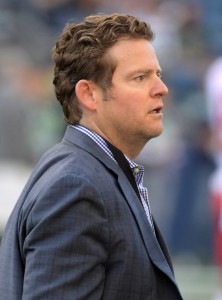 Carroll had tried to keep the job, but a report also suggested he had made midseason comments about retirement. Carroll’s specialty, Seattle’s defense proved a letdown during the team’s second straight 9-8 season. Struggling in particular against the run, Carroll and Clint Hurtt‘s unit ranked 25th in scoring and 28th in DVOA. Enter Macdonald, who coaxed the Ravens to a No. 1 defensive ranking despite late-summer (Jadeveon Clowney) or in-season (Kyle Van Noy) additions in place as the team’s top edge rushers. Baltimore led the league in defensive DVOA, and the ex-Jim Harbaugh Michigan DC received an early chance at a top NFL job.
Carroll had tried to keep the job, but a report also suggested he had made midseason comments about retirement. Carroll’s specialty, Seattle’s defense proved a letdown during the team’s second straight 9-8 season. Struggling in particular against the run, Carroll and Clint Hurtt‘s unit ranked 25th in scoring and 28th in DVOA. Enter Macdonald, who coaxed the Ravens to a No. 1 defensive ranking despite late-summer (Jadeveon Clowney) or in-season (Kyle Van Noy) additions in place as the team’s top edge rushers. Baltimore led the league in defensive DVOA, and the ex-Jim Harbaugh Michigan DC received an early chance at a top NFL job.
The Seahawks did not block contracted assistants from pursuing other gigs during the period between Carroll and Macdonald, and OC Shane Waldron joined the Bears. Waldron perhaps has not received sufficient credit for Geno Smith‘s stunning 2022 turnaround, with Canales — Seattle’s QBs coach in 2022 — seeing more praise. While Hurtt was not on the DC radar — he is back with Vic Fangio coaching the Eagles’ D-line — Waldron interviewed with multiple teams.
Seattle’s offense plummeted from ninth to 17th in scoring from 2022-23, with Smith taking a slight step back. Macdonald, whom the Giants blocked from interviewing Mike Kafka (also a Seahawks HC candidate), went off the board in an effort to shape his first offense.
No other teams were connected to Grubb, a career-long college assistant who only brings two years of Power 5 experience. Formerly Fresno State’s OC from 2019-21, Grubb played a central role in powering Washington to the 2023 CFP national title game. Michael Penix Jr. owes some of his elevated draft stock — after an injury-plagued Indiana tenure — to Grubb, whose offense produced Division I-FBS’ passing and receiving leaders (Penix, Rome Odunze). This combo boosted the Huskies to the brink of a national title, after the then-Pac-12 program had not played for one since 1991. Grubb, 48, had agreed to follow Kalen DeBoer to Alabama but ended up viewing this Seahawks offer as a better opportunity.
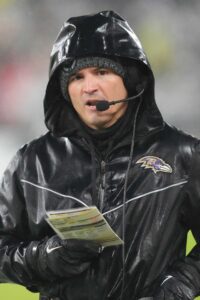 Schematic changes will be evident immediately in Seattle, and it will be interesting to see how Smith looks in Grubb’s offense. Macdonald kept the Ravens’ long-running 3-4 scheme in place but hired Durde, who had served as the Cowboys’ D-line coach under Quinn. Durde joined Macdonald as an in-demand candidate. The Falcons, Rams and Packers requested meetings, and the Cowboys interviewed him for their DC post — one that ended up going to Mike Zimmer — after the Commanders poached Joe Whitt. Macdonald also considered ex-Ravens coworker Zach Orr, but he received a Baltimore promotion.
Schematic changes will be evident immediately in Seattle, and it will be interesting to see how Smith looks in Grubb’s offense. Macdonald kept the Ravens’ long-running 3-4 scheme in place but hired Durde, who had served as the Cowboys’ D-line coach under Quinn. Durde joined Macdonald as an in-demand candidate. The Falcons, Rams and Packers requested meetings, and the Cowboys interviewed him for their DC post — one that ended up going to Mike Zimmer — after the Commanders poached Joe Whitt. Macdonald also considered ex-Ravens coworker Zach Orr, but he received a Baltimore promotion.
Durde, who is English, coached the sport in London for nearly a decade before landing on Quinn’s Falcons staff. As Micah Parsons has shifted to a full-time pass rusher, Durde coached the star talent in a scheme that kept the All-Pro roving around formations. A former Macdonald Ravens mentor, Frazier is back after a 2023 sabbatical. The Bills employed the former Vikings HC as their defensive coordinator for six seasons, but Sean McDermott separated from his previous play-caller in 2023. Frazier’s presence figures to be important on a staff with a first-time HC and rookie DC.
Re-signings:
 The Seahawks sent the Giants second- and fifth-round picks for Williams at the 2023 deadline. Hours after the Giants then sent second- and fifth-rounders for Brian Burns, the Seahawks did not let the asset they had acquired leave. Williams is back in the fold, representing a shift for a Seahawks team that continues to invest along the D-line after previously not devoting substantial resources — at least, not until the 2023 Dre’Mont Jones signing — to interior defensive linemen. Jones has since been working on the edge, even after spending five seasons as an interior rusher. Through that lens, the Seahawks have an inside-outside rush combo each on contracts north of $17MM per year.
The Seahawks sent the Giants second- and fifth-round picks for Williams at the 2023 deadline. Hours after the Giants then sent second- and fifth-rounders for Brian Burns, the Seahawks did not let the asset they had acquired leave. Williams is back in the fold, representing a shift for a Seahawks team that continues to invest along the D-line after previously not devoting substantial resources — at least, not until the 2023 Dre’Mont Jones signing — to interior defensive linemen. Jones has since been working on the edge, even after spending five seasons as an interior rusher. Through that lens, the Seahawks have an inside-outside rush combo each on contracts north of $17MM per year.
After not quite living up to his No. 6 overall draft slot as a Jet, Williams has made a habit of timing his resurgences well. On the franchise tag in 2020, the USC product produced 11.5 sacks — far and away a career high — and commanded one of this era’s most player-friendly deals for a defender shortly after the March 2021 franchise tag application deadline (three years, $63MM, $45MM fully guaranteed). Williams did not come close to those 2020 numbers in 2021 or ’22, but upon being dealt to the Seahawks, he posted four sacks and 11 QB hits in 10 games.
Williams, 30, did not help a Seattle run defense that ranked 30th, but Macdonald will plug him into his defense. This could be a good sign for the 10th-year player, as Macdonald just coaxed a dominant season from Ravens DT Justin Madubuike. Williams has an extensive track record as a quality run defender, though his best work on that front came back in his Jets days.
 Fant joined Williams in hitting the market. Early deals for Dalton Schultz and Hunter Henry helped the 2019 first-round pick, but his Seahawks usage did not create an extensive bidding war. Fant drew 93- and 90-target seasons during his final two Broncos years; after seeing 63 looks in his Seahawks debut, the Iowa product commanded a paltry 43 last season. After 670- and 673-yard showings in offenses with sub-average QB play in Denver, Fant has stalled out in Seattle. This contract, however, would appear to show the team agrees a production uptick should be expected.
Fant joined Williams in hitting the market. Early deals for Dalton Schultz and Hunter Henry helped the 2019 first-round pick, but his Seahawks usage did not create an extensive bidding war. Fant drew 93- and 90-target seasons during his final two Broncos years; after seeing 63 looks in his Seahawks debut, the Iowa product commanded a paltry 43 last season. After 670- and 673-yard showings in offenses with sub-average QB play in Denver, Fant has stalled out in Seattle. This contract, however, would appear to show the team agrees a production uptick should be expected.
The former No. 20 overall pick is the only player in Seahawks history to see his fifth-year option exercised, which is interesting due to his status as a Broncos draft choice. While Fant is unlikely to flirt with numbers ex-Iowa teammate T.J. Hockenson has put up as a pro, Grubb unlocking him could prove a gateway to a higher tier for Seattle’s offense.
Free agency additions:
- Rayshawn Jenkins, RB. Two years, $12MM ($6.26MM guaranteed)
- Jerome Baker, LB. One year, $7MM ($6.02MM guaranteed)
- George Fant, T. Two years, $9.1MM ($4.7MM guaranteed)
- Connor Williams, C. One year, $4MM ($2.98MM guaranteed)
- Pharaoh Brown, TE. One year, $3.2MM ($2.69MM guaranteed)
- Laviska Shenault, WR. One year, $1.29MM ($1.15MM guaranteed)
- Tyrel Dodson, LB. One year, $4.62MM ($1MM guaranteed)
- Laken Tomlinson, G. One year, $1.2MM ($500K guaranteed)
- Johnathan Hankins, DT. One year, $2.1MM ($300K guaranteed)
- K’Von Wallace, CB. One year, $1.5MM ($205K guaranteed)
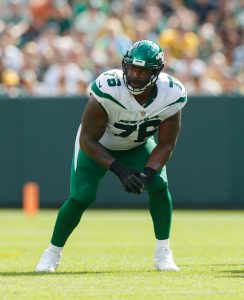 AFC East fans will recognize several players in this year’s Seahawks starting lineup. Most of the main additions come from that division.
AFC East fans will recognize several players in this year’s Seahawks starting lineup. Most of the main additions come from that division.
Last year’s Seahawks O-line underwhelmed in terms of performance and health, and the team’s 2024 offering is not off to a great start. Abraham Lucas is again set for an injury-driven absence. Offseason knee surgery, after the right tackle starter missed 11 games last season, led to a reserve/PUP list designation. The Seahawks will become the latest team to call on George Fant, who has begun to make a career of RT fill-in duty.
Fant, 32, never worked as a full-time Seahawks starter during his first stint. He still parlayed that tenure into a three-year, $27.3MM Jets deal. After being a three-year Jets starter, Fant subbed for the Texans by playing 874 RT snaps last year. Lucas’ injury history has become a concern, and the Seahawks did well to bring back their one-time basketball convert for key spot duty.
Seattle landed Williams at a discount, finishing a lengthy recruiting process after the seventh-year vet made a Ravens visit. If he plays to his Dolphins form, the team will need to prepare a big raise in order to keep the former second-rounder beyond 2024.
Read more
Williams, 27, angled for an adjustment on his two-year, $14MM Miami contract in 2023 but could not secure any upgrade. He suffered a torn ACL months later, crushing his market during a year in which a center with a worse track record — Denver’s Lloyd Cushenberry — scored $26MM guaranteed at signing. PFF rated Williams as the league’s fourth- and second-best center in 2022 and 2023, respectively, lauding the ex-Cowboys guard’s run-game work last year. He stands to be a big upgrade on Evan Brown.
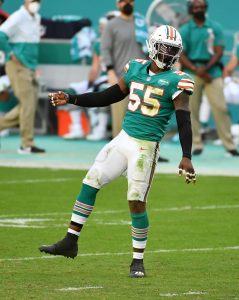 Keeping some ammo for 2025 compensatory picks, the Seahawks added two street free agents — in Jenkins and Baker — to start on defense. Jenkins will join Julian Love as a lower-cost solution compared to Jamal Adams and Quandre Diggs, while Macdonald started over at linebacker. Dodson is coming off his best season. Jenkins, 30, started every Jaguars game he played (48). After a memorable 2022 that included three INTs, three forced fumbles and a walk-off pick-six on Dak Prescott, Jenkins became expendable for a retooling Jags team. PFF ranked him 70th at safety in 2023.
Keeping some ammo for 2025 compensatory picks, the Seahawks added two street free agents — in Jenkins and Baker — to start on defense. Jenkins will join Julian Love as a lower-cost solution compared to Jamal Adams and Quandre Diggs, while Macdonald started over at linebacker. Dodson is coming off his best season. Jenkins, 30, started every Jaguars game he played (48). After a memorable 2022 that included three INTs, three forced fumbles and a walk-off pick-six on Dak Prescott, Jenkins became expendable for a retooling Jags team. PFF ranked him 70th at safety in 2023.
The Dolphins had extended Baker on a three-year, $37.5MM deal but did so during Brian Flores‘ final season in charge. The Dolphins also encountered significant cap issues this offseason, leading to cap cuts and both Christian Wilkins and Robert Hunt moving on. Baker has been an effective blitzer from his off-ball spot, delivering a near-Demario Davis-like 22.5 sacks in six seasons.
PFF graded Dodson incredibly well, slotting him first among all off-ball LBs. His modest contract shows teams did not agree. The advanced metrics website viewed the ex-Bills defender — a former UDFA who did not see much action from 2020-22 — as a strong coverage ‘backer. A number of NFL staffers expected Macdonald to bring Patrick Queen with him to the Pacific Northwest, but the 2023 Pro Bowler headed to Pittsburgh. The result still produced an interesting LB duo, even if Dodson and Baker may well be stopgaps while Macdonald charts a bigger-picture course.
The Jets cut Tomlinson, whom the Seahawks have at a vet-minimum rate (plus incentives). Cody Whitehair, Greg Van Roten and Lucas Patrick also emerged on Seattle’s radar, as they left the draft with a clear guard need. Tomlinson, who started for five straight 49ers teams and back-to-back Jets squads, will head into his age-32 season. A durable blocker who received better reviews under Kyle Shanahan, Tomlinson has missed just one game since the Lions traded him in 2017. PFF was lukewarm on Jets Tomlinson, ranking him 53rd in 2023. He will replace Damien Lewis at left guard, with Anthony Bradford — Phil Haynes‘ 2023 injury replacement — taking over at RG.
Notable losses:
- Jamal Adams, S (released)
- Nick Bellore, LB (released)
- Evan Brown, C
- Jordyn Brooks, LB
- Devin Bush, LB
- DeeJay Dallas, RB
- Quandre Diggs, S (released)
- Will Dissly, TE (released)
- Mario Edwards, DL
- Dee Eskridge, WR (waived)
- Phil Haynes, G
- Damien Lewis, G
- Drew Lock, QB
- Bryan Mone, DL (released)
- Colby Parkinson, TE
- Bobby Wagner, LB
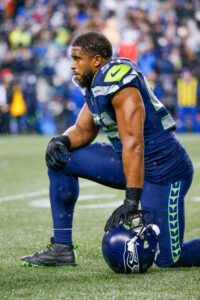 For a second time in three offseasons, Wagner left Seattle. Already solidifying himself as one of the best off-ball linebackers in NFL history, Wagner remained at a high level during his second Seahawks stint. Wagner led the NFL in tackles at age 33, with 183, and strolled to yet another All-Pro accolade. The 2012 second-round pick has earned first- or second-team All-Pro acclaim in 10 straight years. All due respect to Cortez Kennedy, Wagner has made a good claim for being the greatest Seahawks defender. Wagner’s exit (again) separates the franchise from anyone who played for either Super Bowl squad.
For a second time in three offseasons, Wagner left Seattle. Already solidifying himself as one of the best off-ball linebackers in NFL history, Wagner remained at a high level during his second Seahawks stint. Wagner led the NFL in tackles at age 33, with 183, and strolled to yet another All-Pro accolade. The 2012 second-round pick has earned first- or second-team All-Pro acclaim in 10 straight years. All due respect to Cortez Kennedy, Wagner has made a good claim for being the greatest Seahawks defender. Wagner’s exit (again) separates the franchise from anyone who played for either Super Bowl squad.
The Wagner-Brooks duo had played together as three-down ‘backers in 2021, and while the younger defender had wanted to stay in Seattle, Wagner — who had signed a one-year deal to return — viewed a return as unlikely. Completing a Wagner-Dan Quinn reunion, the Commanders gave Wagner a one-year deal worth $6.5MM. Wagner’s rookie-contract ascent came under Quinn’s guidance as DC.
Brooks joined one of Macdonald’s former Ravens colleagues, agreeing to a three-year, $26.25MM Dolphins deal to work as a three-down player under new Dolphins DC Anthony Weaver. Only $9.5MM of Brooks’ deal is guaranteed at signing, which obviously pales in comparison to what Wagner fetched on his second contract back in 2015. The Seahawks did not pick up Brooks’ fifth-year option in 2023.
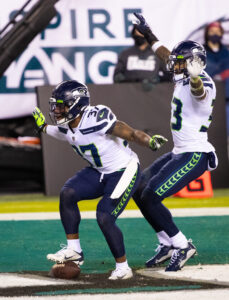 The Seahawks cashed out on Wilson at the right time; the move, however, came barely 18 months after the team sent the Jets two first-round picks for a box safety. The Seahawks doubled down on Adams with a contract that at the time made him the NFL’s highest-paid safety by a wide margin. The Seahawks are eating $20.83MM from the Adams cut. Diggs’ release added $10.3MM in dead cap. The team is taking on all of the money this year, opting against a post-June 1 cut for either safety.
The Seahawks cashed out on Wilson at the right time; the move, however, came barely 18 months after the team sent the Jets two first-round picks for a box safety. The Seahawks doubled down on Adams with a contract that at the time made him the NFL’s highest-paid safety by a wide margin. The Seahawks are eating $20.83MM from the Adams cut. Diggs’ release added $10.3MM in dead cap. The team is taking on all of the money this year, opting against a post-June 1 cut for either safety.
Adams is still just 28, but he missed 33 games in four Seahawks seasons. Although Adams set the record for sacks by a DB — with 9.5 in 2021 and parlayed that into his $17.65MM-per-year extension — this was among the Schneider-Carroll era’s top misfires, reminding of the Percy Harvin whiff. The Diggs trade went much better. Seattle only sent Detroit a fifth-round pick for Diggs — during a five-month span that featured the Lions trading the ascending safety and Darius Slay — and Diggs was named a Pro Bowl starter each year from 2020-22. Better equipped to defend modern passing attacks compared to Adams, Diggs intercepted 18 passes as a Seahawk.
The pair reunited in Tennessee, Diggs receiving a one-year, $3MM deal and Adams a one-year, $1.29MM pact. The effective blitzer/coverage liability discussed staying in Seattle on a new contract following his release, but no agreement emerged. Adams said the Seahawks asked him to convert to linebacker.
 Included on PFR’s top 50 free agent list, Lewis flew under the radar on a stacked guard market. The four-year Seattle starter commanded a deal well into eight-figure AAV territory, signing a four-year, $52MM Panthers pact. Lewis overlapped with Canales in Seattle. The 2020 third-round pick became a set-it-and-forget-it option at left guard for the Seahawks, missing only six starts in four seasons. As they did at linebacker, the Seahawks opted to let their starters walk and keep costs low at guard.
Included on PFR’s top 50 free agent list, Lewis flew under the radar on a stacked guard market. The four-year Seattle starter commanded a deal well into eight-figure AAV territory, signing a four-year, $52MM Panthers pact. Lewis overlapped with Canales in Seattle. The 2020 third-round pick became a set-it-and-forget-it option at left guard for the Seahawks, missing only six starts in four seasons. As they did at linebacker, the Seahawks opted to let their starters walk and keep costs low at guard.
Despite Lock failing to beat out Smith in 2022, he re-signed last year. The Seahawks needed him to start in 2023, and while he did come off the bench to help key an upset win over the Eagles, that defense’s deterioration gradually minimized that accomplishment. The Seahawks blew a nine-point lead to the Rams after Smith left in the Week 11 matchup’s fourth quarter. Schneider also stirred the pot this offseason, indicating Lock joined the Giants because he would have a chance to compete for a starting job. Giants brass repeatedly pushed back on that, but Daniel Jones‘ 2025 injury guarantee opens the door to Lock seeing time down the stretch.
Trades:
None of Seattle’s five trades involved starters, but the volume in Schneider’s first offseason in charge was notable. Howell comes over after a 17-start season. Both the teams that made questionable decisions in handing the keys to 2022 QB draftees during the ’23 offseason, the Commanders and Falcons traded these players (Howell, Desmond Ridder) on the same day in March. The Cardinals traded wideout Rondale Moore for Ridder; the Seahawks’ Howell trade resembled the Eagles’ Kenny Pickett swap. Both involved a third-round pick, with other selections coming back. One starter has come out of the maligned 2022 QB class — Brock Purdy — while Pickett, Ridder, Howell and Malik Willis have been dealt.
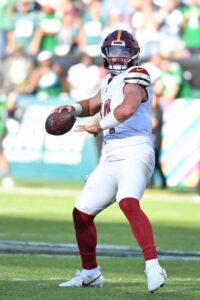 The Seahawks beat out three teams for Howell, however. Only David Carr took more sacks than Howell’s 65 in a season this century, and the embattled starter threw an NFL-high 21 interceptions — the most of any passer this decade. Despite finishing with a league-high 612 attempts, Howell did not reach 4,000 yards. Two years remain on the Drake Maye North Carolina predecessor’s rookie contract.
The Seahawks beat out three teams for Howell, however. Only David Carr took more sacks than Howell’s 65 in a season this century, and the embattled starter threw an NFL-high 21 interceptions — the most of any passer this decade. Despite finishing with a league-high 612 attempts, Howell did not reach 4,000 yards. Two years remain on the Drake Maye North Carolina predecessor’s rookie contract.
The Taylor trade occurred hours before Uchenna Nwosu‘s MCL injury. Following the top Seattle edge rusher’s latest injury setback, the team flipped a 2025 sixth-rounder for Gipson after acquiring one from the Bears for Taylor. Seattle had seen flashes from Taylor, who ripped off a 9.5-sack 2022 and totaled 21.5 sacks in three seasons. Gipson’s resume does not match the former second-rounder’s; the ex-Bears draftee has 11 sacks in four seasons. Only four of those have come since 2022.
Nwosu, who missed much of last season with a pec injury, avoided IR and should be back early in the season. Gipson will vie for time in an edge group that includes Jones, Boye Mafe and fellow ex-second-rounder Derick Hall.
Draft:
- Round 1, No. 16: Byron Murphy (DT, Texas) (signed)
- Round 3, No. 81 (from Saints through Broncos): Christian Haynes (G, UConn) (signed)
- Round 4, No. 118: Tyrice Knight (LB, UTEP) (signed)
- Round 4, No. 121 (from Dolphins through Broncos): AJ Barner (TE, Michigan) (signed)
- Round 5, No. 136 (from Panthers through Browns and Broncos): Nehemiah Pritchett (CB, Auburn) (signed)
- Round 6, No. 179 (from Commanders): Sataoa Laumea (G, Utah) (signed)
- Round 6, No. 192: DJ James (CB, Auburn) (signed)
- Round 6, No. 207 (from 49ers through Broncos): Michael Jerrell (T, Findlay) (signed)
Joining the Colts as a chief beneficiary of the draft’s quarterback- and tackle-heavy start, the Seahawks landed a top-tier defensive prospect at 16. Seattle had emerged as the Murphy floor weeks before the draft, and a year after Carroll had signed off on Jalen Carter (only to see others in the building express concerns), the team added its D-tackle piece. Murphy is the first interior D-lineman the Seahawks have chosen in Round 1 since well before the Carroll-Schneider era (Marcus Tubbs, 2004).
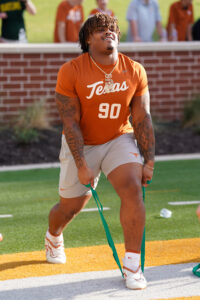 While stout at just over 6-feet tall, Murphy makes up for a lack of ideal size with impressive leverage and power off the snap. His high motor and determination make him a disruptive menace. Playing alongside Titans second-round pick T’Vondre Sweat on Texas’ D-line, Murphy totaled five sacks and 8.5 tackles for loss last season. A number of teams attempted to trade into the Seahawks’ No. 16 slot, but Schneider — a known trade-down buff — passed and added this draft’s top interior D-line prospect.
While stout at just over 6-feet tall, Murphy makes up for a lack of ideal size with impressive leverage and power off the snap. His high motor and determination make him a disruptive menace. Playing alongside Titans second-round pick T’Vondre Sweat on Texas’ D-line, Murphy totaled five sacks and 8.5 tackles for loss last season. A number of teams attempted to trade into the Seahawks’ No. 16 slot, but Schneider — a known trade-down buff — passed and added this draft’s top interior D-line prospect.
Jones being set to see time on the edge opens up a spot for Murphy on Seattle’s front, with Williams and Jarran Reed in place alongside the intriguing prospect — who had drawn top-10 buzz at points ahead of the draft. Though, the team may well begin the rookie as a high-ceiling rotational piece due to having signed veteran run stuffer Johnathan Hankins. The Seahawks were also interested in trading up for JC Latham, calling into question this regime’s belief Abraham Lucas can stay healthy, but they stuck at 16 and chose a player they deemed this draft’s best defensive prospect.
Not moving into Seattle’s starting lineup yet, Haynes should be expected to do so at some point. The UConn alum only has stopgaps blocking his path. Despite playing at a mid-major program (UConn’s football team qualifies as such), Haynes earned All-American acclaim in back-to-back years. He started at guard during his final two seasons with the Huskies. For now, Haynes is stationed behind Tomlinson and Bradford; the Seahawks will hope he can move into the lineup soon.
Extensions and restructures:
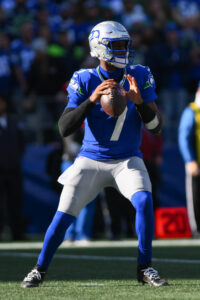 Seattle restructuring Smith’s deal makes the resurgent quarterback harder to move on from, inflating his 2025 cap hit (to $38.5MM). But the team could still do so fairly easily — for just $13.5MM. The Seahawks guaranteed Smith’s $12.7MM 2024 base salary by keeping him on the team in mid-February, and Macdonald endorsed the 12th-year vet as his starter early in the offseason. But Smith’s pursuit of an extension looks to have failed — to the point Schneider said talks did not occur. Smith, 34 in October, looks to be auditioning for his new coaching staff this season.
Seattle restructuring Smith’s deal makes the resurgent quarterback harder to move on from, inflating his 2025 cap hit (to $38.5MM). But the team could still do so fairly easily — for just $13.5MM. The Seahawks guaranteed Smith’s $12.7MM 2024 base salary by keeping him on the team in mid-February, and Macdonald endorsed the 12th-year vet as his starter early in the offseason. But Smith’s pursuit of an extension looks to have failed — to the point Schneider said talks did not occur. Smith, 34 in October, looks to be auditioning for his new coaching staff this season.
An aim at better terms is understandable for Smith, who spent his prime earning years as a backup. The age-32 breakthrough came on a $3.5MM salary, and while it did secure him a three-year, $75MM deal, that contract sits in no-man’s land as a lower-middle-class QB1 deal. The closest players to Smith — the NFL’s 20th-highest-paid QB — are Gardner Minshew ($12.5MM per year) and Baker Mayfield ($33.3MM AAV).
The window is closing for the former Jets draftee to score a deal closer toward at least the upper middle class at his position, but with the Seahawks having him on this team-friendly accord through the 2025 season, it is unsurprising they are taking their time to gauge his fit in Grubb’s offense.
 Seattle was linked to Anthony Richardson in 2023 and had a natural tie to Penix this year due to Grubb. The team also met with Bo Nix. The lack of QB investments keeps Smith’s standing secure, and his place in Grubb’s offense intrigues. But the Seahawks have a mid-30-something at quarterback. Smith could buy the team time, as scouts are down on the 2025 QB class, but the Seahawks will likely continue to be tied to college arms.
Seattle was linked to Anthony Richardson in 2023 and had a natural tie to Penix this year due to Grubb. The team also met with Bo Nix. The lack of QB investments keeps Smith’s standing secure, and his place in Grubb’s offense intrigues. But the Seahawks have a mid-30-something at quarterback. Smith could buy the team time, as scouts are down on the 2025 QB class, but the Seahawks will likely continue to be tied to college arms.
The Seahawks added Love on a midlevel deal amid Adams’ injury uncertainty, but after cleaning house at the position, the team recommitted to the ex-Giants starter. At 26, Love is five years younger than Diggs and three years Adams’ junior. Love followed his high-usage Giants contract year with a solid Seahawks debut. PFF ranked him as a top-12 safety in coverage and as a blitzer. Love tallied a career-high 10 passes defensed in 2023, and he enters this season as the NFL’s 11th-highest-paid safety. That is well north of his standing on the two-year, $12MM deal he inked last March.
Top 10 cap charges for 2024:
- Geno Smith, QB: $26.4MM
- D.K. Metcalf, WR: $24.5MM
- Tyler Lockett, WR: $18.89MM
- Dre’Mont Jones, DL: $10.77MM
- Leonard Williams, DL: $10.4MM
- Uchenna Nwosu, OLB: $7.81MM
- Noah Fant TE: $7.5MM
- Devon Witherspoon, CB: $7.24MM
- Jerome Baker, LB: $6.77MM
- Julian Love, S: $6.5MM
A strong supporting cast still backs Smith, with the Metcalf-Tyler Lockett duo in its sixth season and Jaxon Smith-Njigba gaining steam as his rookie year progressed. Ken Walker also looms as a bounce-back candidate, after running behind PFF’s 28th-ranked O-line in 2023. The pieces seem to be in place for Seattle, though that was deemed the case in 2023 as well.
In terms of rosters inherited, Macdonald probably takes over the best setup among this year’s eight new HCs. He does begin in a strong NFC West, which features a rejuvenated Rams squad and a 49ers outfit that has been this decade’s top NFC club on the whole. Toppling San Francisco in the division will not be easy, but Macdonald’s team should have an opportunity to threaten the NFC’s California teams and hold their own in the conference’s wild-card chase. More will be expected beyond 2024, but the Seahawks have a clear rebound opportunity this season.
By Ben Levine |
at September 2, 2024 9:45 pm
After hitting on three foundational pieces in Sauce Gardner, Garrett Wilson, and Breece Hall during the 2022 draft, the Jets were ready to contend in 2023. The organization immediately addressed its QB woes, bringing Aaron Rodgers (and friends) to New York last offseason. Despite not having put together a winning season since 2015, optimism was unusually high among the Gang Green faithful.
We all know what happened next. Rodgers suffered a season-ending injury after only four offensive snaps, and the Jets once again had to deal with dismal quarterback play throughout the 2023 campaign. Despite Zach Wilson‘s best worst efforts, the Jets admirably stumbled to seven wins.
Considering the Jets’ all-in approach, 2023 was undoubtedly a lost season. Fortunately, it wasn’t all lost in New York. The organization was still able to identify some key roster holes, and it used the 2024 offseason to act accordingly. By adding key players via free agency and the draft, the Jets may have set themselves up for even more success than envisioned a year ago.
Coaching/front office:
- Retained head coach Robert Saleh, GM Joe Douglas
- Parted ways with assistant GM Rex Hogan
Thanks to the efforts of head coach Robert Saleh and general manager Joe Douglas, there would have been optimism heading into 2023 even if the Jets hadn’t acquired a future Hall of Fame quarterback. Unfortunately, the team’s offensive improvements proved short-lived, and the Jets’ 7-10 record in 2023 was once again a reflection of the offense.
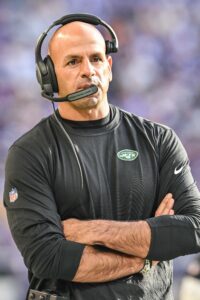 With the organization again failing to make the playoffs, both the head coach and the GM found themselves on the hot seat. Of course, even the most basic context would indicate that 2023’s failures couldn’t entirely be attributed on the duo, and Woody Johnson seemed to share that sentiment when he announced that he’d retain his HC/GM tandem. Reports of paranoia from within the organization hint that there could be cracks in the foundation, but ownership is willing to give the franchise architectures at least one more shot (this time with a healthy Aaron Rodgers).
With the organization again failing to make the playoffs, both the head coach and the GM found themselves on the hot seat. Of course, even the most basic context would indicate that 2023’s failures couldn’t entirely be attributed on the duo, and Woody Johnson seemed to share that sentiment when he announced that he’d retain his HC/GM tandem. Reports of paranoia from within the organization hint that there could be cracks in the foundation, but ownership is willing to give the franchise architectures at least one more shot (this time with a healthy Aaron Rodgers).
One storyline to watch in 2024 will surround the handling of offensive coordinator Nathaniel Hackett. Following a failed stint as the Broncos’ head coach, the former Packers OC teamed up with Rodgers again for the 2023 campaign. When the franchise QB went down, Hackett faced a lot of the blame for the Jets’ offensive inadequacies, leading Saleh to explore a hire to whom Hackett would cede at least some authority. No hire emerged, and while Rodgers again vouched for the embattled OC, Hackett certainly joins the other central Jets decision-makers on the hot seat.
Extensions and restructures:
C.J. Mosley did not have the best start in New York after inking a then-record-setting five-year, $85MM deal in 2019, but the former Ravens draftee has since reclaimed his place as one of the NFL’s top linebackers. With no guaranteed money remaining on the player’s contract, the Jets committed fully to the linebacker for the 2024 campaign while also providing an option for 2025. Of course, this brought a reduction in AAV from Mosley’s previous $17MM-per-year number. He was not the only accomplished linebacker to accept a salary reduction in exchange for guarantees; the Jaguars proceeded this way with Foye Oluokun as well.
Mosley has strung together back-to-back 150-plus-tackle slates and collected his first All-Pro honor — a second-team selection — in 2022. Thanks to the offseason extension, he’ll continue to roll in a high-end tandem with Quincy Williams for at least one more season.
Trades:
 The Jets appeared to have it all figured out when they acquired Haason Reddick from the Eagles. The organization had just let Bryce Huff walk to Philly on a lucrative deal, and with Reddick no longer in the Eagles’ plans, the Jets swooped in and acquired the veteran. Unfortunately, Reddick decided to play hardball in pursuit of a contract extension, leading to one of the organization’s biggest offseason headaches in recent years.
The Jets appeared to have it all figured out when they acquired Haason Reddick from the Eagles. The organization had just let Bryce Huff walk to Philly on a lucrative deal, and with Reddick no longer in the Eagles’ plans, the Jets swooped in and acquired the veteran. Unfortunately, Reddick decided to play hardball in pursuit of a contract extension, leading to one of the organization’s biggest offseason headaches in recent years.
The impending free agent still has not reported to his new squad, and considering the Jets’ refusal to negotiate until Reddick actually shows up to team facilities, it is seeming increasingly likely that the holdout will extend into the regular season.
A two-time Pro Bowler who has compiled the fourth-most sacks during the 2020s (50.5) recently took the drastic step of requesting a trade out of New York, but the Jets would be hard-pressed to find a suitor considering the player’s contract demands.
Reddick, 30 this month, has sought a deal in the $25-$28MM-per-year range, while the Jets offered him a below-market number before acquiring him via trade. Reddick had expected the Jets to revisit extension talks, but the team wanted to gauge his fit first. This led to a staredown and the eventual trade request. The Jets were rumored to be ready to adapt Reddick’s 2024 earnings via sweeteners, but the linebacker is seeking term on any extension. Usually we’d wait until one side blinks, but it sounds like neither a stubborn Reddick nor a stubborn Jets front office are willing to relent.
 The Jets were not done making trades, with the organization finally ripping off the human-sized Band-Aid that was quarterback Zach Wilson. There was once hope that the former No. 2 overall pick would help lead a rebuilt Jets squad to the promised land. After struggling as a rookie and failing as a sophomore, the Jets pivoted to veteran Aaron Rodgers as their new QB savior. Still, the organization was confident that Wilson could be a future contributor while learning under Rodgers’ tutelage. Instead, Wilson was thrust right back into the lineup.
The Jets were not done making trades, with the organization finally ripping off the human-sized Band-Aid that was quarterback Zach Wilson. There was once hope that the former No. 2 overall pick would help lead a rebuilt Jets squad to the promised land. After struggling as a rookie and failing as a sophomore, the Jets pivoted to veteran Aaron Rodgers as their new QB savior. Still, the organization was confident that Wilson could be a future contributor while learning under Rodgers’ tutelage. Instead, Wilson was thrust right back into the lineup.
Wilson’s 60.1% completing and 1.9% interception rates in 2023 both marked career-best figures, but his 4-7 showing as a starter (which included an eventual refusal to move back into the starting lineup, a charge Wilson denied) spelled the end of his tenure in New York. The Jets benched Wilson a grand total of three times. It appears he is headed into this season as the Broncos’ third-string quarterback.
While the Jets have generally used free agency and the draft to address their offensive line, the team did swing a trade for a starting-caliber tackle. The Jets acquired old friend Morgan Moses, who spent the 2021 campaign in New York. Since then, the veteran had a two-year stint in Baltimore. Pro Football Focus basically ranked Moses as a top-15 tackle between those two campaigns. One of the NFL’s longest-tenured tackle starters, Moses will line up on the right side of the line for the Jets, but the team’s newfound depth means the veteran will have to perform to keep his spot.
The Jets moved on from John Franklin-Myers following a four-year pairing. The defensive lineman turned into one of the team’s most reliable pass rushers in recent years, with Franklin-Myers collecting 14.5 sacks between 2021 and 2023. Reddick’s incoming salary represented a key reason why the Jets bailed on Franklin-Myers, a three-year starter for the team. The Broncos, however, reworked the versatile D-lineman’s contract and are prepared to use him as a starter in their 3-4 scheme.
Free agency additions:
- Tyrod Taylor, QB: Two years, $12MM ($8.5MM guaranteed)
- Mike Williams, WR: One year, $10MM ($8.3MM guaranteed)
- Javon Kinlaw, DT: One year, $7.25MM ($6.91MM guaranteed)
- Tyron Smith, LT: One year, $6.5MM ($6.5MM guaranteed)
- John Simpson, G: Two years, $12MM ($6MM guaranteed)
- Leki Fotu, DT: One year, $2.5MM ($2.16MM guaranteed)
- Isaiah Oliver, CB: One year, $2.5MM ($2.16MM guaranteed)
- Takk McKinley, DE: One year, $1.12MM
With Zach Wilson failing as the starter, the Jets quickly realized they should have rostered a better contingency option for Aaron Rodgers. So, the team went out and acquired one of the top backup quarterbacks on the market, handing Taylor more than $8MM in guaranteed money to (hopefully) sit on the bench.
Taylor has not started double-digit games since the 2017 campaign, but the journeyman QB has garnered 15 combined starts over the past six years. Over that span, he has gone 6-8-1 as a starter while completing 59.9% of his passes for 3,079 yards, 14 touchdowns, and 11 interceptions. While the Jets obviously prefer for Rodgers to be healthy, all wouldn’t be completely lost — at least, compared to last year’s plan — if Taylor is forced into the lineup.
Read more
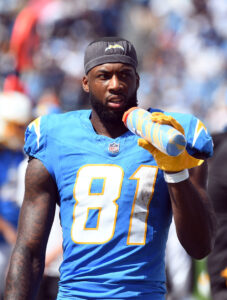 While the team’s QB play last season didn’t help the receiving game, the Jets were still able to identify a lack of high-quality depth behind WR1 Garrett Wilson. With Allen Lazard failing to live up to his contract without his familiar QB, the Jets pivoted to a new WR2 in Williams. An ACL tear limited the wideout to only three appearances in 2023, but Williams isn’t far removed from a four-year stretch with the Chargers where he averaged more than 900 receiving yards per season. The soon-to-be 30-year-old pass catcher might not immediately see a full workload, but it shouldn’t be long until he emerges as one of Rodgers’ preferred targets.
While the team’s QB play last season didn’t help the receiving game, the Jets were still able to identify a lack of high-quality depth behind WR1 Garrett Wilson. With Allen Lazard failing to live up to his contract without his familiar QB, the Jets pivoted to a new WR2 in Williams. An ACL tear limited the wideout to only three appearances in 2023, but Williams isn’t far removed from a four-year stretch with the Chargers where he averaged more than 900 receiving yards per season. The soon-to-be 30-year-old pass catcher might not immediately see a full workload, but it shouldn’t be long until he emerges as one of Rodgers’ preferred targets.
The Jets also used free agency to address their offensive line needs, with the front office snagging a pair of veterans. Smith represented one of the biggest names and one of the biggest upsides on the market, but it’s been almost a decade since he made it through a regular season unscathed (including 2020 and 2022 campaigns that were all but wiped out). The All-Decade blocker did manage to get into 13 games with the Cowboys last season, earning second-team All-Pro honors while grading out as PFF’s fourth-best tackle.
The signing represents a low-risk, high-reward move for the Jets, and the team did an admirable job of adding more OL depth to cover for the longtime Cowboy’s injury issues. At guard, the team added former Raiders draft pick in Simpson. The lineman fell out of favor in Las Vegas, but he somewhat rebounded with the Ravens in 2023, finishing as PFF’s 49th guard among 79 qualifiers.
Defensively, Kinlaw represents some upside up front. The former 49ers first-round pick was once coached by Robert Saleh, so there’s some hope that the Jets may be able to get the most out of the soon-to-be 27-year-old. Fotu should also provide some depth on the defensive line, although the veteran will miss the first chunk of the season while sitting on short-term injured reserve.
Re-signings:
- Greg Zuerlein, K: Two years, $8.4MM ($4.2MM guaranteed)
- Solomon Thomas, DL: One year, $3MM ($2.49MM guaranteed)
- Thomas Morstead, P: Two years, $5.1MM ($2.21MM guaranteed)
- Chuck Clark, S: One year, $2MM ($1.83MM guaranteed)
- Ashtyn Davis, S: One year, $2.74MM ($167K guaranteed)
With the majority of the Jets’ key players either signed to lucrative deals or rookie pacts, the team did not have many tough decisions when it came to retaining its own free agents. The team ultimately didn’t steal any headlines with its re-signings but did hold on to a handful of players who should contribute in 2024.
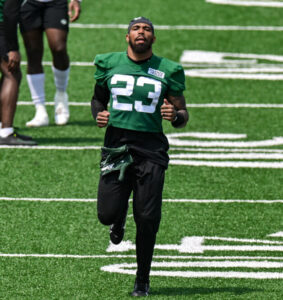 On defense, the Jets made sure to retain their safety depth…although they didn’t receive the longest look at the duo in 2023. Clark was a notable acquisition last offseason, obtained via trade from the Ravens, but the veteran suffered a torn ACL during OTAs that sidelined him for the entire campaign. Over his final two seasons in Baltimore, Clark earned high marks from Pro Football Focus for his work on run defense, although his coverage skills left some to be desired. The team also held on to rotational safety and special-teamer Ashtyn Davis, who started five of his 17 appearances during his fourth season in New York.
On defense, the Jets made sure to retain their safety depth…although they didn’t receive the longest look at the duo in 2023. Clark was a notable acquisition last offseason, obtained via trade from the Ravens, but the veteran suffered a torn ACL during OTAs that sidelined him for the entire campaign. Over his final two seasons in Baltimore, Clark earned high marks from Pro Football Focus for his work on run defense, although his coverage skills left some to be desired. The team also held on to rotational safety and special-teamer Ashtyn Davis, who started five of his 17 appearances during his fourth season in New York.
The Jets also managed to retain their special teams tandem. Greg The Leg has spent the past two seasons with the Jets, connecting on 86.7% of his field goal attempts (including 92.1% of his kicks in 2023). Thomas Morstead will return to the punting game following a 2023 season where he led the NFL in punts (99) and punting yards (4,831).
Notable losses:
- Mekhi Becton, T
- Duane Brown, T
- Randall Cobb, WR
- Bryce Huff, EDGE
- Quinton Jefferson, DL
- Carl Lawson, EDGE
- Connor McGovern, C
- Trevor Siemian, QB
- Laken Tomlinson, OL (released)
- Billy Turner, OT
- C.J. Uzomah, TE (released)
- Jordan Whitehead, S
- Al Woods, DL
The Jets entered the offseason determined to improve their offensive line, and that meant moving on from a long list of incumbents.. Becton headlined the list of departures, although that wasn’t because of his on-field contributions. The former 11th-overall pick had a pair of lost seasons during his four-year stint in New York. To his credit, he started all 16 of his appearances in 2023, but that only resulted in him ranking 66th among 81 offensive tackle qualifiers on Pro Football Focus. Despite his injury-riddled past, Becton is on track to open the season as an Eagles guard starter.
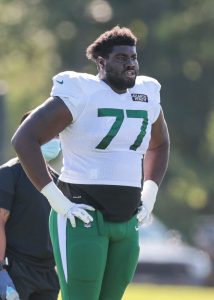 McGovern contributed during his four years in New York, starting each of his 55 appearances. However, he already wasn’t in the team’s future plans following the selection of Joe Tippmann in the second round of the 2023 draft, and McGovern showed some signs of decline last season before suffering a season-ending knee injury.
McGovern contributed during his four years in New York, starting each of his 55 appearances. However, he already wasn’t in the team’s future plans following the selection of Joe Tippmann in the second round of the 2023 draft, and McGovern showed some signs of decline last season before suffering a season-ending knee injury.
High hopes were in place for Laken Tomlinson when the Jets added the longtime 49ers starter in 2022, with the veteran guard having been ranked favorably by Pro Football Focus. However, that performance dropped in two years in New York, with Tomlinson ranking in the 50s among guard between 2022 and 2023. Tomlinson made his way to the Seahawks on a veteran-minimum deal.
On defense, the team watched Huff take a lucrative offer from Philly, leading to the front office’s pivot to Haason Reddick. Huff was one of the organization’s most successful scouting stories. The defensive lineman broke out with 10 sacks in 2023, but his rotational role meant the front office didn’t want to break the bank to keep him long-term. Whitehead is gone from the secondary after starting every game for the Jets between 2022 and 2023. The veteran consistently ranked as a middle-of-the-road safety, per PFF, and the Jets apparently felt comfortable rolling with a safety corps consisting of Chuck Clark, Tony Adams, and Ashtyn Davis. Whitehead is back with the Buccaneers, set to continue as a starter.
Draft:
- Round 1, No. 11 (via Vikings): Olu Fashanu (T, Penn State) (signed)
- Round 3, No. 65 (from Panthers): Malachi Corley (WR, Western Kentucky) (signed)
- Round 4, No. 134 (from Ravens): Braelon Allen (RB, Wisconsin) (signed)
- Round 5, No. 171: Jordan Travis (QB, Florida State) (signed)
- Round 5, No. 173 (from Chiefs): Isaiah Davis (RB, South Dakota State) (signed)
- Round 5, No. 176 (from 49ers): Qwan’Tez Stiggers (CB, Toronto Argonauts) (signed)
- Round 7, No. 257: Jaylen Key (DB, Alabama) (signed)
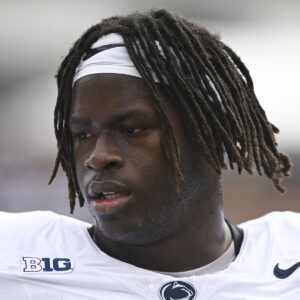 The Jets did not only use free agency and trades to address their O-line weakness. After missing out on an OL during the 2023 first round, the team landed on Penn State’s Olu Fashanu with the 11th pick in the 2024 draft.
The Jets did not only use free agency and trades to address their O-line weakness. After missing out on an OL during the 2023 first round, the team landed on Penn State’s Olu Fashanu with the 11th pick in the 2024 draft.
At 6-foot-6, 313 pounds, Fashanu already had a first-round grade in 2023 before surprising most pundits by sticking in school for one more year. The rookie doesn’t have an immediate path to playing time, but considering the injury history of Tyron Smith and the age concerns of Morgan Moses, it might not take long for Fashanu to work his way into the lineup.
The Jets didn’t necessarily need to address the rest of their offense in the draft, but the team still used subsequent picks to add depth at the skill positions. Malachi Corley hauled in 22 touchdowns over his final two seasons at Western Kentucky, and while the organization is high on the likes of Xavier Gipson, the rookie wideout could quickly emerge as the team’s WR3. It’s a similar sentiment at running back. While Israel Abanikanda was a fan favorite as a rookie, the team still used a fourth-round pick on Wisconsin’s Braelon Allen. The running back is coming off three straight 1,000-yard seasons, and he provides some high-upside insurance behind Breece Hall.
Later in the draft, Qwan’Tez Stiggers could provide some intriguing upside. The rookie may be the team’s top backup at outside CB behind Sauce Gardner and D.J. Reed, and reports from camp indicate that the Jets won’t keep the first-year player buried on the bench.
Other:
Alijah Vera-Tucker is one of the team’s lone holdovers on the offensive line, although he’s followed the organization’s recent track record of being on the sideline more than the field. Despite Vera-Tucker being limited to 12 combined games between 2022 and 2023, the Jets still felt comfortable committing to the lineman for the 2025 campaign. Pro Football Focus has also been fond of Vera-Tucker’s performance, but staying on the field is obviously half the battle.
The team shuttled Vera-Tucker to right tackle in each of the past two seasons, but after adding Moses and Fashanu, it feels comfortable keeping the 2021 first-rounder at his natural guard spot.
Top 10 cap charges for 2024:
- Quinnen Williams, DT: $20.4MM
- Aaron Rodgers, QB: $17.1MM
- D.J. Reed, CB: $15.6MM
- Allen Lazard, WR: $12.1MM
- Tyler Conklin, TE: $9.3MM
- Sauce Gardner, CB: $9.1MM
- C.J. Mosley, LB: $7.2MM
- Quincy Williams, LB: $7.1MM
- Garrett Wilson, WR: $5.6MM
- Morgan Moses, RT: $5.5MM
Last season obviously did not go as planned for the Jets, but the organization deserves credit for going out and patching up clear holes during the 2024 offseason. Those moves have set the Jets up for even more success during the upcoming campaign, and the sky is truly the limit for the first time in years.
On the flip side, the organization is obviously aiming higher than simply making its first playoff appearance in more than a decade. In the somewhat-likely event the Jets do crash and burn during the postseason, there could be some major changes, particularly with their unpredictable quarterback and their white-knuckled HC/GM duo. But ownership gave Douglas and Saleh the chance to take a swing with Rodgers on the field. After building strong defenses together, the tandem will rely on the four-time MVP — in a season during which the NFL’s oldest active quarterback will turn 41 — to save their jobs.
By Sam Robinson |
at September 1, 2024 9:33 pm
Replacing the player most consider the greatest quarterback in NFL history, the Buccaneers also entered last season with more than $70MM in dead money — much if from Tom Brady‘s retirement — on their payroll. After the team defended its NFC South title and saw Baker Mayfield pilot a late-season charge, GM Jason Licht signed off on largely running it back in 2024.
While OC Dave Canales departed, Mayfield joined some Super Bowl-era cornerstones in recommitting to the Bucs. This effort, which included two record-setting extensions, will test how well the Bucs have built their roster. The team still plays in what again looks like the NFL’s worst division. It would surprise if this mass retention effort did not keep the Bucs a threat for a fourth straight home wild-card game.
Extensions and restructures:
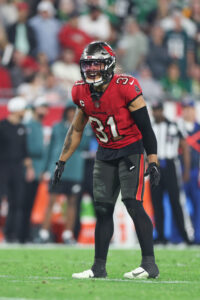 With the exception of the Bengals’ rental plans involving Tee Higgins, teams operated intently with their franchise- or transition-tagged players. While the Patriots used the transition tag on Kyle Dugger, the Bucs ensured Winfield could not test the market by slapping the franchise tag on the All-Pro. This turned out to be a significant offseason for the team’s breakthrough 2020 draft class, with pillars Winfield and Wirfs being locked down long term. Months before Wirfs’ payday, Winfield came in with a deal that tops all safeties and proved to outpace all cornerbacks as well.
With the exception of the Bengals’ rental plans involving Tee Higgins, teams operated intently with their franchise- or transition-tagged players. While the Patriots used the transition tag on Kyle Dugger, the Bucs ensured Winfield could not test the market by slapping the franchise tag on the All-Pro. This turned out to be a significant offseason for the team’s breakthrough 2020 draft class, with pillars Winfield and Wirfs being locked down long term. Months before Wirfs’ payday, Winfield came in with a deal that tops all safeties and proved to outpace all cornerbacks as well.
The safety market featured interesting twists this year. A host of veteran safeties — Justin Simmons and Quandre Diggs among them — became cap casualties. Many others settled for middle-class money as unrestricted free agents. As a market correction appeared in the works, the Packers gave Xavier McKinney a top-four safety deal. This brought good news for Winfield, who is a more accomplished safety. McKinney’s Green Bay deal reminded teams were still willing to pay up for the top young players at the position, and rumblings about Winfield requiring a record-setting extension surfaced soon after.
A 2020 second-round pick, Winfield became an immediate starter and helped the Bucs stonewall a historically explosive Chiefs offense in Super Bowl LV. The Bucs had expressed interest in extending the second-generation NFL DB in 2023, but Winfield ended up benefiting from the team waiting. He delivered a first-team All-Pro showing, complete with three interceptions, six sacks and an NFL-high six forced fumbles. The sixth of those strips denied DJ Chark at the goal line in a narrow Bucs Week 18 win over the Panthers, leading to a division title. Despite Mayfield and Mike Evans‘ free agencies, Winfield always loomed as Tampa Bay’s clear tag candidate.
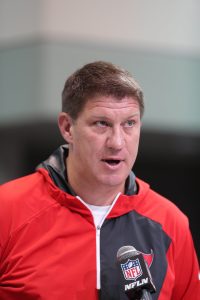 This pact checks in more than $2MM north of Derwin James‘ previous safety high-water mark, in terms of AAV, with the $21.03MM-per-year number also coming in higher than Jaire Alexander‘s CB record. In terms of guarantees at signing, Winfield’s $45MM separates him by $7MM from the safety pack. The threat of the Bucs tagging Winfield again in 2025 contributed to the team needing to go here to extend its top DB. Not hailed on the same level as Jamal Adams‘ 2021 extension that provided a gap between the then-Seahawks safety and the field, Winfield’s deal quietly accomplished this as well.
This pact checks in more than $2MM north of Derwin James‘ previous safety high-water mark, in terms of AAV, with the $21.03MM-per-year number also coming in higher than Jaire Alexander‘s CB record. In terms of guarantees at signing, Winfield’s $45MM separates him by $7MM from the safety pack. The threat of the Bucs tagging Winfield again in 2025 contributed to the team needing to go here to extend its top DB. Not hailed on the same level as Jamal Adams‘ 2021 extension that provided a gap between the then-Seahawks safety and the field, Winfield’s deal quietly accomplished this as well.
Going into free agency, Licht did not classify a 2024 Wirfs deal as a priority. After Tampa Bay checked its other top contract matters off the list, Wirfs made sure it became one. A spring report suggested the sides were far apart.
The Bucs had developed an atypical habit of waiting until after key players’ contracts expired to pay them. They did this with Shaq Barrett in 2021, Carlton Davis in 2022 and Jamel Dean last year. This trend continued in 2024, with Evans and Mayfield on the cusp of free agency before re-signing. Winfield also needed to be tagged, upon playing out his rookie deal. Wirfs staged a hold-in to force the team’s hand, and the Bucs deviated from their usual timeline.
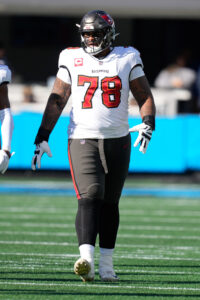 The Bucs saw the tackle market move before acting on Wirfs. While this may have cost the team a bit, this extension was actually early compared to when the team normally does business. Penei Sewell became the rare right tackle to reset the market for all tackles, scoring a $28MM-per-year Lions extension and the Vikings then gave Christian Darrisaw a deal that topped the LT market — at $26MM per.
The Bucs saw the tackle market move before acting on Wirfs. While this may have cost the team a bit, this extension was actually early compared to when the team normally does business. Penei Sewell became the rare right tackle to reset the market for all tackles, scoring a $28MM-per-year Lions extension and the Vikings then gave Christian Darrisaw a deal that topped the LT market — at $26MM per.
Wirfs, 25, is more accomplished than both, being a three-time Pro Bowler — at two different positions — and collecting first- and second-team All-Pro honors. Also helping Tampa Bay during its Brady years, Wirfs made a successful transition to the left side in 2023. Of the four tackles chosen in the top 13 picks in 2020, Wirfs — selected 13th overall — has been the best to date.
The Iowa product’s deal reflects this. The Bucs gave the fifth-year blocker $11MM more in guarantees ($88.2MM) than any other tackle. Tampa Bay did convince Wirfs to sign a five-year deal, but the contract does not tie Wirfs to his team for as long as Andrew Thomas‘ Giants pact does. Wirfs signed effectively a six-year commitment, whereas the Giants’ No. 4 overall pick in 2020 — who agreed to terms after his third season — gave his team seven years of control. Wirfs’ resolution matches the Lions’ Sewell term length, with the NFC North champs doing a deal following their RT’s third season.
With teams making significant updates to the tackle market this offseason, the NFL’s first $30MM-per-year tackle is likely coming soon.
Re-signings:
- Baker Mayfield, QB. Three years, $100MM ($40MM guaranteed)
- Mike Evans, WR. Two years, $41MM ($29MM guaranteed)
- Lavonte David, LB. One year, $8.5MM ($8.5MM guaranteed)
- Chase McLaughlin, K. Three years, $12.3MM ($5MM guaranteed)
- Greg Gaines, DT. One year, $3.5MM ($3MM guaranteed)
- William Gholston, DL. One year, $1.38MM ($985K guaranteed)
Value swings have defined Mayfield’s career. He went from an impressive rookie year that dragged the Browns out of the worst period in franchise history to enduring a major regression under overmatched HC Freddie Kitchens. The 2018 No. 1 overall pick then bounced back under Kevin Stefanski, giving the Browns their first playoff win since the franchise reboot. After Mayfield extension rumors did not produce serious negotiations in 2021, an early-season shoulder injury harpooned his value. The Browns then made their controversial (and financially damaging) Deshaun Watson trade, and Mayfield did not improve in Carolina, turning in his worst NFL season. That led to the Bucs nabbing him for $4MM; the sides’ second negotiation proved more complicated.
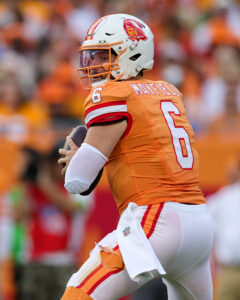 Mayfield needed to beat out Kyle Trask for the starting job, and Tampa Bay started 4-7. But the veteran showed flashes during the season’s first half and then piloted the team to a division-winning finish — likely saving Todd Bowles‘ job — and a wild-card romp over an Eagles team in crisis.
Mayfield needed to beat out Kyle Trask for the starting job, and Tampa Bay started 4-7. But the veteran showed flashes during the season’s first half and then piloted the team to a division-winning finish — likely saving Todd Bowles‘ job — and a wild-card romp over an Eagles team in crisis.
Mayfield, 29, had produced a better QBR with Stefanski, and his 54.3 number last year actually came in under his much-maligned 2019 season’s output (54.4). Mayfield ranked 18th in the metric in 2023. Under Canales, though, Mayfield finished with a career-high 28 TD passes (compared to 10 INTs). Following a 337-yard, three-TD showing against the Eagles, Mayfield held his own in Detroit in the divisional round (349/3, with two INTs) to better position himself for a higher-end 2024 contract.
The 2017 Heisman winner had said he wanted to stay with the Bucs, but they will have a harder time building around a $33.3MM-per-year contract than they did in 2023. That said, Brady’s $35.1MM dead money bill brought far more in combined QB cap allocations compared to where Mayfield’s money is this year ($6.9MM). Even after the current passer’s cap number spikes to $35.78MM in 2025, the ’23 Bucs still carried more in combined quarterback money on the payroll. With eight QBs now over $50MM per year and Dak Prescott set to become No. 9 soon or in 2025, Mayfield in this middle-class price range is not as player-friendly as the massive raise would suggest.
The sides completed a deal before free agency, and while loose Falcons and Patriots connections emerged, Mayfield never seemed close to leaving the team that revitalized his career. Barring an 11th-hour Prescott extension, Mayfield will enter the season as the NFL’s 19th-highest-paid quarterback. The seventh-year passer will see $10MM added to his guarantee total on Day 5 of the 2025 league year. It would cost the Bucs more than $26MM in dead money to bail before that date, giving the QB some security — though, not full-fledged assurances he will be back in 2025 — if another regression occurs.
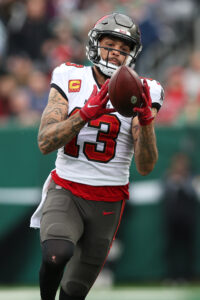 Discussions about the second-best wide receiver in Bucs history — for the handful of folks who have drifted far enough off path to address this matter — probably center on Chris Godwin, Kevin House, Mark Carrier or Vincent Jackson. The gap between this tier and Evans is rather wide.
Discussions about the second-best wide receiver in Bucs history — for the handful of folks who have drifted far enough off path to address this matter — probably center on Chris Godwin, Kevin House, Mark Carrier or Vincent Jackson. The gap between this tier and Evans is rather wide.
Making a Frank Gore-like Hall of Fame case based on consistency, Evans leads the Bucs in receiving by nearly 5,000 yards. The 10-time 1,000-yard receiver has been a modicum of consistency, providing high production baselines for Brady, Jameis Winston and Mayfield during his career. Evans does not have a first-team All-Pro honor on his resume (two second-team nods) and has surpassed 1,300 yards in a season just twice (2016, 2018), but he has been durable and did enough in 2023 to convince the Bucs to re-sign him — after a separation appeared in play.
Going public with frustration about his situation last August, Evans had confirmed the Bucs had not made an offer as the 2023 season neared. The decorated WR had seen the position’s market boom, while he remained tied to a $16.5MM-per-year deal he agreed to in 2018. That contract had plummeted toward the position’s middle class, with Godwin even surpassing it on his current $20MM-AAV accord. Evans matched the NFL lead in receiving TDs (13) last season, as the Bucs shut down trade inquiries. Rumblings about another Bucs deal surfaced, and the sides came together without the 2014 first-rounder reaching free agency.
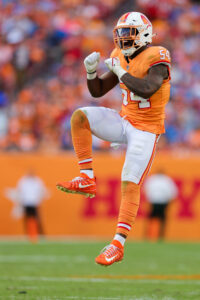 Evans, 31, had aimed to test the market and later said he would have considered the Chiefs or Texans if a viable Tampa Bay offer did not emerge. Instead, the Bucs gave their dependable pass catcher a frontloaded contract. In addition to the $29MM guaranteed at signing, another $6MM will come Evans’ way if he is on the Bucs’ roster on Day 5 of the 2025 league year. Barring a trade, he almost certainly will be. Regardless, Evans will almost definitely see all $41MM on this deal.
Evans, 31, had aimed to test the market and later said he would have considered the Chiefs or Texans if a viable Tampa Bay offer did not emerge. Instead, the Bucs gave their dependable pass catcher a frontloaded contract. In addition to the $29MM guaranteed at signing, another $6MM will come Evans’ way if he is on the Bucs’ roster on Day 5 of the 2025 league year. Barring a trade, he almost certainly will be. Regardless, Evans will almost definitely see all $41MM on this deal.
This is David’s fifth Bucs contract. As he continues to anchor the team’s second level, David ended up nearly doubling his 2023 contract (one year, $4.5MM) ahead of his age-34 season. The former second-round pick’s 134 tackles last season were his most since 2015 — his most recent Pro Bowl season, though the Bucs’ time in a 4-3 defense during the LB’s prime hurt his Pro Bowl count — and Pro Football Focus rated David as a top-25 off-ball ‘backer for the seventh straight year.
A one-team player, David had said it was Bucs or retirement this offseason. The Bucs will continue to lean on David, who trails only Ronde Barber and Derrick Brooks for Tampa Bay service time by a defender.
This is also Gholston’s fifth Bucs contract, as Licht’s retention approach did not only include higher-end contracts. Gholston has started 88 Bucs games, playing in 169. It is rare in today’s NFL when a 12th-year player is not his team’s longest-tenured defender, but David still holds that distinction. These two are the only remaining links to Bowles’ Super Bowl LV front seven. Gholston, 33, saw his playing time drop considerably in 2023; he played a career-low 244 defensive snaps. The Bucs still kept the veteran D-lineman around as a backup, with two recent early-round picks — starters Calijah Kancey, Logan Hall — to mentor.
Free agency additions:
- Jordan Whitehead, S. Two years, $9MM ($4.5MM guaranteed)
- Ben Bredeson, G. One year, $3MM ($1.75MM guaranteed)
- Chase Edmonds, RB. One year, $1.5MM ($1MM guaranteed)
- Tavierre Thomas, CB. One year, $1.5MM ($750K guaranteed)
- Sua Opeta, G. One year, $1.38MM ($650K guaranteed)
- Justin Skule, T. One year, $1.29MM ($600K guaranteed)
- Sterling Shepard, WR. Practice squad
Licht had bemoaned his decision to let Whitehead walk as a free agent in 2022, but the team did not operate with a full-on retention strategy the way it had in 2021. Whitehead, who started 55 games with the Bucs from 2018-21, played out a two-year, $14MM Jets deal. The Jets wanted to re-sign Whitehead but did not deem that a high priority. Whitehead is back in place as a safety starter, set to work alongside Winfield. From 2018-20, the Bucs used six second-, third- or fourth-round picks on DBs. Three remain with the team, as Dean continues on his 2023 re-up. Despite going into his seventh season, Whitehead is just 27.
Read more
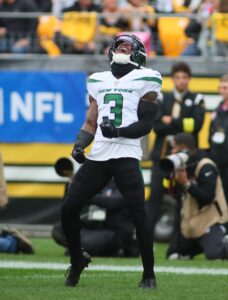 Bredeson has proven good enough to keep making his way into starting lineups. The Giants had expected the 2021 trade pickup to lose a competition to former third-rounder Joshua Ezeudu; Bredeson started 16 games last season. That came for an admittedly abysmal Giants O-line, and Bredeson’s market indeed underwhelmed. But he will take over as the team’s left guard starter.
Bredeson has proven good enough to keep making his way into starting lineups. The Giants had expected the 2021 trade pickup to lose a competition to former third-rounder Joshua Ezeudu; Bredeson started 16 games last season. That came for an admittedly abysmal Giants O-line, and Bredeson’s market indeed underwhelmed. But he will take over as the team’s left guard starter.
A former fourth-round Ravens draftee, Bredeson had been running ahead of Opeta before the latter’s ACL tear. He represents a low-cost solution for a Bucs team that just allocated record-setting cash to Wirfs. The team has displaced center Robert Hainsey and ex-Packers guard Royce Newman as insurance, as Bredeson is the only non-homegrown starter up front in Tampa. Opeta, who suffered a torn ACL, joins Edmonds in being out for the year.
Reuniting with Mayfield via a post-draft deal, Shepard is in place as insurance for a Bucs team that appears to have a clear-cut top three of Evans, Godwin and third-rounder Jalen McMillan. An Oklahoma alum who spent eight seasons with the Giants, Shepard was used sparingly last season (142 snaps) but did return to full strength after another major injury — a 2022 Achilles tear.
Notable losses:
- Shaq Barrett, OLB (post-June 1 cut)
- Dee Delaney, CB
- Matt Feiler, G
- Russell Gage, WR
- Randy Gregory, OLB (released)
- Ryan Jensen, C (retired)
- Nick Leverett, OL
- David Moore, WR
- Ryan Neal, S
- Deven Thompkins, WR (waived/injured)
- Devin White, ILB
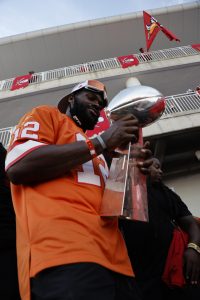 Two Super Bowl LV core performers, Barrett and Jensen are each done after 10-year careers. Each saw action in five Bucs seasons, with Jensen sidelined throughout the 2023 campaign after missing almost all of the ’22 slate.
Two Super Bowl LV core performers, Barrett and Jensen are each done after 10-year careers. Each saw action in five Bucs seasons, with Jensen sidelined throughout the 2023 campaign after missing almost all of the ’22 slate.
Barrett, who played five seasons with the Bucs, walked away after a brief stint with the Dolphins. The two-time Super Bowl winner — as a backup in Denver and a linchpin in Tampa — Barrett first became a Bucs cap casualty. Initially playing the odd role of comforting Licht as he made the transaction, Barrett had not looked quite himself in returning from an October 2022 Achilles tear. Barrett had ripped off a 37.5-sack surge from 2019-21. This stretch included an NFL sack crown (19.5 in 2019) and a lucrative 2021 re-signing. The payday came after the Bucs tagged Barrett in 2020 and after he made a Super Bowl MVP case by supplying relentless pressure on Patrick Mahomes.
The Bucs had restructured Barrett’s deal, increasing the Year 4 dead money. This transaction will leave behind considerable dead cap for two years. As a post-June 1 cut, Barrett will count $9.4MM in 2024 dead money and $17.4MM in 2025. His exit also leaves the Bucs with some questions at outside linebacker.
Jensen joined Carlton Davis in re-signing with the Bucs shortly after Brady unretired in 2022, but the veteran center was largely unable to reprise his role snapping to the all-time great. A severe knee injury sustained early during that year’s training camp sidelined Jensen throughout the regular season. While he returned to play in Tampa Bay’s wild-card matchup, the knee trouble ended his career a year later. Jensen had re-signed on a three-year, $39MM deal, but full MCL and PCL tears — along with ACL and meniscus damage — shut him down. A four-year Bucs starter, the ex-Ravens draftee started 65 games with his second NFL team. His knee trouble influenced Tampa Bay in the draft.
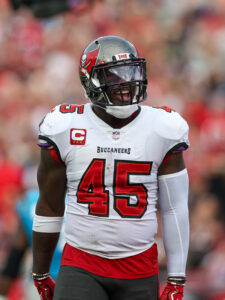 Flashing brightly at points, White saw his Bucs tenure ultimately disappoint. In one of the starker examples of a player miscalculating his value, White pushed for a top-five off-ball linebacker contract and requested a trade during the 2023 offseason. The Bucs not only balked there, but they ended up demoting the former top-five pick late in the season.
Flashing brightly at points, White saw his Bucs tenure ultimately disappoint. In one of the starker examples of a player miscalculating his value, White pushed for a top-five off-ball linebacker contract and requested a trade during the 2023 offseason. The Bucs not only balked there, but they ended up demoting the former top-five pick late in the season.
White had said his trade request altered his relationship with team brass. K.J. Britt cut into White’s playing time, after a strange injury subplot. Britt started over White in both Bucs playoff games, and the former second-team All-Pro — a player whose reputation proved incongruous to his advanced metrics — signed a one-year, $4MM Eagles deal. Britt, a 2021 fifth-rounder, is positioned to start alongside David.
Gregory’s Bucs tenure will slide to footnote territory, but it became a bizarre offseason storyline. Excepting Haason Reddick, most instances of a player not reporting to minicamp or training camp stem from a holdover upset about his contract. Gregory signed a one-year, $3MM deal in April but never showed up. Bowles had said he did not have any contact with the former Cowboys, Broncos and 49ers edge rusher, and the Bucs ended up cutting him days into his training camp holdout. Gregory had filed a lawsuit against the NFL and the Broncos regarding medication earlier this year and retired shortly after his Tampa no-show.
Trades:
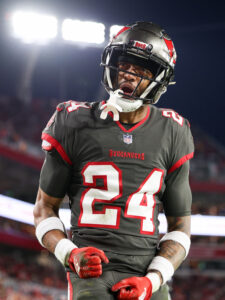 Re-signing Davis in 2022 and Dean in 2023, the Bucs split from one of their second-contract corners during the offseason that brought the Winfield and Wirfs megadeals. The Lions landed Davis before the Cameron Sutton drama and acquired a six-year starter whose contract expires at season’s end.
Re-signing Davis in 2022 and Dean in 2023, the Bucs split from one of their second-contract corners during the offseason that brought the Winfield and Wirfs megadeals. The Lions landed Davis before the Cameron Sutton drama and acquired a six-year starter whose contract expires at season’s end.
Tampa Bay’s Davis second-round choice in 2018 started the slew of DB investments in the draft; the first move gave the team a locked-in starter for a rather important period in team history. Teaming with Dean and Sean Murphy-Bunting, Davis commanded the top AAV ($15MM per year) on his second contract. Although Davis was charged with five touchdowns allowed in 2020, his passer rating-against numbers were stable, landing between 80-88 from 2019-22. Last year brought a slight step back, and PFF ranked Davis 68th at the position.
The Bucs have Dean signed through 2026, and they will lean on lower-cost complementary pieces rather than paying two CBs. Zyon McCollum, who struggled last season, and third-round rookie Tykee Smith are expected to join Dean as regulars.
Draft:
- Round 1, No. 26: Graham Barton (OL, Duke) (signed)
- Round 2, No. 57: Chris Braswell (EDGE, Alabama) (signed)
- Round 3, No. 89: Tykee Smith (S, Georgia) (signed)
- Round 3, No. 92 (from Lions): Jalen McMillan (WR, Washington) (signed)
- Round 4, No. 125: Bucky Irving (RB, Oregon) (signed)
- Round 6, No. 220: Elijah Klein (G, UTEP) (signed)
- Round 7, No. 246: Devin Culp (TE, Washington) (signed)
Tampa Bay had not devoted a first-round pick to an interior O-lineman since taking Davin Joseph in 2006. The team made Barton the first IOL taken in this year’s draft. Barton primarily played tackle at Duke, but he had long been viewed — unlike the Packers’ Jordan Morgan, who made a summer shift to guard — coming into the draft as a player who would line up inside as a pro.
 Barton had long been expected to start, and he indeed beat out Hainsey for the center job. Hainsey had started all 34 Bucs regular-season games following Jensen’s injury. PFF rated the former third-round pick as the league’s fifth-worst center regular last season, and the Bucs again used an early-round pick to bolster a front that had lost all its non-Wirfs starters from Super Bowl LV. After selecting RT Luke Goedeke in the 2022 second round and RG Cody Mauch in Round 2 last year, the Bucs now have four first- or second-round homegrown cogs up front. Barton earned back-to-back first-team All-ACC honors at left tackle but saw center work as a freshman back in 2020.
Barton had long been expected to start, and he indeed beat out Hainsey for the center job. Hainsey had started all 34 Bucs regular-season games following Jensen’s injury. PFF rated the former third-round pick as the league’s fifth-worst center regular last season, and the Bucs again used an early-round pick to bolster a front that had lost all its non-Wirfs starters from Super Bowl LV. After selecting RT Luke Goedeke in the 2022 second round and RG Cody Mauch in Round 2 last year, the Bucs now have four first- or second-round homegrown cogs up front. Barton earned back-to-back first-team All-ACC honors at left tackle but saw center work as a freshman back in 2020.
Gregory’s signing leading to retirement should accelerate Braswell’s time clock. With Joe Tryon-Shoyinka being benched last season, the Bucs need their second-round pick to play early. Both Bucs starters missed most of camp with injuries, and with YaYa Diaby replacing Tryon-Shoyinka opposite Barrett midway through last season, the 2021 first-rounder is on thin ice. Despite not working as a regular starter for Alabama, Braswell posted eight sacks (second on the team) and 10.5 tackles for loss. The Bucs, who had relied on outside acquisitions on the edge for a while, found a promising piece in Diaby. They need Braswell to follow suit.
Smith has beaten out 2023 slot Christian Izien for this year’s gig. This represents a quick ascent for the Georgia talent, who rounds out a starting secondary featuring five Bucs draft choices. A contributor on Georgia’s 2022 national championship team, Smith intercepted four passes and notched 8.5 tackles for loss last season. Izien remains on Tampa Bay’s roster, with Tavierre Thomas also having slot experience. The Bucs have some options in the event Smith is not ready.
Other:
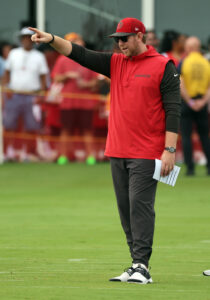 Canales went from a 12-year position coach who had never interviewed for a coordinator job before the 2023 offseason to a head coach on a six-year contract. The Panthers did not exactly have the best sales pitch for top-tier candidates, given their struggles under impulsive owner David Tepper, but the Buccaneers were able to coax far more out of Mayfield than Carolina thanks largely to Canales. After helping Geno Smith to Comeback Player of the Year acclaim as QBs coach, Canales jumped another rung on the ladder.
Canales went from a 12-year position coach who had never interviewed for a coordinator job before the 2023 offseason to a head coach on a six-year contract. The Panthers did not exactly have the best sales pitch for top-tier candidates, given their struggles under impulsive owner David Tepper, but the Buccaneers were able to coax far more out of Mayfield than Carolina thanks largely to Canales. After helping Geno Smith to Comeback Player of the Year acclaim as QBs coach, Canales jumped another rung on the ladder.
Coen happened to be the Rams’ OC when the operation fell apart in 2022. Injuries to Matthew Stafford, Cooper Kupp and most of the starting O-line plunged the team to 5-12 in 2022. He agreed to return to Kentucky before that season had ended. The Bears joined the Bucs in interviewing Coen; his second time leaving Kentucky’s OC post in three years will be to reunite with Mayfield. The 2022 waiver claim overlapped with Coen’s one-and-done Rams OC tenure, but this will be a new challenge for the successful college OC: an NFL play-calling gig.
The Rams ranked 27th in scoring and 32nd in yardage under Coen — by far their worst Sean McVay-era marks — but it is difficult to judge that due to the injury spree. Kentucky, however, yo-yoed from 36th under Coen in 2021 to 112th without him in 2022 (Will Levis‘ final season) to 58th last year. This is far from a home run hire, but the 38-year-old assistant does have more of an NFL past than his rough OC stint. He also served as a Rams staffer from 2018-20. The Bucs memorably gave Mayfield a say in their OC search before he had re-signed, giving a good indication of the team’s 2024 QB plan.
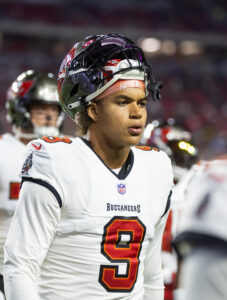 Armstrong, Goodwin and Gilbert both stayed on as Bruce Arians hires, with Idzik jumping from one season in charge of a position to an OC post. Idzik had previously been the Seahawks’ assistant WRs coach before following Canales to Tampa in 2023. Tom Moore, 85, remains in the consulting role Arians tabbed him for, however.
Armstrong, Goodwin and Gilbert both stayed on as Bruce Arians hires, with Idzik jumping from one season in charge of a position to an OC post. Idzik had previously been the Seahawks’ assistant WRs coach before following Canales to Tampa in 2023. Tom Moore, 85, remains in the consulting role Arians tabbed him for, however.
Hoping to land a quality Jason Pierre-Paul successor, the Bucs have not seen Tryon-Shoyinka fit the bill yet. As a 16-game starter in 2022, the Washington alum did produce 14 QB hits in a four-sack season. In 17 games last year, however, the young edge defender compiled just seven QB hits. The Bucs benched him for eventual team sack leader Diaby after Week 12.
Considering Tryon-Shoyinka’s uninspiring first three seasons, it represents a clear gamble for the Bucs to try him as a starter once again. Now in a contract year, the 25-year-old pass rusher enters a fork-in-the-road season as a pro.
Top 10 cap charges for 2024:
- Chris Godwin, WR: $27.53MM
- Vita Vea, DT: $20.53MM
- Jamel Dean, CB: $14.67MM
- Lavonte David, LB: $8.5MM
- Antoine Winfield Jr., S: $8MM
- Baker Mayfield, QB: $6.9MM
- Tristan Wirfs, LT: $6.61MM
- Mike Evans, WR: $5.57MM
- Anthony Nelson, OLB: $5.38MM
- Chase McLaughlin, K: $5MM
Were the Buccaneers right to invest so heavily in their own acquisitions this offseason, or should this roster be a bit more diverse? The Colts took some heat for Chris Ballard‘s reinvestment penchant this year, but Licht’s team is projected to start all of two players (Mayfield, Bredeson) who were not Bucs draft picks. Plenty of confidence exists in a nucleus that tumbled off the Super Bowl radar after Tom Brady‘s penultimate season.
This formula still should be good enough to make another push to win the NFC South. The Falcons will be more imposing this season, but the Saints look to be putting off a necessary rebuild. The Panthers do not appear an immediate threat, and the NFC has produced an 8-8 or 9-8 No. 7 seed each year since the 2020 playoff expansion.
The Bucs should be in the mix, and they do not have Brady’s dead money figure on the books any longer. They are showing plenty of faith in an operation that has gone 17-17 under Bowles. The Coen-Mayfield setup will play the biggest role in determining if upward mobility exists for Bowles’ third roster.
By Ben Levine |
at August 31, 2024 9:59 pm
Four years into the post-Tom Brady era, the Patriots hit a new low. New England finished the 2023 campaign with only four wins, their lowest total since Bill Belichick’s five-win debut in 2000. That dismal performance ultimately led to the legendary coach’s ouster, meaning the organization has officially hit the reset button with two of their three franchise pillars out the door.
Owner Robert Kraft remains, and he’s hoping his two highest-profile offseason moves will help guide the franchise to another stretch of success. Jerod Mayo takes over along the sideline, with the unofficial co-defensive coordinator (and assumed Belichick successor) earning the promotion to HC. On the field, the team invested the No. 3 overall pick on North Carolina quarterback Drake Maye, a raw but talented prospect who possesses more upside than any of the other QBs who have taken the field since Brady’s departure.
That duo will be hard pressed to match even a fraction of Brady and Belichick’s accolades, but they’re obviously not being tasked with reaching those same heights. Instead, Kraft and Co. will be counting on his rebuilding squad to show same flashes of potential in 2024, perhaps convincing ownership to open up the checkbook next offseason.
Coaching/front office:
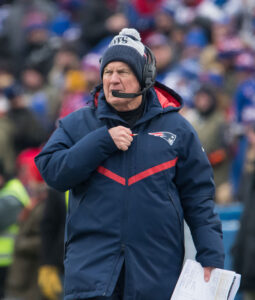 Bill Belichick’s resume is undeniable, and the organization wouldn’t have won six Super Bowl rings without him roaming the sideline. However, considering his full dominion over every facet of football operations, he was chiefly responsible for the team’s downfall in recent years.
Bill Belichick’s resume is undeniable, and the organization wouldn’t have won six Super Bowl rings without him roaming the sideline. However, considering his full dominion over every facet of football operations, he was chiefly responsible for the team’s downfall in recent years.
Even ignoring his influence on Tom Brady’s departure, Belichick made questionable decisions as both a coach and GM over the past four years. From his mishandling of the coaching staff (which featured handing the offense to former defensive coordinator Matt Patricia and former special teams coordinator Joe Judge) to his mishandling of the quarterback position (which never featured a full endorsement of former first-round pick Mac Jones), Belichick was as much to blame as anybody in the organization.
Following the team’s worst showing during Belichick’s tenure, the head coach and owner Robert Kraft ultimately decided to part ways. This officially ended one of the most successful runs in North American sports history, and with the two main contributors to New England’s dynasties no longer in the building, the Patriots have officially kicked off a new era.
While ownership went through a faux head coaching cycle, the team landed on the assumed successor: former linebacker and recent de facto defensive coordinator Jerod Mayo. The former first-round pick rejected previous head coaching inquiries to stick in New England, a major clue that he was likely going to succeed Belichick when the time came. While Mayo showed some coaching talent while guiding the defense alongside Stephen Belichick, it obviously remains to be seen if he has the ability to guide an entire organization. At the very least, he’ll provide a fresh voice to Belichick’s old-school (and, potentially, antiquated) approach.
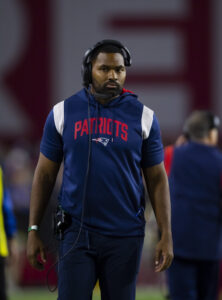 Mayo was immediately tasked with filling out his coaching staff. On offense, he landed on Alex Van Pelt, who was a surprise scapegoat following Cleveland’s blowout playoff loss last year. Van Pelt got the most out of Nick Chubb and Kareem Hunt during his four-year stint with the Browns, but the passing offense often left much to be desired. The offensive coordinator certainly won’t be evaluated for his rebuilding unit’s performance in 2024, but the organization will be hoping the offense shows some progress before the season is through.
Mayo was immediately tasked with filling out his coaching staff. On offense, he landed on Alex Van Pelt, who was a surprise scapegoat following Cleveland’s blowout playoff loss last year. Van Pelt got the most out of Nick Chubb and Kareem Hunt during his four-year stint with the Browns, but the passing offense often left much to be desired. The offensive coordinator certainly won’t be evaluated for his rebuilding unit’s performance in 2024, but the organization will be hoping the offense shows some progress before the season is through.
On defense, Mayo settled on a familiar face to guide the way. DeMarcus Covington has been with the Patriots staff since 2017, working his way up from an assistant to the team’s defensive line coach. Covington was credited with the development of former second-round pick Christian Barmore, and Matt Judon and Josh Uche have both had success on the edge under the coach’s tutelage.
Belichick’s departure also left a major hole in the front office, where the legendary coach had full control over the roster. For that gig, the organization also opted for the long-rumored favorite: director of scouting Eliot Wolf. The son of long-time Packers GM Ron Wolf, Eliot will be tasked with bringing some of that Green Bay mentality to New England. In that arrangement, the organization would value the personnel department’s input vs. the head coach’s final say (a tactic that was impossible with Belichick at the helm).
Belichick’s ouster obviously had rippling effects on every facet of the organization. The coach’s eventual departure was inevitable, and while his successors may take time to find their footing, the Patriots have overcome the first hurdle of ripping off the Belichick-sized band-aid.
Extensions and restructures:
 Curiously, while many pundits critiqued Bill Belichick’s recent draft track record and attributed it partly to his New England demise, the team still put in efforts to retain many of his extension-eligible draft picks.
Curiously, while many pundits critiqued Bill Belichick’s recent draft track record and attributed it partly to his New England demise, the team still put in efforts to retain many of his extension-eligible draft picks.
Two of the team’s three foundational extensions came on the defensive side of the ball. The Patriots first slapped safety Kyle Dugger with the rarely-used transition tag before handing him a lucrative four-year extension. The former second-round pick doesn’t have any Pro Bowl appearances on his resume, and Pro Football Focus has been inconsistent with their evaluation of the defensive back. Still, Duggar has proven himself to be one of New England’s most reliable defenders in recent years, with the safety compiling nine interceptions and 20 passes defended. Facing an uncertain future, some consistency and familiarity will be key.
The Patriots also made a sizable commitment to defensive tackle Christian Barmore, assuring the former second-round pick is in New England for the foreseeable future. The Alabama product’s production took a clear step forward this past season, with Barmore compiling 8.5 sacks and 13 tackles for loss in 2023, the second season in which he was healthy for every game. Barmore added 19 pressures and 16 QB hits, and he ranked eighth among defensive tackles in terms of PFF grade (83.8).
 On the offensive side of the ball, the Patriots strayed from Belichick’s former playbook by handing a running back a notable extension. Rhamondre Stevenson’s extension won’t break the bank, but the four-year commitment certainly shows a change in philosophies. The former fourth-round pick has been one of New England’s most consistent offensive contributors in recent years, including a 2022 campaign where he collected 1,461 yards from scrimmage.
On the offensive side of the ball, the Patriots strayed from Belichick’s former playbook by handing a running back a notable extension. Rhamondre Stevenson’s extension won’t break the bank, but the four-year commitment certainly shows a change in philosophies. The former fourth-round pick has been one of New England’s most consistent offensive contributors in recent years, including a 2022 campaign where he collected 1,461 yards from scrimmage.
David Andrews represents one of the lone holdovers from the team’s Super Bowl-winning days. The veteran center managed to start all 17 games for the second time in three years, and the Patriots are assuring he’ll continue to stick around as the team transitions to Drake Maye under center. Both Jabrill Peppers and Davon Godchaux were savvy former pickups by the Patriots in free agency, and the veterans were rewarded for their efforts with multi-year extensions.
Trades:
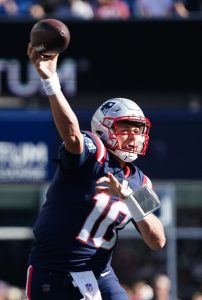 The Patriots didn’t seem entirely committed to Mac Jones during his sophomore season, and the quarterback clearly fell out of the team’s plans following his 2-9 showing as a starter in 2023. Even before the team committed to drafting Drake Maye with the third-overall pick, New England decided to move on from their former first-round pick.
The Patriots didn’t seem entirely committed to Mac Jones during his sophomore season, and the quarterback clearly fell out of the team’s plans following his 2-9 showing as a starter in 2023. Even before the team committed to drafting Drake Maye with the third-overall pick, New England decided to move on from their former first-round pick.
Jones had an up-and-down showing during his time with the Patriots. His best season came as a rookie, when he tossed 22 touchdowns, earned a Pro Bowl nod, and helped guide the Patriots to a postseason appearance. The wheels fell off over the subsequent two years, although the organization certainly didn’t put the signal-caller in a position to succeed. With Jones showing signs of regression and possessing only one-plus season remaining on his rookie contract, the Patriots decided to revamp their QB situation by dealing the player to Jacksonville.
As the Patriots handed out extensions left and right, the team curiously didn’t give a long-term pact to one of their most deserving players. Matt Judon took his play to another level after joining the Patriots as a free agent in 2021, with the edge rusher collecting 28 sacks between the 2021 and 2022 campaigns. His 2023 season was limited to only four games, and with the defender set to enter his age-32 season, the Patriots were wary of tacking on additional term to his contract.
While the front office was willing to increase his $6.5MM base salary for the 2024 campaign, it sounded like Judon wasn’t all that interested in a lame-duck status with a rebuilding squad. So, the Patriots made a move that was probably inevitable anyway by the time the trade deadline came around, sending their top defender to Atlanta for a third-round pick.
Free agency additions:
- Jacoby Brissett, QB: One year, $8MM ($6.5MM guaranteed)
- Antonio Gibson, RB: Three years, $11.25MM ($5.3MM guaranteed)
- K.J. Osborn, WR: One year, $4MM ($3.18MM guaranteed)
- Chukwuma Okorafor, OT: One year, $4MM ($3.13MM guaranteed)
- Sione Takitaki, LB: Two years, $6.6MM ($3.12MM guaranteed)
- Austin Hooper, TE: One year, $3MM ($2.4MM guaranteed)
- Joey Slye, K: One year, $1.26MM
- Armon Watts, DT: One year, $2.2MM ($800K guaranteed)
- Nick Leverett, G: One year, $1.77MM ($575K guaranteed)
- Jaylinn Hawkins, S: One year, $1.3MM ($417K guaranteed)
Armed with a chunk of cap room, the Patriots entered the offseason with some high hopes. While the team pursued some of the top names on the market, the front office ended up settling for some depth moves in a clear effort to evaluate their holdovers and draft picks.
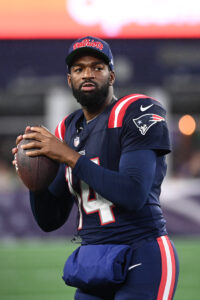 Offensively, the team’s most notable free agent addition was also a familiar face. Jacoby Brissett was a third-round pick by the Patriots back in 2016, but the QB only lasted one season in New England before he was dealt to the Colts, where he filled in (and eventually succeeded) Andrew Luck. He proved himself to be a capable starter but not a ceiling-raiser, and he’s since established a reputation as one of the league’s premier QB2s.
Offensively, the team’s most notable free agent addition was also a familiar face. Jacoby Brissett was a third-round pick by the Patriots back in 2016, but the QB only lasted one season in New England before he was dealt to the Colts, where he filled in (and eventually succeeded) Andrew Luck. He proved himself to be a capable starter but not a ceiling-raiser, and he’s since established a reputation as one of the league’s premier QB2s.
In New England, the veteran will keep the seat warm until Drake Maye is ready to roll. It’s uncertain if Brissett will run the offense for all or just part of the 2024 campaign, and the team’s sizable guaranteed commitment shows they’re paying up for the uncertain role.
The team added a handful of additional offensive players who could play fringe roles for the 2024 Patriots. Antonio Gibson proved himself to be a capable pass-catching back during his stint in Washington, and the veteran should provide the Patriots with a change-of-pace option at the RB position. K.J. Osborn topped 500 receiving yards in Minnesota in each of the past three seasons, but with an uncertain QB room and a relatively deep WR room, he probably won’t top those numbers in New England. Austin Hooper brings some experience to the tight end room, although the departed Mike Gesicki’s tepid New England production shows that we shouldn’t expect a whole lot from Hunter Henry’s backup.
Read more
Defensively, Sione Takitaki and Armon Watts landed on PUP and IR, respectively. Jaylinn Hawkins could find himself with a significant role if one of Kyle Dugger or Jabrill Peppers goes down with an injury, and the former fourth-round pick brings 25 games of starting experience to New England.
Re-signings:
- Michael Onwenu, OL: Three years, $57MM ($36.5MM guaranteed)
- Hunter Henry, TE: Three years, $27MM ($15.8MM guaranteed)
- Kendrick Bourne, WR: Three years, $19.5MM ($5.5MM guaranteed)
- Anfernee Jennings, LB: Three years, $12MM ($5.5MM guaranteed)
- Josh Uche, LB: One year, $3MM ($2.3MM guaranteed)
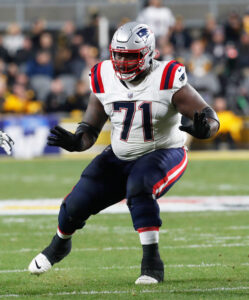 The Patriots made a point to retain one of their lone late-round draft successes from recent years in Michael Onwenu, giving the versatile lineman more than $36MM in guaranteed money. The former sixth-round pick found himself in and out of the starting lineup in 2021, but he started all 32 of his appearances over the past two years.
The Patriots made a point to retain one of their lone late-round draft successes from recent years in Michael Onwenu, giving the versatile lineman more than $36MM in guaranteed money. The former sixth-round pick found himself in and out of the starting lineup in 2021, but he started all 32 of his appearances over the past two years.
Listing Onwenu as a tackle in 2023, Pro Football Focus ranked him 29th among 81 qualifiers. The lineman ranked top-10 at his position in each of his first three seasons in the league. With the ability to play both guard and tackle, Onwenu’s versatility should come in handy as the organization looks to patch together an OL in upcoming seasons.
The Patriots also retained a pair of former draft picks on the defensive side of the ball. Josh Uche broke out in 2022 with an 11.5-sack campaign, but he failed to replicate that production in 2023, finishing with only three sacks. The Patriots weren’t willing to give the edge rusher a long-term pact, but they’ll help him rediscover his pass-rushing prowess in 2023. Anfernee Jennings actually did get a multi-year deal after having the most productive season of his career in 2023. The former third-round pick finished the season with a career-high 66 tackles, and he parlayed that performance into a three-year deal with New England.
The Patriots also made an effort to retain two of their most notable additions from their 2021 spending spree. Hunter Henry has had a consistent role in New England’s offense over the past three years despite inconsistent QB player, with the veteran tight end hauling in 17 touchdowns over that span. Kendrick Bourne, meanwhile, has found himself in and out of the doghouse, but he’s generally been one of the Patriots’ most dynamic players when he actually sees the field.
Bourne hasn’t come close to matching the career-high 800 receiving yards he compiled during his debut season in New England, and a torn ACL will keep him off the field to start the 2024 campaign. Still, the organization is clearly confident that the 29-year-old can provide the offense with a boost of energy over the upcoming seasons.
Notable losses:
- Chris Board, LB (released)
- Pharaoh Brown, TE
- Trent Brown, OL
- Myles Bryant, DB
- Ezekiel Elliott, RB
- Mike Gesicki, TE
- Lawrence Guy, DL (released)
- J.C. Jackson, CB (released)
- Conor McDermott, OL (released)
- Jalen Mills, DB
- Nathan Rourke, QB (released)
- DeVante Parker, WR (released)
- Adrian Phillips, S (released)
- Mike Purcell, DT (released)
- Riley Reiff, OL
- Chad Ryland, K (waived)
- Matthew Slater, WR (retired)
- JuJu Smith-Schuster, WR (released)
- Mack Wilson, LB
- Bailey Zappe, QB (waived)
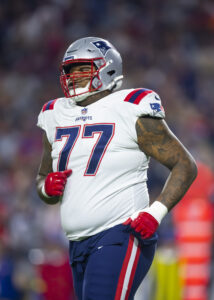 Bill Belichick represented the team’s most significant offseason departure, but the team also moved on from a handful of other notable names. Trent Brown‘s second stint in New England ultimately lasted three seasons, but the veteran offensive lineman was apparently counting down the days until free agency during the 2023 campaign. Despite the clear lack of focus, the 6-foot-8 blocker still ranked as Pro Football Focus’ 11th-best OT last season, and his departure will leave a massive hole (literally and figuratively) on New England’s offense line.
Bill Belichick represented the team’s most significant offseason departure, but the team also moved on from a handful of other notable names. Trent Brown‘s second stint in New England ultimately lasted three seasons, but the veteran offensive lineman was apparently counting down the days until free agency during the 2023 campaign. Despite the clear lack of focus, the 6-foot-8 blocker still ranked as Pro Football Focus’ 11th-best OT last season, and his departure will leave a massive hole (literally and figuratively) on New England’s offense line.
There was once a small (but loud) contingent of Patriots fans who believed Bailey Zappe deserved a legitimate shot under center. The former fourth-round pick wasn’t hopeless as a starter, going 4-4 in his eight career starts. However, his 11 touchdowns vs. 12 interceptions left plenty to be desired, and with the front office adding three QBs to the roster this offseason, Zappe was clearly on the outside looking in. Elsewhere on offense, the Patriots didn’t get the production they expected from pass-catchers DeVante Parker, JuJu Smith-Schuster, and Mike Gesicki. While that trio wasn’t entirely to blame for the poor showing, the group combined for only 91 catches in 2024. The Patriots decided to pivot to a younger WR corps by moving on from both Parker and JuJu, and the team didn’t seem to have much interest in retaining the tight end.
O n defense, the team moved on from Lawrence Guy following a seven-year stay in New England. The rebuilding Patriots don’t have much use for a defensive lineman entering his age-34 season, but after starting 103 games for the organization, you would think the veteran could provide the squad with some of the leadership that they’re clearly lacking.
n defense, the team moved on from Lawrence Guy following a seven-year stay in New England. The rebuilding Patriots don’t have much use for a defensive lineman entering his age-34 season, but after starting 103 games for the organization, you would think the veteran could provide the squad with some of the leadership that they’re clearly lacking.
Jalen Mills was one of the team’s notable acquisitions during their spending spree in 2021, and the defensive back ended up starting 34 of his 43 appearances across three seasons in New England. However, his role hit a new low in 2023, with the veteran starting only eight games while appearing in about 40 percent of his team’s defensive snaps.
On special teams, the team lost one of their most vocal leaders in Matthew Slater. The special teams ace had been with the organization since the 2008 campaign, with the player earning eight All-Pro nods during his illustrious career. Slater’s recent impact was more felt in the locker room than on the playing field, but the 38-year-old has reportedly already landed back with the organization as an advisor. The team also moved on from 2023 fourth-round kicker Chad Ryland, who struggled to live up to his lofty draft stock as a rookie. The Maryland product finished the 2023 season having connected on only 64 percent of his field goal attempts.
Draft:
- Round 1, No. 3: Drake Maye (QB, UNC) (signed)
- Round 2, No. 37 (via Chargers): Ja’Lynn Polk (WR, Washington) (signed)
- Round 3, No. 68: Caeden Wallace (T, Penn State) (signed)
- Round 4, No. 103: Layden Robinson (G, Texas A&M) (signed)
- Round 4, No. 110 (from Bears through Chargers): Javon Baker (WR, UCF) (signed)
- Round 6, No. 180: Marcellas Dial (CB, South Carolina) (signed)
- Round 6, No. 193 (from Jaguars): Joe Milton III (QB, Tennessee) (signed)
- Round 7, No. 231 (from Bears): Jaheim Bell (TE, Florida State) (signed)
 The Patriots entered the draft armed with the third-overall pick, their highest selection since they took Drew Bledsoe with the first-overall pick in 1993. With Caleb Williams and Jayden Daniels both expected to be selected in the top-two, the Patriots shopped the pick before talking themselves into UNC QB Drake Maye with the No. 3 pick.
The Patriots entered the draft armed with the third-overall pick, their highest selection since they took Drew Bledsoe with the first-overall pick in 1993. With Caleb Williams and Jayden Daniels both expected to be selected in the top-two, the Patriots shopped the pick before talking themselves into UNC QB Drake Maye with the No. 3 pick.
Maye’s youth and 2023 regression probably caused some pause within New England’s front office, and that also explains why the organization won’t immediately hand the rookie the reins under center. Still, Maye was arguably one of the highest-upside prospects at his position, and considering the Patriots’ draft investment, the team is surely hoping he reaches that ceiling.
Just in case he doesn’t, the team also decided to use their sixth-round pick on quarterback Joe Milton III. The Tennessee product obviously doesn’t possess the same upside as his new teammate, and despite having plenty of game tape during his six-year college career, he was still only a sixth-round pick. Still, Milton is known for his cannon of an arm, and even if he profiles as a future backup, the Patriots clearly didn’t want to put all of their eggs in the Maye basket.
The organization continued to invest in the offense, selecting Ja’lynn Polk in the second round and Javon Baker in the fourth round. The six-foot-two Polk has the better chance of hitting his WR1 ceiling, and while he may be buried on the depth chart to start the season, the lack of elite options means the rookie should eventually get a shot to show what he’s got. Baker showed some versatility in college, playing on both the outside and in the slot. With a pair of 2023 sixth-round picks (Demario Douglas and Kayshon Boutte) standing in his way, there’s a chance that both rooks are playing significant snaps by the end of the season.
Other:
While New England’s receivers room is full of NFL-worthy players, the depth chart lacks a true WR1. That probably explains the team’s pursuit of two of the more notable names on the market. The Patriots first tried to add free agent Calvin Ridley to their roster, who returned from a suspension in 2023 and compiled 1,039 yards and eight touchdowns. While New England reportedly made a hard push for the free agent, the organization was ultimately outbid by the Titans.
Later in the offseason, the Patriots entered the Brandon Aiyuk sweepstakes. In fact, it sounds like they agreed with the 49ers on trade compensation, and the Patriots were reportedly willing to give the wide receiver the contract he desired. However, Aiyuk didn’t want to play for the Patriots, a development that must have been a mssive blow to a squad that’s looking to reestablish some credibility.
Top 10 cap charges for 2024:
- Jonathan Jones, CB: $12.57MM
- Michael Onwenu, OL: $10.94MM
- Davon Godchaux, DT: $9.63MM
- Jacoby Brissett, QB: $7.88MM
- Deatrich Wise, DL: $7.64MM
- Kyle Dugger, S: $7.5MM
- Jabrill Peppers, S: $6.97MM
- David Andrews, C: $6.67MM
- Drake Maye, QB: $6.66MM
- Christian Barmore, DT: $6.31MM
While the Patriots made some massive changes this offseason, it’s not going to lead to immediate success. In fact, it could (somehow) get even uglier.
However, the organization took a major step by moving on from Bill Belichick, freeing themselves from his full control over the organization. If Jerod Mayo can prove his worth on the sideline and if Drake Maye justifies his draft stock under center (assuming he eventually gets a chance), the 2024 season could be considered a win for the Patriots…regardless of the team’s final record.
By Sam Robinson |
at August 29, 2024 9:55 pm
A quarterback-starved franchise for much of their existence, the Bears secured a rare opportunity to finally check that box off their to-do list. Last year’s trade with the Panthers brought about a move that may well not have occurred in a normal year. After building the 2023 offseason around Justin Fields, GM Ryan Poles cut bait on the run-oriented QB to prepare for a Caleb Williams-centered future.
The Bears have now secured a rare opportunity to reset their quarterback contract clock, moving on from a fourth-year passer to a rookie with a much higher ceiling. Williams now leads a Bears team that spent extensive time equipping its new passer with weaponry, setting up one of the most intriguing periods in this storied franchise’s history.
Extensions and restructures:
Poles acquired two new receiver regulars for Williams to target, but he also rewarded the one obtained in 2023. Moore stretched his run of 1,000-yard seasons to four — with four different primary starting QBs — and continued to do so with passers regarded well off the top tier at the position. Fields’ issues with accuracy aside, Moore smashed his career-high receiving mark from Carolina with a 1,364-yard Chicago debut. Moore also established a new career-best TD number (eight) and ranked in the top 15 in yards per route run (2.31). A Bears franchise that does not have many standout receiver seasons in its history enjoyed one during a mostly forgettable slate.
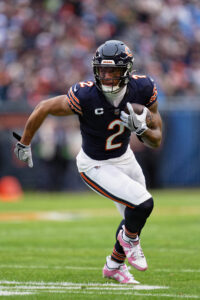 Moore, 27, said he did not shoot for a Justin Jefferson-level payday; the seventh-year player still did very well. Moore’s total guarantee number ($82.6MM) trails only Jefferson and A.J. Brown — as if we needed even more components impacting Brandon Aiyuk‘s endless 49ers negotiations — and the Bears structured this contract like a team that has a rookie QB deal around which to build. Moore’s cap number jumps from $7.2MM to $24.9MM from 2024-25, and this through-2029 contract — two seasons remained on his 2022 Panthers extension — does not include any void years.
Moore, 27, said he did not shoot for a Justin Jefferson-level payday; the seventh-year player still did very well. Moore’s total guarantee number ($82.6MM) trails only Jefferson and A.J. Brown — as if we needed even more components impacting Brandon Aiyuk‘s endless 49ers negotiations — and the Bears structured this contract like a team that has a rookie QB deal around which to build. Moore’s cap number jumps from $7.2MM to $24.9MM from 2024-25, and this through-2029 contract — two seasons remained on his 2022 Panthers extension — does not include any void years.
The Bears guaranteed Moore’s 2024 and ’25 base salaries but have some flexibility beyond that. Moore’s age and production history should make this $27.5MM-per-year deal a win for the Bears, who secured four more seasons of control and would only be on the hook for prorated signing bonus money if they moved on post-2025. Seeing as Moore is a rare No. 1 wide receiver to stop through Chicago, any departure rumors can be tabled into the late 2020s. The Maryland alum’s deal will overlap with Williams and Rome Odunze‘s rookie contracts for at least three years.
More than four months earlier, the Bears reached a quick resolution with Johnson. They did so despite allowing Johnson’s camp to negotiate with other teams at the 2023 trade deadline. The Bears were not satisfied with any trade offers, wanting a first- or second-round pick for a player who had not shown All-Pro-level form from 2020-22. Interest from multiple teams ensued, but Poles soon affirmed he wanted Johnson in the fold long term.
The Bears and Chiefs snapped a notable drought of cornerback franchise tags; the Rams’ second Trumaine Johnson tag (2017) represented the most recent such move coming into this offseason. While the Chiefs tagged L’Jarius Sneed to fetch draft capital in a trade — as the NFL’s latest dynasty operates around one-contract CBs — the Bears had more room to pay their tagged cover man.
 Poles has made his stamp on this defense, having now given high-end contracts to defenders on all three levels. The third-year GM paid Tremaine Edmunds and Montez Sweat last year and re-upped Johnson days before free agency. Johnson had expressed some frustration Sweat was paid first despite his midseason arrival and mentioned an aim at becoming the NFL’s highest-paid corner. The Bears did not give in there, but the former second-round pick — after a well-timed breakout — did well in terms of guarantees.
Poles has made his stamp on this defense, having now given high-end contracts to defenders on all three levels. The third-year GM paid Tremaine Edmunds and Montez Sweat last year and re-upped Johnson days before free agency. Johnson had expressed some frustration Sweat was paid first despite his midseason arrival and mentioned an aim at becoming the NFL’s highest-paid corner. The Bears did not give in there, but the former second-round pick — after a well-timed breakout — did well in terms of guarantees.
After subsequent deals for Sneed, Tyson Campbell and AJ Terrell, Johnson’s AAV sits 10th among corners. It is a bit unusual for a franchise-tagged player to settle for such placement, but Johnson secured $43.8MM fully guaranteed — fourth among corners — and $54MM guaranteed in total (seventh). This is also a clean contract, with no void years involved and the former second-round pick’s 2026 guarantee not vesting until that year. Johnson’s 2024 and ’25 base salaries are guaranteed; the fifth-year CB is due $44MM in that span. That is more than two tags would have covered, explaining how the Bears finalized this deal so quickly.
Pro Football Focus graded Johnson first overall among corners, and Pro-Football-Reference’s coverage metrics backed that up. After allowing passer ratings (as the closest defender) north of 94.0 from 2020-22, Johnson checked in with a 50.9 number last season — a four-INT slate that produced a second-team All-Pro honor. The Bears are confident this was not merely a contract-year outlier; they will count on Johnson to anchor their mid-2020s secondaries.
Trades:
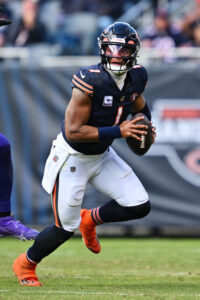 Although feigned debate surfaced about this decision, those in the league never seemed to be convinced the Bears strongly considered passing on Williams to keep Fields. The Bears wanted a Day 2 pick for their three-year starter, a player around whom they themed the 2023 trade (which moved them out of C.J. Stroud/Bryce Young territory), and the Falcons were floated as a possibility. The Fields market turned out to be ice cold. If now-starter Russell Wilson can hold off the younger passer and play 50% of the Steelers’ 2024 snaps, the Bears will only collect a 2025 sixth. Fields reaching the 51% play-time barrier would give Chicago Pittsburgh’s 2025 fourth.
Although feigned debate surfaced about this decision, those in the league never seemed to be convinced the Bears strongly considered passing on Williams to keep Fields. The Bears wanted a Day 2 pick for their three-year starter, a player around whom they themed the 2023 trade (which moved them out of C.J. Stroud/Bryce Young territory), and the Falcons were floated as a possibility. The Fields market turned out to be ice cold. If now-starter Russell Wilson can hold off the younger passer and play 50% of the Steelers’ 2024 snaps, the Bears will only collect a 2025 sixth. Fields reaching the 51% play-time barrier would give Chicago Pittsburgh’s 2025 fourth.
Poles, of course, did not draft Fields. That would have made it borderline insane had the third-year GM passed on a second straight No. 1 overall pick. The Panthers throwing Young into a terrible spot became the Bears’ golden ticket, with Chicago benefiting from the lowest point in Carolina’s history.
Poles labeled Fields’ murky status exiting the season a unique situation, and the Bears were then tied to wanting a historic haul for the top pick. No real noise about Fields having a shot to stick in the Windy City emerged henceforth, and while the Bears may or may not have passed on other offers to do right by the former No. 11 pick, it is hard to believe they rejected a significantly superior proposal. The four other teams to discuss Fields with the Bears viewed him as a backup.
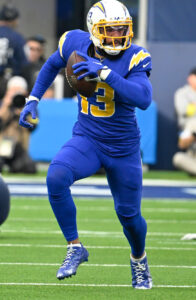 That said, Fields (23rd in 2023 QBR) would probably still be the Bears’ quarterback had Young elevated the Panthers out of the NFL basement. Though, the Bears landing the Nos. 2 or 3 picks via the Panthers may still have resulted in them dealing Fields and starting over with Jayden Daniels or Drake Maye. Fortunately for Poles, his decision proved easier. The Steelers passed on Fields’ fifth-year option, and the electric runner/sack-prone passer will not be extended in 2024. Fields looks to have a shot at sticking with the Steelers via a 2025 re-signing, but he will need to overtake Wilson and show growth.
That said, Fields (23rd in 2023 QBR) would probably still be the Bears’ quarterback had Young elevated the Panthers out of the NFL basement. Though, the Bears landing the Nos. 2 or 3 picks via the Panthers may still have resulted in them dealing Fields and starting over with Jayden Daniels or Drake Maye. Fortunately for Poles, his decision proved easier. The Steelers passed on Fields’ fifth-year option, and the electric runner/sack-prone passer will not be extended in 2024. Fields looks to have a shot at sticking with the Steelers via a 2025 re-signing, but he will need to overtake Wilson and show growth.
One of this era’s premier route-running technicians, Allen joins the Bears ahead of his age-32 season. The Bears landed the 11-year Charger despite interest from the Texans and Jets emerging; those teams circled back to other vets, while Allen began a contract year in Chicago.
The new Bolts regime offered Allen an extension, but the receiver’s camp labeled the proposal a pay cut. Allen remains tied to the $20MM-per-year deal he signed in 2020, and while he is open to an extension, the Bears now have Moore and Odunze signed long term. Even with Williams on a rookie deal, the team paying Allen even midlevel money beyond 2024 would be somewhat difficult. After all, the team has also paid a running back (D’Andre Swift) and tight end (Cole Kmet).
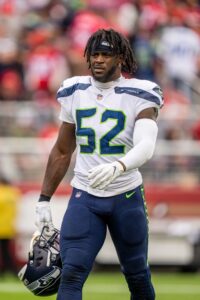 Allen is a six-time Pro Bowler who has excelled in the slot and on the perimeter. A strong Bears season could vault the former third-rounder from the Hall of Very Good tier to a player with a viable Canton case. As it stands, Williams will have one of the game’s best separators — ESPN’s Open Score metric placed Allen first in 2023 — to target in Year 1. Allen showed scant decline signs last season, averaging a career-best 95.6 yards per game and surpassing 1,200 for just the second time in a season. He got there in 13 games. The Bears will hope to extract one more prime-level year from the aging talent.
Allen is a six-time Pro Bowler who has excelled in the slot and on the perimeter. A strong Bears season could vault the former third-rounder from the Hall of Very Good tier to a player with a viable Canton case. As it stands, Williams will have one of the game’s best separators — ESPN’s Open Score metric placed Allen first in 2023 — to target in Year 1. Allen showed scant decline signs last season, averaging a career-best 95.6 yards per game and surpassing 1,200 for just the second time in a season. He got there in 13 games. The Bears will hope to extract one more prime-level year from the aging talent.
Bates remains on the Bears-built contract from 2022, when the Bills matched an offer sheet early in Poles’ GM tenure. The Bills used Bates as a 2022 starter but demoted him to a full-time backup last season. Bates, 27, battled Coleman Shelton for the center job but has missed time due to an undisclosed injury. Bates looks like the Bears’ sixth man up front when he recovers.
Taylor flashed in Seattle, posting 9.5 sacks and forcing four fumbles in 2022. He also totaled at least 5.5 sacks in each of his three healthy seasons. The former second-rounder, due for unrestricted free agency in 2025, has a chance to boost his value as a Montez Sweat sidekick.
Free agency additions:
- D’Andre Swift, RB. Three years, $24MM ($14MM guaranteed)
- Kevin Byard, S. Two years, $15MM ($7.39MM guaranteed)
- Gerald Everett, TE. Two years, $12MM ($6.06MM guaranteed)
- Coleman Shelton, C. One year, $3MM ($1.75MM guaranteed)
- Jonathan Owens, S. Two years, $3.8MM ($1MM guaranteed)
- Jacob Martin, DE. One year, $1.29MM ($668K guaranteed)
- DeAndre Carter, WR. One year, $1.2MM ($450K guaranteed)
- Matt Pryor, OL. One year, $1.18MM ($50K guaranteed)
- Scott Daly, LS. Practice squad
The Bears joined the Eagles, Texans and others in entering the Saquon Barkley sweepstakes, and while Giants GM Joe Schoen indicated on Hard Knocks that Chicago had driven up the two-time Pro Bowler’s price, it looked to be a Philly negotiation that defined the running back market’s early hours. The Eagles were looking into re-signing Swift but saw his price point move past their comfort zone, and they pivoted to Barkley, whom Howie Roseman‘s team clearly viewed on a higher tier. Swift became the 2024 UFA market’s first commit, as the Bears continued to load up a roster around another rookie-scale QB contract.
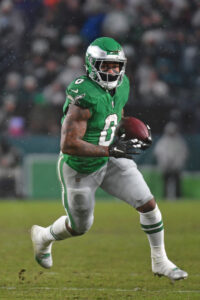 Familiar with Swift from his Lions days, the Bears gave him the second-most money among UFA backs this year. Swift’s $14MM guarantee at signing outflanked Josh Jacobs, Derrick Henry, Devin Singletary and Aaron Jones. The ex-Detroit second-rounder’s age (25) and lighter workload by comparison to the other available backs undoubtedly boosted his stock. Swift will begin his Bears tenure with 788 career touches. Injuries were an issue for the Georgia alum in Detroit, which fetched barely a fourth-rounder in a 2023 trade.
Familiar with Swift from his Lions days, the Bears gave him the second-most money among UFA backs this year. Swift’s $14MM guarantee at signing outflanked Josh Jacobs, Derrick Henry, Devin Singletary and Aaron Jones. The ex-Detroit second-rounder’s age (25) and lighter workload by comparison to the other available backs undoubtedly boosted his stock. Swift will begin his Bears tenure with 788 career touches. Injuries were an issue for the Georgia alum in Detroit, which fetched barely a fourth-rounder in a 2023 trade.
Swift stayed healthy in Philly, booking a Pro Bowl nod after 1,049-yard rushing season. The former No. 35 overall pick also has two seasons (2020, ’22) in which he ranked in the top 10 among RBs in yards per catch, with the Lions using him as more of a dual threat compared to the Eagles. The Bears figure to take advantage of Swift’s multipurpose skillset, with the upper-middle-class RB contract pairing with Khalil Herbert and Roschon Johnson‘s rookie deals.
Byard joins Swift in coming from Philly, though the Eagles had cut the former All-Pro. Considering what happened on the safety market this offseason, Byard did well. As fellow cap casualties Quandre Diggs, Jamal Adams, Marcus Maye and Eddie Jackson all took one-year deals worth less than $4MM, Byard saw his guarantee approach where Justin Simmons‘ market went. The four-time All-Pro scored $7.5MM guaranteed from the Falcons. Byard, 31, has two first-team All-Pro distinctions on his resume (2017, 2021) and will provide a cheaper solution to Jackson’s Ryan Pace-authorized extension. Despite Byard’s involvement in the Eagles’ late-season collapse, Pro Football Focus rated him 22nd among safeties last year.
Read more
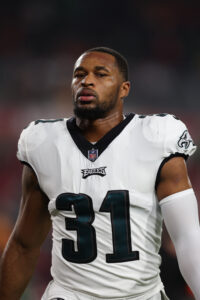 Bates may have been the early favorite to win the Bears’ center job. While the ex-Bills blocker may resurface, his recent injury looks to seal the competition for Shelton. The former Rams UDFA did not generate too much interest in free agency. The Rams had wanted to retain Shelton, but they made much bigger investments (re-signing Kevin Dotson, adding Jonah Jackson) that ended up moving Steve Avila to center and sending their incumbent elsewhere. Shelton started every Rams game last season and can use his age-29 campaign to either make a case as a multiyear Bears snapper or raise his 2025 free agency stock. PFF slotted Shelton 17th among centers in 2023.
Bates may have been the early favorite to win the Bears’ center job. While the ex-Bills blocker may resurface, his recent injury looks to seal the competition for Shelton. The former Rams UDFA did not generate too much interest in free agency. The Rams had wanted to retain Shelton, but they made much bigger investments (re-signing Kevin Dotson, adding Jonah Jackson) that ended up moving Steve Avila to center and sending their incumbent elsewhere. Shelton started every Rams game last season and can use his age-29 campaign to either make a case as a multiyear Bears snapper or raise his 2025 free agency stock. PFF slotted Shelton 17th among centers in 2023.
In addition to securing Simone Biles cameos via Owens, the Bears brought another Everett-Shane Waldron reunion. Everett spent the past two years as a Justin Herbert auxiliary target, but from 2017-21, he played under Waldron with the Rams and Seahawks. The former second-round pick has been a serviceable tight end. The receiving option, who snared the game-winning TD in 2018’s Chiefs-Rams Monday Night Football classic, has eclipsed 400 receiving yards four times as a pro. Everett teamed with Tyler Higbee in Los Angeles and Will Dissly in Seattle. Looking to have a familiar role planned for the 30-year-old talent, the Bears have yet another veteran pass catcher in place to help Williams.
Re-signings:
Drafted in the same class as 2024 Hall of Famer Devin Hester, Lewis will become the first pure tight end in NFL history to play either an age-40 season or an 19th NFL campaign. He is back in Chicago despite the Bears changing offensive staffs. Lewis will be tasked with helping Chicago’s O-line clear space for Swift and Co. The 2006 first-round pick logged 332 offensive snaps last season. While Waldron will have some receiving options at tight end, PFF ranked Lewis fifth at the position in run blocking. The Bears will have some work to do in making sure they get enough use out of Lewis and Everett.
The Bears’ longest-tenured player by a wide margin, Scales needs back surgery and is on IR with a return designation. Daly, who snapped for the Lions from 2021-23, is aboard as a replacement.
Notable losses:
- Dan Feeney, OL
- D’Onta Foreman, RB
- Trenton Gill, P (waived)
- Rasheem Green, DE
- Eddie Jackson, S (released)
- Justin Jones, DT
- Darnell Mooney, WR
- Yannick Ngakoue, DE
- Lucas Patrick, OL
- Nathan Peterman, QB
- Equanimeous St. Brown, WR
- Trent Taylor, WR
- Robert Tonyan, TE
- Cody Whitehair, OL (released)
Two more Pace-era bastions, Jackson and Whitehair, were shown the door to create cap space. Jackson spent seven seasons in Chicago, Whitehair eight. Both were successful Pace picks, each booking at least one Pro Bowl honor and starting for the two Matt Nagy playoff teams. A 2018 All-Pro, Jackson helped that Vic Fangio-coordinated defense lead the league. Whitehair started 118 games in Chicago, playing guard and center, but was benched last season. The Bears saved more than $21MM by releasing the veterans; Whitehair and Jackson respectively caught on with the Raiders and Ravens.
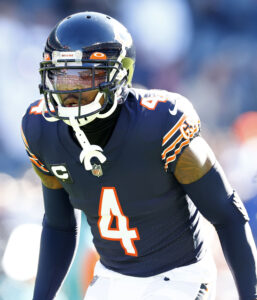 A few rumors about a Bears-Ngakoue reunion emerged this offseason, with the most recent coming earlier this month. Chicago instead traded for Taylor, who comes cheaper than where Ngakoue likely views his market.
A few rumors about a Bears-Ngakoue reunion emerged this offseason, with the most recent coming earlier this month. Chicago instead traded for Taylor, who comes cheaper than where Ngakoue likely views his market.
The Bears gave Ngakoue a one-year, $10MM deal in 2023, and the nomadic edge rusher saw his seven-year streak of eight-plus-sack seasons end. The former Jaguars, Vikings, Ravens, Raiders and Colts sack artist totaled four (and just seven QB hits) before suffering a broken ankle. Ngakoue probably will catch on somewhere soon, but the 29-year-old defender may be waiting for an injury to shake up a team’s depth chart.
Mooney did not seem to fit in Luke Getsy‘s offense, as he followed up a 1,000-yard year in Nagy’s finale to combining for 907 from 2022-23. While miscast as a Bears top option in 2022, Mooney still commanded a market that also may have been indicative of the league’s view of Fields. The Falcons needed to match the Jags’ Gabe Davis deal (three years, $39MM) to land Mooney, giving Kirk Cousins a deep threat opposite Drake London. The Bears have upgraded their receiving corps significantly, however, with the draft being the second part of that effort.
Draft:
This draft featured six first-round QBs, but in the weeks leading up to the event, only five came up in rumors pertaining to landing spots. While a rumor about the Raiders pursuing the No. 1 pick emerged — potentially to reunite Antonio Pierce with Jayden Daniels, which came up a lot this offseason — the Bears mostly coasted to the pre-draft finish line. Williams had long been the runaway favorite to go No. 1, with his 2023 statistical step back not as notable as the regression Drake Maye saw.
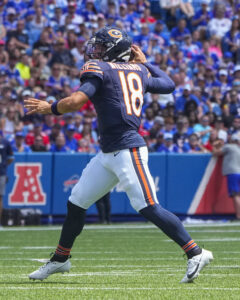 Williams still operated with high efficiency, finishing with 30 TD passes and five INTs; his 9.4 yards per attempt was better than his Heisman-year mark (9.1). USC losing five of its final six regular-season games generated more scrutiny on a player who was benefiting from NIL cash and under a spotlight that comes from being viewed as the consensus top prospect.
Williams still operated with high efficiency, finishing with 30 TD passes and five INTs; his 9.4 yards per attempt was better than his Heisman-year mark (9.1). USC losing five of its final six regular-season games generated more scrutiny on a player who was benefiting from NIL cash and under a spotlight that comes from being viewed as the consensus top prospect.
Rumors about Williams’ Combine interviews being “just OK” came out, but the Bears viewed a wide gap between Williams and this draft’s other QBs. The three-year Lincoln Riley starter has looked the part during Bears summer work. That came after an interesting attempt to secure a no-franchise tag clause in his rookie contract failed.
Chicago’s menacing defense carried Rex Grossman to a Super Bowl — in a down NFC year — while Jay Cutler went 1-for-8 in playoff appearances as a starter. Each was preferable to the infamy Mitch Trubisky caused (due to another QB that came off the board in 2017), and Fields’ passing issues undercut his run-game brilliance. The Bears have been starved here since Jim McMahon injury trouble sidetracked a would-be 1980s dynasty. They now have at least three years of Williams on a rookie-scale deal. Considering Poles had already begun to build around Fields’ rookie contract, the team has a rare opportunity to keep paying veterans to help its developing quarterback.
The Bears were high on Odunze from the start. Poles attempted to trade up one spot (via the Falcons) but did not end up needing to do so. The Jets were believed to be targeting Odunze as well, but their trade-up efforts did not succeed. The Odunze pick also came after Poles divided his front office staff into pods to debate whether to select a receiver, defensive end or tackle in Round 1. The receiver camp won out, and Odunze is on track to start alongside Moore and Allen.
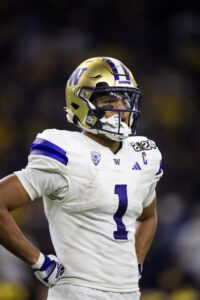 Coming off two 1,000-yard seasons in Ryan Grubb‘s Washington offense, Odunze powered the Huskies to the national championship game. The 216-pound target compiled 10 100-yard games, including a 125-yard showing to down Texas in the CFP semis, and led Division I-FBS with 1,640 yards.
Coming off two 1,000-yard seasons in Ryan Grubb‘s Washington offense, Odunze powered the Huskies to the national championship game. The 216-pound target compiled 10 100-yard games, including a 125-yard showing to down Texas in the CFP semis, and led Division I-FBS with 1,640 yards.
This may well be the best receiving corps in Bears history. The Brandon Marshall–Alshon Jeffery overlap probably wins out right now, but Allen’s track record and Odunze’s potential bring a floor-ceiling combination to pair with Moore’s consistency. Odunze holds the key to unlocking the group’s full potential, and the Pac-12 standout will likely lead other Bears nuclei at receiver during his Windy City career.
Booker flashed during preseason play, and Taylor’s arrival quickly prompted the Bears to cut two-year incumbent Trenton Gill. Amegadjie came off the active/NFI list in mid-August, rehabbing a torn quad. He profiles as a developmental piece for a Bears team, having played guard and tackle in the Ivy League.
Other:
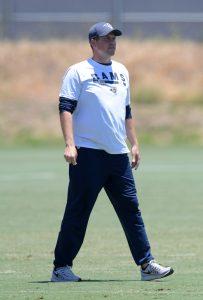 It can be argued Getsy was not supplied with necessary pieces to succeed; that certainly was the case in 2022. Moore’s arrival helped, and Fields made some progress as a passer in 2023. The Bears ranked 18th in scoring offense last season and 22nd in DVOA, with the Tyson Bagent stretch hurting those numbers. With Eberflus hot-seat rumors circulating, he cut the cord on his two-year OC. The Seahawks then let Waldron make a lateral move, not blocking any contracted assistants due to Pete Carroll‘s ouster.
It can be argued Getsy was not supplied with necessary pieces to succeed; that certainly was the case in 2022. Moore’s arrival helped, and Fields made some progress as a passer in 2023. The Bears ranked 18th in scoring offense last season and 22nd in DVOA, with the Tyson Bagent stretch hurting those numbers. With Eberflus hot-seat rumors circulating, he cut the cord on his two-year OC. The Seahawks then let Waldron make a lateral move, not blocking any contracted assistants due to Pete Carroll‘s ouster.
Ex-Seahawks QBs coach Dave Canales has received much of the credit for Geno Smith‘s surprising re-emergence, but Waldron called the plays in Seattle throughout his tenure. Smith led the NFL in completion percentage in 2022, setting a Seahawks passing yardage record that year as well. Seattle’s offense declined a bit last year, dropping from ninth to 17th in scoring and 13th to 21st in yardage, but Waldron (45) also met with the Patriots and Saints about their play-calling gigs. He also comes from the NFL’s most popular active coaching tree, having worked under Sean McVay for four years.
Washington, 54, spent four years on Sean McDermott‘s Bills staff. The veteran assistant also worked with McDermott in Carolina. This is Washington’s second shot at a DC post, having been named to the Panthers’ position in 2018. That tenure ended poorly, with David Tepper firing Ron Rivera and Washington’s defense ending the year 31st in Luke Kuechly‘s final season. Washington’s previous Carolina unit ranked 19th in scoring, and the Bills have continued to crank out top-five defenses despite regular personnel losses. Eberflus, however, will remain Chicago’s play-caller after taking the reins upon Alan Williams‘ abrupt early-season exit.
 Like Jaylon Johnson last year, Jenkins has expressed interest in a long-term Bears deal. The organization, which has only one notable expense on its O-line (Nate Davis‘ four-year, $40MM deal), is sitting tight for now. The Bears have seen Jenkins shift from a shaky tackle to a promising guard, but they are not planning to enter serious negotiations until at least their Week 7 bye. Poles allowed Johnson’s agent to seek a trade as negotiations stalled midway through last season; it will be interesting to see if the Bears can hammer out a deal with Jenkins.
Like Jaylon Johnson last year, Jenkins has expressed interest in a long-term Bears deal. The organization, which has only one notable expense on its O-line (Nate Davis‘ four-year, $40MM deal), is sitting tight for now. The Bears have seen Jenkins shift from a shaky tackle to a promising guard, but they are not planning to enter serious negotiations until at least their Week 7 bye. Poles allowed Johnson’s agent to seek a trade as negotiations stalled midway through last season; it will be interesting to see if the Bears can hammer out a deal with Jenkins.
During a rare non-human interest story-like reveal during Hard Knocks‘ training camp edition, Poles said he wanted to have a contract in place with Judon before agreeing to acquire him. Receiving third-round offers from the Bears and Falcons, the Patriots gave Judon a choice on what team he wanted to join. Contract matters may have been a sticking point, as the veteran edge rusher has oddly gone from an extension-seeking Patriot to a player not seemingly too eager for a Falcons deal. Atlanta does hold exclusive negotiating rights with Judon until March, but a disconnect between he and the Bears may have provided the difference. As it stands, the Bears will need contributions from multiple young DEs opposite Sweat.
Top 10 cap charges for 2024:
- Montez Sweat, DE: $25.09MM
- Keenan Allen, WR: $23.1MM
- Tremaine Edmunds, LB: $22.44MM
- Jaylon Johnson, CB: $13MM
- Cole Kmet, TE: $11.6MM
- Nate Davis, G: $11.35MM
- DeMarcus Walker, DE: $8.67MM
- T.J. Edwards, LB: $7.5MM
- D.J. Moore, WR: $7.2MM
- Caleb Williams, QB: $7.18MM
The Bears are building around a first-round QB for the third time since 2017. Considering the team joined the Panthers in passing on Stroud last year, it faces pressure for Williams to finally be the franchise QB it has pined for over the past few decades. Williams’ arrival coincides with Jordan Love‘s Packers extension and the Lions’ rise around Brad Holmes‘ core. Williams injecting life into the Bears’ operation would not only boost Eberflus’ hopes of sticking around beyond Year 3, it would make the NFC North — long an Aaron Rodgers-controlled division that featured occasional Bears or Vikings spurts — rather captivating.
Chicago’s mid-2000s defensive nucleus notwithstanding, the team has not assembled a steady contender since Mike Ditka‘s departure. Williams’ arrival, along with this rare roster-building opportunity that sees Poles’ Fields pieces shift to another rookie’s supporting cast, gives the Bears hope on this front. This season does not need to necessarily produce a Super Bowl contender for it to be deemed a success, but Williams making immediate strides would vault the Bears into a must-follow operation in the NFC’s big picture entering 2025.
By Sam Robinson |
at August 25, 2024 11:13 pm
All due respect to the Barry Sanders– and Erik Kramer-driven 1991 season, last year brought the Lions’ most successful slate since their 1957 championship campaign. Narrowly missing their first Super Bowl berth, the Lions still moved their rebuild — one that featured a 3-13-1 team in 2021 — to the NFC championship game. The Brad Holmes–Dan Campbell operation has changed the franchise’s trajectory, making good on the hype the 2023 offseason brought.
As Detroit attempts to kick down the door and book its first Super Bowl berth, its payroll changed significantly. The equation now includes big-ticket contracts for Jared Goff and other cornerstones, but last year’s draft class infused the roster with impact talent that will be tied to rookie deals for a bit. Campbell’s team will try to capitalize on the combination of rookie-contract talent and lower Year 1 cap numbers for its recently extended stars.
Extensions and restructures:
Goff became the first domino to fall this offseason on the quarterback market, and the former No. 1 overall pick is now the oldest member of the $50MM-per-year club. The only $50MM-per-year passer north of 27, Goff (30 in October) has completed a remarkable turnaround. The Lions needed to take on Goff’s 2019 Rams extension to collect the two-first-rounder package from the Rams for Matthew Stafford. Rather than Goff being the bridge QB most assumed, the five-year Los Angeles starter turned his career around in Detroit. The Lions have protected Goff with a top-flight offensive line, and Amon-Ra St. Brown has become a No. 1 target. This has stabilized the career of a passer who did not fare well in his first Lions season.
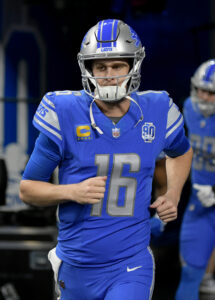 Holmes continually resisted labeling Goff a stopgap, and the Lions then benefited from what became a team-friendly contract over the past two seasons. Goff played well on his $33.5MM-per-year Rams deal, ranking fifth and 11th in QBR during Ben Johnson‘s play-calling years. The Lions passed on the 2021 first-round QB contingent, instead taking Penei Sewell to protect Goff in Round 1. A maligned 2022 first-round QB crop followed, and the Lions took Aidan Hutchinson and Jameson Williams. After Goff’s promising 2022, Detroit continued to build around him rather than take the traditional route and find a younger arm at a rookie-scale rate.
Holmes continually resisted labeling Goff a stopgap, and the Lions then benefited from what became a team-friendly contract over the past two seasons. Goff played well on his $33.5MM-per-year Rams deal, ranking fifth and 11th in QBR during Ben Johnson‘s play-calling years. The Lions passed on the 2021 first-round QB contingent, instead taking Penei Sewell to protect Goff in Round 1. A maligned 2022 first-round QB crop followed, and the Lions took Aidan Hutchinson and Jameson Williams. After Goff’s promising 2022, Detroit continued to build around him rather than take the traditional route and find a younger arm at a rookie-scale rate.
These decisions meant Goff would need to be extended, with Holmes indicating the quarterback he once helped draft as the Rams’ college scouting director had earned a new deal. The Lions made Goff the NFL’s second-highest-paid player (for a few weeks, at least), striking first to help set the market for Trevor Lawrence, Tua Tagovailoa and Jordan Love. Of the eight $50MM-AAV clubbers, only Goff is on a third contract. That separates his situation from the pack, but the Lions continue to show belief in a player Sean McVay discarded.
Beating Stafford’s Rams in a wild-card game, edging the Buccaneers and then pushing the 49ers to the brink, Goff secured quality terms on his deal — even if Lawrence and Love passed him in AAV months later. The popular rolling guarantee structure is in place here, with Goff set to see $20MM of his $35MM 2026 base salary guarantee in 2025. More than a third of Goff’s 2027 base salary ($50MM) will lock in a year early as well. The Lions are betting big on a player who arrived as a depressed asset, but they went to work on ensuring their other early-2020s pillars would remain in the fold as well.
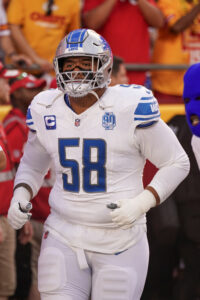 Perhaps best known for the five-QB first round that failed to produce franchise options, the 2021 draft nevertheless equipped the Lions with offensive cornerstones. After the Bengals chose Ja’Marr Chase over Sewell, the Lions pounced. Both players have become standouts. While Cincinnati is angling to pay Chase in 2025, Detroit stepped up early on a market-changing deal.
Perhaps best known for the five-QB first round that failed to produce franchise options, the 2021 draft nevertheless equipped the Lions with offensive cornerstones. After the Bengals chose Ja’Marr Chase over Sewell, the Lions pounced. Both players have become standouts. While Cincinnati is angling to pay Chase in 2025, Detroit stepped up early on a market-changing deal.
Sewell not only became the NFL’s highest-paid right tackle, he was the league’s top tackle earner at the time of signing. Although his contract changed the LT market — as the Buccaneers have since given Tristan Wirfs the highest tackle AAV — Sewell’s contract still checks in on its own level among RTs. His $28MM per-year number leads the RT pack by $8MM.
The Lions stationed Sewell at left tackle for much of 2021, keeping him at his college position, but that only occurred because of a Taylor Decker injury. Over the past two years, the Oregon product has become a dominant right tackle. Sewell’s RT move coincided with Goff’s late-20s rebound, as the Lions formed an elite O-line. Pro Football Focus ranked Detoit’s O-line eighth in 2022 and second last season. Sewell ranked sixth in pass block win rate last season and has made back-to-back Pro Bowls — not the easiest feat for a right tackle — along with earning a 2023 All-Pro first-team nod.
This should be a sound Lions move, as Sewell will not turn 24 until October. This should ensure his prime occurs in the Motor City. Sewell agreeing to a four-year contract also separates him from recently extended tackles Wirfs, Christian Darrisaw and Andrew Thomas. The Lions RT will likely be able to come back to the table during his late 20s, presenting the opportunity for two monster paydays.
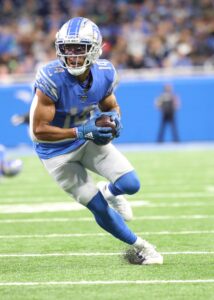 St. Brown will not turn 25 until October. At the rate receivers are being paid, his third contract will probably be north of $40MM per year when the time arrives. The Lions expected to have a franchise tackle when they chose Sewell; St. Brown provided a surprise.
St. Brown will not turn 25 until October. At the rate receivers are being paid, his third contract will probably be north of $40MM per year when the time arrives. The Lions expected to have a franchise tackle when they chose Sewell; St. Brown provided a surprise.
Arriving when the Lions were retooling at the position, the former fourth-round pick showed immediate promise and became entrenched in Detroit’s starting lineup during the team’s 2021 restart. Since his 912-yard rookie year, the tenacious wideout climbed to 1,161 and 1,514. The latter showing made St. Brown the Lions’ first All-Pro wideout since Calvin Johnson in 2013.
Giving midlevel deals to the likes of Golden Tate and Marvin Jones in between Megatron’s extension and the St. Brown deal, the Lions bided their time before reinvesting. They nabbed St. Brown, who has carried a perpetual chip on his shoulder due to being chosen 112th overall, and made him the NFL’s highest-paid receiver — at the time. St. Brown was linked to a $26-$28MM-per-year number during negotiations, but his camp inflated that figure by the time of signing.
St. Brown joined Tyreek Hill as the league’s only $30MM-per-year WRs, driving both A.J. Brown and Justin Jefferson to seek higher-end deals and affecting the markets of CeeDee Lamb, Brandon Aiyuk and Ja’Marr Chase. St. Brown’s deal includes $77MM guaranteed in total, with the USC alum’s $27.5MM 2026 base salary locking in by March 2025. After St. Brown played through a significant oblique injury last season, the Lions will hope he has another gear to hit during the mid-’20s.
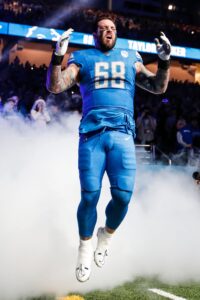 Holmes still found room to circle back to Decker, doing so despite the dependable left tackle arriving as a Bob Quinn pick and going into his age-30 season. Decker has started since his 2016 rookie year and turns 30 just this week. This marks the former first-rounder’s third NFL contract. Decker’s $20MM-per-year deal does not have rolling guarantee mechanisms like Goff, Sewell and St. Brown’s do, but he did well to lock in nearly $32MM at signing on a three-year accord.
Holmes still found room to circle back to Decker, doing so despite the dependable left tackle arriving as a Bob Quinn pick and going into his age-30 season. Decker has started since his 2016 rookie year and turns 30 just this week. This marks the former first-rounder’s third NFL contract. Decker’s $20MM-per-year deal does not have rolling guarantee mechanisms like Goff, Sewell and St. Brown’s do, but he did well to lock in nearly $32MM at signing on a three-year accord.
This season, Decker will move into third — behind only Jeff Backus and Lomas Brown — for starts by a Lions tackle. After toiling for some middling Lions teams late in Jim Caldwell‘s tenure and enduring another rebuild after the Matt Patricia hire bombed, Decker reemerged on a playoff squad. The Ohio State alum has not secured any Pro Bowl nods, but pass block win rate rated him seventh among all tackles in 2023. PFF also assigned Decker a ninth-place finish at the position last season. The Lions have their top-tier tackle pair signed through 2027.
The prices are rising here, but Detroit backloading the extensions keeps costs manageable for 2024. Goff’s cap number is only $27.2MM, St. Brown’s $4.86MM. Sewell and Decker respectively count just $8.2MM and $10.9MM.
Trades:
 The Lions’ cornerback situation would soon become more complicated, but they saw it prove unreliable on the field in 2023. (Aaron Glenn‘s pass defense ranked 27th.) This led to Detroit starting the league year by obtaining Davis, whose three-year, $45MM Tampa Bay contract expires after this season. Despite Davis being in a walk year, the Lions gave up a third-rounder in a pick-swap deal. Making corner a priority, the Lions subsequently paired the former Super Bowl starter with a host of new names.
The Lions’ cornerback situation would soon become more complicated, but they saw it prove unreliable on the field in 2023. (Aaron Glenn‘s pass defense ranked 27th.) This led to Detroit starting the league year by obtaining Davis, whose three-year, $45MM Tampa Bay contract expires after this season. Despite Davis being in a walk year, the Lions gave up a third-rounder in a pick-swap deal. Making corner a priority, the Lions subsequently paired the former Super Bowl starter with a host of new names.
Detroit also looked into L’Jarius Sneed and Marshon Lattimore, but Davis’ top complementary pieces soon came via the draft. A 2018 second-round pick, Davis has 75 starts on his resume and will not turn 28 until New Year’s Eve. He hit free agency as one of the top defenders available in 2022, but the Bucs paid Jamel Dean a year later.
Davis intercepted four passes during Tampa Bay’s Super Bowl-winning season and collectively held QBs to sub-58% completion rates (as the closest defender) in 2021 and ’22. Last season, that number climbed to 61.4%; PFF graded Davis 68th among CBs. The Lions will still bet on the defender excelling in Glenn’s scheme, and they hold exclusive negotiating rights with him until March.
Free agency additions:
- D.J. Reader, DT. Two years, $22MM ($7.43MM guaranteed)
- Kevin Zeitler, G. One year, $6MM ($5.49MM guaranteed)
- Amik Robertson, CB. Two years, $9.25MM ($4.5MM guaranteed)
- Marcus Davenport, OLB. One year, $6.5MM ($3MM guaranteed)
- Jake Bates, K. Two years, $1.98MM
- Kyle Peko, DT. One year, $1.21MM
- Ben Niemann, LB. One year, $1.13MM
- C.J. Moore, S. One year, $1.13MM
 Jonah Jackson served as the Lions’ second-longest-tenured O-line starter, holding that role from 2020-23, but proved too expensive — as could be expected, given the guard market and the Lions’ offseason extension plans — to retain. Enter Zeitler, who continues to excel for northern-based teams. The former Bengals first-rounder has remained a reliable piece for the Browns (2017-18), Giants (2019-20) and Ravens (2021-23). Zeitler is going into his age-34 season, but he snared his first Pro Bowl honor in 2023.
Jonah Jackson served as the Lions’ second-longest-tenured O-line starter, holding that role from 2020-23, but proved too expensive — as could be expected, given the guard market and the Lions’ offseason extension plans — to retain. Enter Zeitler, who continues to excel for northern-based teams. The former Bengals first-rounder has remained a reliable piece for the Browns (2017-18), Giants (2019-20) and Ravens (2021-23). Zeitler is going into his age-34 season, but he snared his first Pro Bowl honor in 2023.
This is a temporary solution, but the Lions nabbing one of this era’s most seasoned guards for $6MM probably represents a win — especially given what proven guards cost this offseason. Zeitler discussed terms with the Ravens, who had signed him following a Giants cut in 2021, but Baltimore opted to cut costs up front. PFF graded Zeitler as a top-15 guard in each of his three Ravens seasons, giving the Lions optimism he will be able to hold form into his mid-30s. Zeitler’s 181 career starts are also in the top 20 all time among guards, and the new Detroit RG leads the pack among active guards.
One of the league’s better run stuffers for years, Reader recently recovered from a second quad tear. The former Texans and Bengals nose tackle tore both quads during his Cincinnati tenure. In between, he anchored Cincinnati’s interior during back-to-back AFC championship game seasons. PFF rated Super Bowl LVI starter rated as a top-11 D-tackle in each of the past three seasons, and PFR’s top 50 free agent list placed him 25th.
Read more
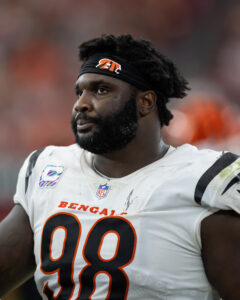 Reader just came off the active/PUP list Sunday. Even if the Lions ease their most expensive 2024 free agency acquisition into action, his addition will bolster a defense that already ranked second against the run. A Reader-Alim McNeill tandem promises to be formidable this season.
Reader just came off the active/PUP list Sunday. Even if the Lions ease their most expensive 2024 free agency acquisition into action, his addition will bolster a defense that already ranked second against the run. A Reader-Alim McNeill tandem promises to be formidable this season.
Counting on Davenport as anything more than a rotational player is risky. The former Saints first-rounder, who will indeed rejoin Glenn and Campbell, did not make it past mid-October last season with Minnesota and managed only a half-sack in 15 2022 games with New Orleans. Davenport does have nine- and six-sack seasons on his resume, registering three forced fumbles in those respective slates (2019, ’21).
Glenn and Campbell were in New Orleans for the inconsistent D-end’s 2019 showing, and while the team rosters James Houston and slow-to-develop second-rounder Josh Paschal, it did not draft any edges. Davenport, 28 next month, may well be counted on as Aidan Hutchinson‘s wingman.
The Lions’ Bates addition became more important after Michael Badgley‘s IR placement; a hamstring injury sidelined the veteran for the season. Bates, however, landed on the Lions’ radar during his UFL season. The Michigan Panthers kicker drilled three 60-plus-yard field goals and drew interest from the Commanders, Packers and Ravens as well.
Detroit changed kickers late in the season, moving from Riley Patterson to Badgley, though Campbell famously left the latter on the bench when attempting crucial fourth-down conversions in the NFC title game. Bates profiles as a boom-or-bust option. He went 6-for-7 on field goals in Lions preseason games but missed seven tries during the UFL campaign.
Re-signings:
- Graham Glasgow, G. Three years, $20MM ($8MM guaranteed)
- Jalen Reeves-Maybin, LB. Two years, $7.5MM ($5.25MM guaranteed)
- Emmanuel Moseley, CB. One year, $2.88MM ($1MM guaranteed)
- Michael Badgley, K. One year, $1.29MM ($425K guaranteed)
- Nate Sudfeld, QB. One year, $1.21MM ($300K guaranteed)
- Kindle Vildor, CB. One year, $1.29MM ($168K guaranteed)
- Donovan Peoples-Jones, WR. One year, $1.3MM ($125K guaranteed)
- Dan Skipper, OL. One year, $1.15MM
Glasgow completed quite the rebound effort back in Detroit. The former 2016 Lions third-rounder could not live up to his four-year, $40MM Broncos deal, being cut soon after Sean Payton‘s arrival. He landed back with the Lions on a one-year, $2.75MM pact. With Halapoulivaati Vaitai unable to stay healthy once again, Glasgow stepped in and contributed on a top-flight O-line. On the strength of his run blocking, PFF slotted the Michigan alum as a top-10 guard. After seeing Quinn Meinerz usurp him in Denver, Glasgow did well to land another deal ahead of his age-32 season. The Lions will have three 30-somethings up front now, with ninth- and 13th-year vets manning the guard posts.
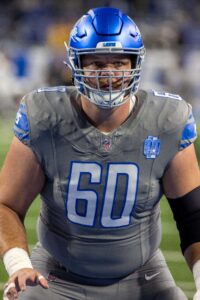 Sudfeld’s most notable NFL act remains his strange insertion into a Week 17 game that prompted tanking allegations. The player Doug Pederson used after controversially benching Jalen Hurts in a nationally televised game that decided the 2020 NFC East title, Sudfeld has nevertheless managed to bounce back from that and his season-ending injury last summer. Now in Year 3 as a Ben Johnson QB, Sudfeld spent last season on IR.
Sudfeld’s most notable NFL act remains his strange insertion into a Week 17 game that prompted tanking allegations. The player Doug Pederson used after controversially benching Jalen Hurts in a nationally televised game that decided the 2020 NFC East title, Sudfeld has nevertheless managed to bounce back from that and his season-ending injury last summer. Now in Year 3 as a Ben Johnson QB, Sudfeld spent last season on IR.
Despite this and the Lions using a third-round pick on Hendon Hooker, the veteran leads the race for Detroit’s QB2 gig. Hooker, whose November 2022 ACL tear affected his draft stock, will not be sent to waivers. But a developmental season — after 2023 became a rehab year — may be on tap. The Lions would stand to be vulnerable if Goff went down, but the ninth-year passer has been quite durable as a pro (four injury-driven absences).
In addition to Badgley, Moseley sustained a significant injury already. After suffering ACL tears in 2022 and ’23, the former 49ers starter sustained a torn pec early in camp. Robertson’s guarantee figured to give him the edge on Moseley, with the ex-Raider now being needed more. Reeves-Maybin’s off-field job is now more important than his role as a Lions backup/special-teamer; he is now the NFLPA president.
Notable losses:
- Tyson Alualu, DT
- Teddy Bridgewater, QB (retired)
- Anthony Firkser, TE
- C.J. Gardner-Johnson, S
- Charles Harris, OLB
- Will Harris, DB
- Jonah Jackson, G
- Jerry Jacobs, CB (nontendered)
- Benito Jones, DL
- Romeo Okwara, OLB
- Josh Reynolds, WR
- Cameron Sutton, CB (post-June 1 cut)
- Halapoulivaati Vaitai, G
- Tracy Walker, S (released)
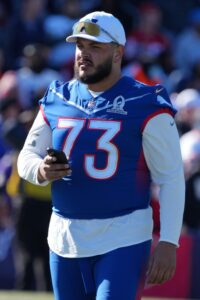 The Lions expressed some hope they could retain Jackson days before free agency but balked upon learning where his market was. The Rams came in with a three-year, $51MM deal to pair him with fellow high-priced guard Kevin Dotson. Following Glasgow as a third-round success story, Jackson started every game he played as a Lion. No substantial extension talks transpired in 2023, despite Jackson expressing hope he would remain in Detroit. Higher Lions priorities appear to have impacted that aim. Jackson’s exit will make guard a long-term need, but for now, vets have it covered.
The Lions expressed some hope they could retain Jackson days before free agency but balked upon learning where his market was. The Rams came in with a three-year, $51MM deal to pair him with fellow high-priced guard Kevin Dotson. Following Glasgow as a third-round success story, Jackson started every game he played as a Lion. No substantial extension talks transpired in 2023, despite Jackson expressing hope he would remain in Detroit. Higher Lions priorities appear to have impacted that aim. Jackson’s exit will make guard a long-term need, but for now, vets have it covered.
Sutton did not impress after signing a three-year, $33MM deal; PFF rated the six-year Steeler outside the top 100 at corner in 2023. As the Lions made in-season tweaks at the position, they kept trotting out Sutton. He was set to return, but a domestic violence arrest — which featured a multi-week period in which police were searching for the veteran cornerback — led him off the roster. The Lions will take on $4.2MM in dead money this year and $6.5MM in 2025. Sutton ended up back with the Steelers but received an eight-game suspension.
Largely due to injury, Gardner-Johnson also did not make much of an impact as a Lion. The would-be safety starter sustained a torn pec in Week 2, and although he made it back by Week 18, he did not return as a starter. The Lions let Gardner-Johnson walk in free agency, where the Eagles — who had aimed to keep him in 2023 — awaited. CJGJ’s injury-shortened season still resulted in a raise from his one-year, $6.5MM pact; the Eagles gave him a three-year, $27MM deal with $10MM guaranteed.
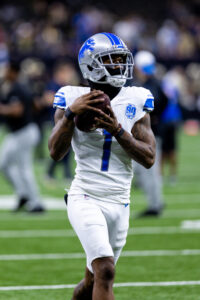 The Lions made an offer to retain Reynolds, who has spent all but a few games in his career as a Goff auxiliary target. The Broncos came in with a better one, however, landing the 29-year-old weapon on a two-year, $9MM deal. The Lions passed on a notable Reynolds proposal in an effort to clear the runway for Jameson Williams. Detroit’s offer was indicative of the WR3 role it had in mind for Reynolds, with Williams — who has seen an ACL tear and a gambling suspension hold him back for most of his career — ticketed for more work. Reynolds’ NFC title game struggles aside, he finished with 608 receiving yards (15.2 per catch) and five TDs last year.
The Lions made an offer to retain Reynolds, who has spent all but a few games in his career as a Goff auxiliary target. The Broncos came in with a better one, however, landing the 29-year-old weapon on a two-year, $9MM deal. The Lions passed on a notable Reynolds proposal in an effort to clear the runway for Jameson Williams. Detroit’s offer was indicative of the WR3 role it had in mind for Reynolds, with Williams — who has seen an ACL tear and a gambling suspension hold him back for most of his career — ticketed for more work. Reynolds’ NFC title game struggles aside, he finished with 608 receiving yards (15.2 per catch) and five TDs last year.
The team did not do much to replace Reynolds, as Kalif Raymond‘s two-year, $10.5MM deal from 2023 gives him a runway toward this gig. This looms as one of the few questions on this well-assembled roster, but Raymond does have three straight seasons of at least 475 yards — including a 616-yard 2022 season as Williams rehabbed his college knee injury — as evidence he could be up to the challenge.
Draft:
- Round 1, No. 24 (from Cowboys): Terrion Arnold (CB, Alabama) (signed)
- Round 2, No. 61: Ennis Rakestraw Jr. (CB, Missouri) (signed)
- Round 4, No. 126 (from Packers through Jets): Giovanni Manu (T, British Columbia) (signed)
- Round 4, No. 132 (from 49ers through Eagles): Sione Vaki (S, Utah) (signed)
- Round 6, No. 189 (from Broncos through Rams, Bills and Texans): Mekhi Wingo (DT, LSU) (signed)
- Round 6, No. 201 (from Buccaneers): Christian Mahogany (G, Boston College) (signed)
Sutton’s release made cornerback the Lions’ semi-obvious draft direction, and the team met with a few before making its move. The Lions moved up five spots for Arnold, viewing the Packers as a threat to nab the former Nick Saban pupil. Detroit traded one spot in front of Green Bay, giving up a third-round pick (No. 73) to make the jump. Arnold is ticketed for a starting role immediately; the Lions will hope this CB investment works out better than Quinn’s first-round finale (Jeff Okudah).
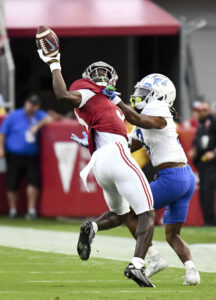 Arnold leapfrogged teammate Kool-Aid McKinstry, who also visited the Lions, in pre-draft value during his final season and through the draft’s run-up. Daniel Jeremiah’s NFL.com big board slotted Arnold ninth overall; the Lions, who went against the grain regarding positional value in last year’s first round, drafted for need but may have landed their target at a discount. A well-rounded player, Arnold earned first-team All-American honors last season.
Arnold leapfrogged teammate Kool-Aid McKinstry, who also visited the Lions, in pre-draft value during his final season and through the draft’s run-up. Daniel Jeremiah’s NFL.com big board slotted Arnold ninth overall; the Lions, who went against the grain regarding positional value in last year’s first round, drafted for need but may have landed their target at a discount. A well-rounded player, Arnold earned first-team All-American honors last season.
Arnold rejoins Alabama teammate Brian Branch, who is set to slide to safety after spending his rookie season in the slot. The Lions have not featured a building-block player at corner since Darius Slay, and Patricia ended that partnership early. As costs rise at other positions on Detroit’s depth chart, Arnold and Branch being on rookie deals for a while will be important.
The Lions did not stop there. Davis is in a contract year, and despite having re-signed Moseley and Vildor, the team doubled up with Rakestraw. The Missouri product might be a promising rookie-year backup who could see time in the slot, as he was strong against the run in the SEC. Branch’s safety shift opens the door for Rakestraw and/or Amik Robertson inside. Jeremiah’s No. 28 overall prospect, Rakestraw should both have a key role in 2024 and be given a clear path to a 2025 starter gig. Detroit has some long-term options in place after its 2023 plan proved faulty.
Other:
The Lions became the first team to extend a GM or HC hired in 2021 — with good reason. Given a six-year contract to shepherd the latest Lions rebuild, Campbell has become one of the NFL’s most popular coaches. The former tight end has elevated the Lions to rare territory, turning them from a perennial doormat — one in need of another teardown post-Patricia — into a Super Bowl contender. The Lions have never strung together back-to-back 10-win seasons; they appear poised to do so under Campbell, whose team has fed off its coach’s personality during this ascent.
Holmes, 45, gave Campbell, 48, a shot despite the latter not moving through the coordinator pipeline. The Dolphins’ interim HC in 2015, Campbell coached Saints tight ends in the five years between that stint and his return to Detroit. This has been one of the more interesting resurgences in modern NFL history, considering the Lions’ past and the outside mockery that ensued after Campbell’s first press conference.
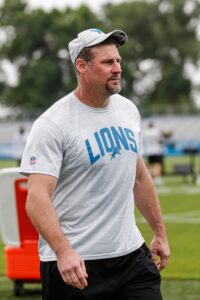 Holmes played a key role in assembling the Rams’ Super Bowl LVI-winning team due to having been the team’s college scouting director from 2013-20, and while he had already arrived in Detroit by the time McVay’s team reached the mountaintop, Holmes’ rebuild soon took shape. The Lions have made several impact draft choices under their current GM, who has transformed what had been one of the NFL’s worst rosters.
Holmes played a key role in assembling the Rams’ Super Bowl LVI-winning team due to having been the team’s college scouting director from 2013-20, and while he had already arrived in Detroit by the time McVay’s team reached the mountaintop, Holmes’ rebuild soon took shape. The Lions have made several impact draft choices under their current GM, who has transformed what had been one of the NFL’s worst rosters.
This franchise has not resided on this level in the game since the Buddy Parker years in the 1950s. While Wayne Fontes guided the team to four playoff berths in the ’90s, Campbell has the team on a better trajectory. This season will bring a different role for the club — a frontrunner — but the Holmes-Campbell regime is architecting one of this era’s defining rebuilds.
Campbell will have the unexpected luxury of keeping Johnson as his play-caller for a third season. The Panthers again pursued the coveted HC candidate, but the Commanders moved into pole position for Johnson’s services. Washington reps were en route to Detroit when informed Johnson was no longer interested in the job. This led to some back-and-forth regarding the parties’ tactics, but Johnson — who had never called plays before his Lions tenure — can remain patient due to the pieces the Lions have in place.
The third-year OC has been a central part of this team’s rise, with Goff’s turnaround coming entirely on his watch. More appealing jobs figure to open up soon — some perhaps in the NFC East — and Johnson can probably command a higher salary than most first-time candidates due to his current stock. Another strong season from the Lions’ offense, which seems likely given the personnel, could finally prompt the 38-year-old to make the jump.
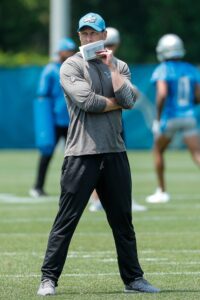 Newmark had been with the Lions since 1998, and he did ultimately make the move to Washington to be Adam Peters‘ top lieutenant. Peters kept ex-Lions GM Martin Mayhew and ex-Panthers GM Marty Hurney, doing so despite the team firing previous honcho Ron Rivera, but Newmark — who finished his Lions tenure as senior director of player personnel — is in place above the displaced GMs in the nation’s capital.
Newmark had been with the Lions since 1998, and he did ultimately make the move to Washington to be Adam Peters‘ top lieutenant. Peters kept ex-Lions GM Martin Mayhew and ex-Panthers GM Marty Hurney, doing so despite the team firing previous honcho Ron Rivera, but Newmark — who finished his Lions tenure as senior director of player personnel — is in place above the displaced GMs in the nation’s capital.
Sam LaPorta‘s second-round contract runs through 2026; the fast-rising Iowa alum cannot be extended until that year. That undoubtedly helped the Lions feel comfortable matching the 49ers’ offer sheet for Wright, who will continue in more of a blocking role while LaPorta guns for the first 1,000-yard tight end season in franchise history. LaPorta’s 889-yard showing is the top TE mark in team annals, and Wright — who logged 263 of his 423 snaps last season on run plays — will remain a key part of the team’s David Montgomery– and Jahmyr Gibbs-driven ground attack.
Top 10 cap charges for 2024:
- Jared Goff, QB: $27.21MM
- Frank Ragnow, C: $12.8MM
- Taylor Decker, LT: $10.96MM
- Aidan Hutchinson, OLB: $9.74MM
- Penei Sewell, RT: $8.17MM
- Alex Anzalone, LB: $7.44MM
- David Montgomery, RB: $6.79MM
- Kevin Zeitler, G: $5.94MM
- D.J. Reader, DT: $5.3MM
- Amon-Ra St. Brown, WR: $4.86MM
Although the Lions’ round of extensions may lead to long-term success, this season looms as crucial on the team’s timeline. The recently extended cogs’ cap numbers begin to rise in 2025, and it will be tougher for Holmes to maintain the kind of roster he has formed. That said, the Lions’ four first- or second-round picks from 2023 are all locked into rookie deals through at least the 2025 season. Gibbs can be retained through 2027 via the fifth-year option. This formula may well produce the first long-running Lions contender since the Bobby Layne era.
Detroit must fend off a quickly revitalized Green Bay operation and a Chicago outfit that has reset its QB clock thanks to the Justin Fields-for-Caleb Williams payroll adjustment. But Campbell’s team will enter the season as the NFC North favorite. Barring a slew of injuries, the Lions figure to be a surefire threat to the 49ers to reach Super Bowl LIX. Considering last season was the first time the Lions came especially close to a Super Bowl — as the 1991 Washington team routed the only other Detroit edition to advance to the NFC title game — this is a rather good time to be a fan of this franchise.
By Sam Robinson |
at August 23, 2024 10:30 pm
A year after hiring Frank Reich, the Panthers rebooted once again. David Tepper‘s rocky ownership tenure now includes a third HC hire — after another interim staff closed out a season. Carolina missed a sixth straight playoff bracket, with a 2-15 record — when factoring in what led them there — dropping the franchise to its lowest point. As Tepper continues to receive earned criticism, Dan Morgan and Dave Canales are at work attempting to rebuild this operation.
Coaching/front office:
The Panthers are well behind on the scorecards early in the Bryce Young–C.J. Stroud matchup. After being widely reported to have driven the bus for Young over the eventual Offensive Rookie of the Year, Tepper has hired a coach who played lead roles in elevating two depressed assets. Canales comes to Charlotte after being Geno Smith‘s quarterbacks coach (2022) and Baker Mayfield‘s OC. This represents a quick rise for someone with one year of play-calling experience, but Canales has been an NFL assistant since 2010.
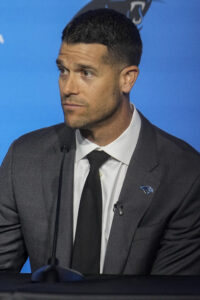 Tied to wanting an offensive coach once again, even after a preference for this coaching background brought an 11-game Reich stint, Tepper was closely linked to Lions OC Ben Johnson for a second offseason. Johnson dropped out of the Panthers’ HC search last year but interviewed with the team once again in January. Carolina sent a request a day after the regular season ended, and a mid-January report listed Johnson as both the Panthers and Commanders’ top choice. The Panthers may well have received word Johnson was not interested, as they hired Canales on Jan. 25. Johnson was still in the mix for the Commanders until Jan. 30.
Tied to wanting an offensive coach once again, even after a preference for this coaching background brought an 11-game Reich stint, Tepper was closely linked to Lions OC Ben Johnson for a second offseason. Johnson dropped out of the Panthers’ HC search last year but interviewed with the team once again in January. Carolina sent a request a day after the regular season ended, and a mid-January report listed Johnson as both the Panthers and Commanders’ top choice. The Panthers may well have received word Johnson was not interested, as they hired Canales on Jan. 25. Johnson was still in the mix for the Commanders until Jan. 30.
Tepper’s run of headlines, along with the team’s poor performance and the depleted draft capital the Young trade caused, stood to make Carolina’s job less attractive. Thus, the Panthers offered Canales a six-year contract. This comes four years after Tepper signed off on (and soon regretted) Matt Rhule‘s seven-year, $62MM deal. It is unlikely Canales commanded a Rhule-level salary, but he will benefit from the Panthers’ recent instability via the six guaranteed years. The Panthers got off the Rhule contract thanks to offset language, which came up after Nebraska hired him, but they are on the hook for Reich — who is expected to retire — through 2026.
Given a $3.5MM 2022 contract, Smith went from needing to beat out Drew Lock to be the Seahawks’ Russell Wilson replacement to winning Comeback Player of the Year acclaim and leading the NFL in completion rate. That garnered Canales the Tampa Bay job, and Mayfield just went from $4MM player to a quarterback given a three-year, $100MM deal to remain a Buccaneer. In between, the previously downtrodden passer threw 28 touchdown passes and 10 interceptions, finishing third for Comeback Player of the Year (behind Joe Flacco and Damar Hamlin).
 Canales, 43, is one of the fastest-rising assistants in recent memory, not being on the HC radar until 2024. Although the Panthers did not present the top job for aspiring HCs this offseason, they have an intriguing option who will be tasked with rebuilding Young’s stock.
Canales, 43, is one of the fastest-rising assistants in recent memory, not being on the HC radar until 2024. Although the Panthers did not present the top job for aspiring HCs this offseason, they have an intriguing option who will be tasked with rebuilding Young’s stock.
Tepper’s presence also made Carolina’s GM vacancy unattractive by comparison. Despite firing his other two top decision-makers from the early 2020s — Rhule and Fitterer — Tepper promoted Morgan, who was along for the ride since returning to the organization in May 2021. A former Panthers first-round pick as a linebacker, Morgan started 59 games for the team before injury trouble ended the one-time Pro Bowler’s career early. Morgan and Canales worked together — one a rising exec, the other Pete Carroll‘s WRs coach — in Seattle from 2010-17 — before the former followed ex-Panthers staffer Brandon Beane to Buffalo. The Bills have now sent two high-ranking Beane staffers — Morgan and Joe Schoen — into GM chairs.
Morgan received one other GM interview since returning to Charlotte, meeting about the Steelers’ job in 2022. Tepper certainly has familiarity with Morgan, though it is interesting the seventh-year owner promoted from in-house after canning Rhule and Fitterer. The latter held decision-making power — sort of, as Tepper continues to play a major role in football ops — following Rhule’s firing and was in charge for the Christian McCaffrey trade, the Brian Burns non-trade and the Young deal that sent D.J. Moore (and the Caleb Williams draft slot) to the Bears. Morgan, 45, will set out trying to correct some of the missteps his head-honcho predecessors made.
The point man behind the innovative Patrick Mahomes contract, Tilis will work with Morgan in this turnaround effort. The Panthers had interviewed Tilis for the GM post in 2022 and ’24. As Tilis arrives, the Panthers axed Adrian Wilson after one year. The former Cardinals safety-turned-Arizona exec had signed on to be the Panthers’ VP of player personnel in 2023. An arrest on misdemeanor domestic violence charges led Wilson out.
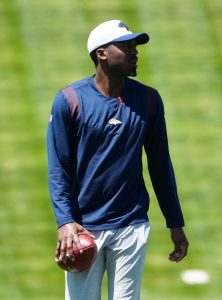 Canales brought Idzik, the Bucs’ wide receivers coach, with him as a non-play-calling OC. The son of ex-Jets GM John Idzik, Brad also worked with Canales in Seattle — as a lower-level assistant. Idzik, at 32, is the NFL’s youngest active OC. No OC interest elsewhere developed for Idzik, but plenty of teams wanted to interview Evero for both HC and DC positions.
Canales brought Idzik, the Bucs’ wide receivers coach, with him as a non-play-calling OC. The son of ex-Jets GM John Idzik, Brad also worked with Canales in Seattle — as a lower-level assistant. Idzik, at 32, is the NFL’s youngest active OC. No OC interest elsewhere developed for Idzik, but plenty of teams wanted to interview Evero for both HC and DC positions.
For a second straight offseason, Evero drew extensive interest despite being tied to a bad team. He was a popular HC interviewee after the 2022 Broncos fielded a viable defense (amid their offensive mess) and drew interest again after the 2023 Panthers’ defense ranked fourth in yardage allowed (29th in scoring, 25th DVOA).
The Panthers blocked three teams — the Jaguars, Giants and Dolphins — from interviewing Evero, who is now tied to a coach and GM that did not hire him. The Rams, who employed Evero from 2017-21, also loomed as interested. Unlike the Broncos last year, the Panthers would not let Evero out of his contract — an endgame the suddenly popular assistant may well have sought.
Trades:
The Giants talked the Panthers down from a first-round price point for Burns, who famously drew a two-first-rounder (plus a third) offer from the Rams at the 2022 trade deadline. Carolina then kept Burns out of the Young trade. Burns held the Panthers’ 2022 decision against them for the rest of their negotiations and pushed for what seemed like unreasonable terms, based on his history, by seeking a deal in the $30MM-per-year ballpark. That price point emerged before Nick Bosa became the NFL’s first $30MM-AAV edge rusher. Weeks into Morgan’s GM tenure, he cut the cord.
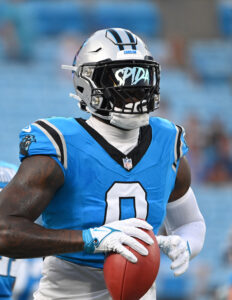 Morgan and Schoen worked together in Buffalo, and this relationship catalyzed this saga’s culmination. Fitterer and Rhule prioritized an extension with Burns, but the former waited until last year to enter serious negotiations. Trade offers that did not rival the Rams’ 2022 presentation emerged at the 2023 deadline, and after franchise-tagging Burns, the Panthers paused extension talks. Hard Knocks revealed this came as trade buzz percolated. This worked out quite well for for the tagged OLB, who signed a $28.2MM-per-year Giants extension that came with $87.5MM guaranteed.
Morgan and Schoen worked together in Buffalo, and this relationship catalyzed this saga’s culmination. Fitterer and Rhule prioritized an extension with Burns, but the former waited until last year to enter serious negotiations. Trade offers that did not rival the Rams’ 2022 presentation emerged at the 2023 deadline, and after franchise-tagging Burns, the Panthers paused extension talks. Hard Knocks revealed this came as trade buzz percolated. This worked out quite well for for the tagged OLB, who signed a $28.2MM-per-year Giants extension that came with $87.5MM guaranteed.
The Giants can be accused of overpayment, but the Jaguars topped Burns’ deal for Josh Hines-Allen. Neither player has been confused with a top-tier edge rusher, but they are now the NFL’s second- and third-highest-paid cogs at the position. Burns, 26, ranks just 12th and 14th in sacks and QB hits since entering the league as a Ron Rivera-Marty Hurney draftee in 2019. This saga still did not make the Panthers look great, given what they passed on two Octobers ago. But Morgan took what he could get late in the game and greenlit a full-on (lower-cost) reboot on the edge.
A day later, Carolina pounced on a Pittsburgh asset that should have more upside compared to what the team gave up. Johnson has been a better player than Jackson, consistently showing high-end separation skills. Drops have plagued the shifty route runner, but he is frequently open. The former third-round pick ranked in the top four in ESPN’s Open Score metric each year from 2019-22, leading the league twice in that span. Johnson, 28, played with Mason Rudolph, a declining Ben Roethlisberger, Mitch Trubisky and potential bust Kenny Pickett. Drawing 140-plus targets each season from 2020-22, Johnson should see plenty of looks in a Panthers contract year.
 Carolina acquired Johnson’s two-year, $36.71MM contract, which pairs with Young’s rookie deal and the rookie-scale pacts of Xavier Legette and Jonathan Mingo. Last year’s Panthers receiving leader, Adam Thielen, is now 34 and does not have any guarantees on his contract post-2024. Johnson is interested in a Panthers extension, and unless this fit proves poor, the team is in position to authorize one. If nothing else, the five-year Steeler should give Young an open target in a crucial season for his development.
Carolina acquired Johnson’s two-year, $36.71MM contract, which pairs with Young’s rookie deal and the rookie-scale pacts of Xavier Legette and Jonathan Mingo. Last year’s Panthers receiving leader, Adam Thielen, is now 34 and does not have any guarantees on his contract post-2024. Johnson is interested in a Panthers extension, and unless this fit proves poor, the team is in position to authorize one. If nothing else, the five-year Steeler should give Young an open target in a crucial season for his development.
A 2018 second-rounder, Jackson signed a three-year, $35.18MM deal during Rhule’s time in charge. Jackson, who reworked his deal with the Steelers, was a potential release candidate. Carolina landing Johnson in the deal probably qualifies as a win. The 76-game starter did bounce back from an injury-plagued 2022, but he turns 29 this fall. Johnson will cost more on a third contract, but the Toledo alum almost definitely has longer to play.
Free agency additions:
- Robert Hunt, G. Five years, $100MM ($44MM guaranteed)
- Damien Lewis, G. Four years, $53MM ($26.13MM guaranteed)
- Jadeveon Clowney, OLB. Two years, $20MM ($12MM guaranteed)
- Josey Jewell, LB. Three years, $18.75MM ($10.13MM guaranteed)
- A’Shawn Robinson, DL. Three years, $22.5MM ($7.38MM guaranteed)
- Dane Jackson, CB. Two years, $8.5MM ($5.13MM guaranteed)
- Yosh Nijman, OL. Two years, $8MM ($3.96MM guaranteed)
- Jordan Fuller, S. One year, $3.25MM ($3.06MM guaranteed)
- D.J. Wonnum, OLB. Two years, $12.5MM ($1.25MM guaranteed)
- Nick Scott, S. One year, $1.29MM ($738K guaranteed)
- K’Lavon Chaisson, OLB. One year, $2.5MM ($500K guaranteed)
- David Moore, WR. One year, $1.29MM
- Rudy Ford, S. One year, $1.21MM
- Jesper Horsted, TE. One year, $1.13MM
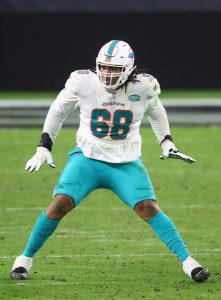 Week 18 of the 2022 season saw Panthers starters Austin Corbett and Brady Christensen go down with major injuries. Both sustained new maladies in 2023, with the latter lost for the season in Week 1. The Panthers struggled to protect Young, and just as the Saints did during Drew Brees‘ tenure, the team sought interior protection for a short quarterback. Two teams signed multiple guards in PFR’s top 50; the Panthers joined the Rams in that regard. Four of the five eight-figure-per-year free agency deals for guards came from Carolina or Los Angeles, and Hunt’s led the way by a notable margin.
Week 18 of the 2022 season saw Panthers starters Austin Corbett and Brady Christensen go down with major injuries. Both sustained new maladies in 2023, with the latter lost for the season in Week 1. The Panthers struggled to protect Young, and just as the Saints did during Drew Brees‘ tenure, the team sought interior protection for a short quarterback. Two teams signed multiple guards in PFR’s top 50; the Panthers joined the Rams in that regard. Four of the five eight-figure-per-year free agency deals for guards came from Carolina or Los Angeles, and Hunt’s led the way by a notable margin.
Relocated from right tackle to right guard after his rookie season, Hunt started there for three years and set himself up for a windfall. He is one of just five guards to be tied to a deal worth at least $20MM per year.
Becoming free agency-eligible — during a year that brought Miami cap trouble — unleashed Hunt and Christian Wilkins on the market, and the Panthers are betting big the former second-round pick can lead a turnaround. PFF slotted Hunt as a top-12 guard in each of the past two seasons. This can be labeled an overpay due to Hunt (28 on Saturday) having no Pro Bowl of All-Pro nods on his resume, but the cap spiked by a record $30.6MM. Certain players benefited, few more so than Hunt.
A four-year starter in Seattle, Lewis flew a bit under the radar by comparison. Teams still drove his market past $13MM per year, making the former third-rounder a top-15 earner on an escalating market. More road grader than pass protector, Lewis ranked fourth in run block win rate in 2022. While the 27-year-old lineman saw his PFF placements vacillate, this deep guard class did remarkably well.
Read more
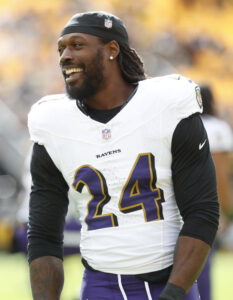 After the Texans franchise-tagged Clowney in 2019, he spent five seasons on one-year arrangements. The Seahawks, Titans, Browns and Ravens all gave the former No. 1 overall pick one-year deals. It took until Clowney’s age-31 season for a multiyear commitment to emerge, but the versatile edge rusher will come back to the region in which he starred in college. The former South Carolina super-prospect has not justified his draft slot, with injuries and inconsistency presenting impediments. Last season brought an upswing, as Clowney joined the Ravens during training camp and ripped off 9.5 sacks, 19 QB hits and two forced fumbles.
After the Texans franchise-tagged Clowney in 2019, he spent five seasons on one-year arrangements. The Seahawks, Titans, Browns and Ravens all gave the former No. 1 overall pick one-year deals. It took until Clowney’s age-31 season for a multiyear commitment to emerge, but the versatile edge rusher will come back to the region in which he starred in college. The former South Carolina super-prospect has not justified his draft slot, with injuries and inconsistency presenting impediments. Last season brought an upswing, as Clowney joined the Ravens during training camp and ripped off 9.5 sacks, 19 QB hits and two forced fumbles.
Clowney totaled just two sacks in 12 games during a disappointing Browns encore, wearing out his welcome, but he will be asked to anchor the Panthers’ post-Burns edge crew. Carolina hosted Chase Young and auditioned Yannick Ngakoue months later. The latter remains a free agent, but the team signed Kemoko Turay from that workout. Turay is already out of the picture via injury settlement. Wonnum, who suffered a torn quad late last season, appears headed for the reserve/PUP list.
The Panthers, who did not draft an edge defender, appear a man down here. Chaisson recorded a grand total of five sacks in four Jaguars seasons, underwhelming as a first-round pick.
 Evero brought in ex-Ram DBs Fuller and Scott, and Jewell followed his 2022 DC early in free agency. The Broncos had paid Alex Singleton and have a rather notable dead money number on their payroll, leaving Jewell expendable. The six-year Denver defender fared well last season, amassing 108 tackles, two forced fumbles, three fumble recoveries and three sacks. Jewell also started 13 games under Evero in 2022.
Evero brought in ex-Ram DBs Fuller and Scott, and Jewell followed his 2022 DC early in free agency. The Broncos had paid Alex Singleton and have a rather notable dead money number on their payroll, leaving Jewell expendable. The six-year Denver defender fared well last season, amassing 108 tackles, two forced fumbles, three fumble recoveries and three sacks. Jewell also started 13 games under Evero in 2022.
Familiarity with Evero became a Panthers priority, with Robinson also overlapping with the Carolina DC in L.A. Robinson started alongside Aaron Donald for the Rams’ Super Bowl-winning 2021 team, before playing last season with the Giants. One of the Rams’ Day 3 finds, Fuller started for Evero when he served as the team’s safeties coach (2020) and remained a first-stringer when his current DC moved to DBs coach in ’21. PFF graded Fuller 48th among safeties last season, as he returned from a significant hamstring malady to force three fumbles and intercept three passes.
Scott did not pan out in Cincinnati, but he spent three years under Evero in L.A. Running the risk of missing out on important inside jokes, Ford (15 Packers starts from 2022-23) both signed midway through camp and has no history with Evero. Though, his past with ex-Rams assistant Joe Barry in Green Bay should provide system familiarity.
Re-signings:
Evero clearly carried a voice in personnel this offseason, as three ex-Rams DBs are in the fold. Hill arrived late last year to help in the slot. The veteran will turn 33 next week, however. Jansen is 38, but he plays a position a bit kinder to aging talent. The 16th-year long snapper is back to create distance between himself (243 career games) and the field among games played as Panthers.
Notable losses:
- Henry Anderson, DL
- Vonn Bell, S (released)
- Bradley Bozeman, C (released)
- DJ Chark, WR
- Jeremy Chinn, S
- Shaquill Griffin, CB
- Yetur Gross-Matos, OLB
- Kamu Grugier-Hill, LB
- Marquis Haynes, OLB
- C.J. Henderson, CB
- Hayden Hurst, TE (released)
- Deion Jones, LB
- Frankie Luvu, LB
- Rashaad Penny, RB (retired)
- David Sharpe, T
- Laviska Shenault, WR
- DeShawn Williams, DL
 Reich’s staff did not change the starting O-line Rhule had brought in, re-signing Bozeman to a three-year deal worth $18MM. Bozeman had caught on via a low-cost contract in 2022, but the Fitterer-Reich regime re-upped him last year. The Panthers moved on a year later, taking on $7.28MM in dead money to do so. They are sliding fellow 2022 free agency addition Austin Corbett to center. The veteran guard played tackle at Nevada, making this an interesting transition as the Panthers found a spot for the 2022 signee after splurging on replacement guards.
Reich’s staff did not change the starting O-line Rhule had brought in, re-signing Bozeman to a three-year deal worth $18MM. Bozeman had caught on via a low-cost contract in 2022, but the Fitterer-Reich regime re-upped him last year. The Panthers moved on a year later, taking on $7.28MM in dead money to do so. They are sliding fellow 2022 free agency addition Austin Corbett to center. The veteran guard played tackle at Nevada, making this an interesting transition as the Panthers found a spot for the 2022 signee after splurging on replacement guards.
Bozeman, Hurst and Chark ended up with Jim Harbaugh in Los Angeles. Hurst managed outdo Dalton Schultz and Mike Gesicki on last year’s tight end market, signing a three-year, $21.75MM deal. The Panthers guaranteed Hurst $13MM at signing, creating dead money after they moved on a year later. Hurst saw a concussion derail his age-30 season. The former MLB draftee started slowly before the head injury, and the Panthers shut him down after a post-traumatic amnesia diagnosis. Carolina’s new regime did not designate Hurst a post-June 1 cut, taking on $9.86MM this year due to his 2024 salary being guaranteed.
While Thielen paced the Panthers’ aerial attack last season, Chark made some ancillary contributions during a 525-yard season. The former Jaguars second-rounder submitted his healthiest year (15 games) since his 1,000-yard 2019 showing. Continuing to operate as a deep threat, Chark averaged 15 yards per reception. He joins a Chargers WR corps that features an uncertain hierarchy. As the Panthers transition to a Johnson-fronted receiving cadre, Chark is on a fourth team in four years.
Carolina also ditched Bell’s three-year contract a year after signing. Returning to the Bengals shortly after, Bell represents Carolina’s top dead money hit this year ($9.89MM). Evero used Bell as a full-time starter; PFF graded the ex-Saints second-rounder outside the top 60 at the position. The Panthers have kept costs low at the position this offseason.
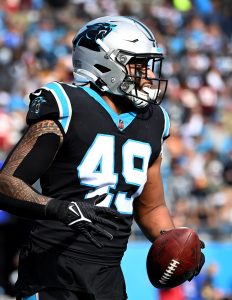 Chinn had fallen out of favor in Evero’s scheme, tanking his free agency stock. Previously one of the players Fitterer prioritized at the 2022 trade deadline, Chinn joined the Commanders on a one-year, $4.1MM deal. That is well south of where the former second-rounder’s value was prior to 2023. The versatile defender, who had spent extensive time at linebacker as well, was the 2020 Defensive Rookie of the Year runner-up. Evero benched Chinn early in the season, and after an IR stint, the former locked-in starter played sparingly.
Chinn had fallen out of favor in Evero’s scheme, tanking his free agency stock. Previously one of the players Fitterer prioritized at the 2022 trade deadline, Chinn joined the Commanders on a one-year, $4.1MM deal. That is well south of where the former second-rounder’s value was prior to 2023. The versatile defender, who had spent extensive time at linebacker as well, was the 2020 Defensive Rookie of the Year runner-up. Evero benched Chinn early in the season, and after an IR stint, the former locked-in starter played sparingly.
Luvu’s career has moved in the opposite direction, as the Panthers unlocked quality form from the former Jet. Playing out a two-year deal worth $9MM, Luvu operated as a Demario Davis-like presence in Carolina. The dynamic LB put together two seasons of at least 110 tackles and 5.5 sacks. He forced two fumbles last season and parlayed this production into a three-year, $31MM Commanders accord. The Panthers had not given up on re-signing Luvu, whom they had previously extended, but his market came in hot. As it stands, Jewell joins the last of the team’s Super Bowl 50 starters — Shaq Thompson — as second-level pillars.
Extensions and restructures:
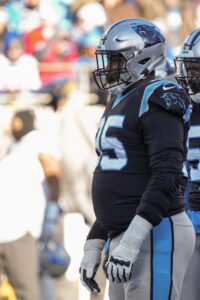 In addition to keeping Burns out of the 2023 Bears trade, Fitterer kept Brown in the extension queue by agreeing to part with D.J. Moore. Morgan ended up the one to authorize it, and with Burns gone, Brown is the Panthers’ unquestioned front-seven pillar.
In addition to keeping Burns out of the 2023 Bears trade, Fitterer kept Brown in the extension queue by agreeing to part with D.J. Moore. Morgan ended up the one to authorize it, and with Burns gone, Brown is the Panthers’ unquestioned front-seven pillar.
Chosen in Rhule’s first draft, Brown has not been productive as a pass rusher yet. This did not deter him on the extension front, as the Panthers gave him a top-five D-tackle deal. Brown scored a higher AAV than proven interior rushers Jeffery Simmons, Dexter Lawrence and Daron Payne. Wilkins and Chris Jones transforming the DT market in March helped Brown, now the fourth-highest-paid player at the position.
The Dolphins were hesitant to extend Wilkins at this rate last year due to concerns about his pass-rushing numbers. The Panthers have seen Brown only combine for eight career sacks, but while just about everything else imploded on Carolina’s roster last season, Brown dominated against the run. He ranked first in run stop win rate last season — after ranking third in 2022. Brown also landed in the top 20 for pass rush win rate. Brown, 26, posted 103 tackles (seven for loss) and a career-high 18 QB hits. The disruptor will be counted on more in 2024, as Carolina’s pass rush looks less imposing post-Burns and Luvu.
Draft:
- Round 1, No. 32 (from Chiefs through Bills): Xavier Legette (WR, South Carolina) (signed)
- Round 2, No. 46 (from Colts): Jonathon Brooks (RB, Texas) (signed)
- Round 3, No. 72 (from Jets): Trevin Wallace (LB, Kentucky) (signed)
- Round 4, No. 101: Ja’Tavion Sanders (TE, Texas) (signed)
- Round 5, No. 157 (from Browns through Vikings): Chau Smith-Wade (CB, Washington State) (signed)
- Round 6: No. 200 (from Cowboys through Texans and Bills): Jaden Crumedy (DT, Mississippi State) (signed)
- Round 7, No. 240 (from Steelers): Michael Barrett (LB, Michigan) (signed)
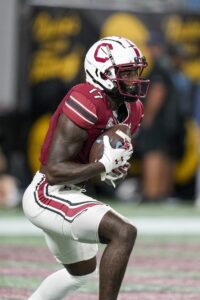 Legette met with the Panthers on a few occasions and went so far as the say team brass told him they hoped he made it to Round 2. Canales attempted to push back on this, but as it turned out, the South Carolina product was indeed the team’s target. The Panthers traded up one spot (via the Bills), sacrificing fifth-round real estate, to move into Round 1 for Legette. They secured a fifth-year option on the wideout’s contract by doing so.
Legette met with the Panthers on a few occasions and went so far as the say team brass told him they hoped he made it to Round 2. Canales attempted to push back on this, but as it turned out, the South Carolina product was indeed the team’s target. The Panthers traded up one spot (via the Bills), sacrificing fifth-round real estate, to move into Round 1 for Legette. They secured a fifth-year option on the wideout’s contract by doing so.
Carolina is betting on upside with Legette, who played five seasons with the Gamecocks and topped 200 receiving yards only once. Legette timed his best college season perfectly, breaking through for 1,255 yards and seven touchdowns as Spencer Rattler‘s top target last season. Weighing 221 pounds at the Combine, Legette further upped his draft stock by blazing to a 4.39-second 40-yard dash. Mingo, whose college trajectory was similar to Legette’s, made modest contributions as a rookie. The 2023 second-rounder has since seen the Panthers add Johnson and a first-round pick at the position. The Patriots also targeted Legette in a trade-up, but the Panthers outflanked them.
After moving their Burns-obtained pick to the Rams, the Panthers jumped up for this draft’s top running back. Viewing the Giants as a threat to select Brooks to succeed Saquon Barkley, the Panthers climbed in front of the NFC East club. The Panthers, who picked up a 2025 second-rounder from the Rams, sent the Colts two fifths to vault six spots.
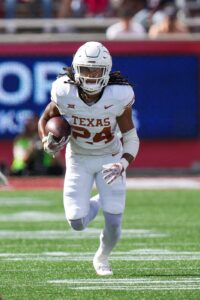 In Brooks, the Panthers have what looks like their long-term RB option. Continuing to distance themselves from their 2023 free agent class, the Panthers added another piece that will threaten Miles Sanders‘ playing time. Brooks dropped to No. 46 because of a November 2023 ACL tear, and the former Bijan Robinson Longhorns backup is expected to miss time to begin the season.
In Brooks, the Panthers have what looks like their long-term RB option. Continuing to distance themselves from their 2023 free agent class, the Panthers added another piece that will threaten Miles Sanders‘ playing time. Brooks dropped to No. 46 because of a November 2023 ACL tear, and the former Bijan Robinson Longhorns backup is expected to miss time to begin the season.
The Panthers have Brooks signed through 2027. Sanders is a 2025 cut candidate — if, in fact, this Panthers regime carries his guaranteed salary into this season — and starter Chuba Hubbard is in a contract year. Brooks offers recent production (1,139 rushing yards in 11 games last season) and low mileage (238 college carries), presenting an intriguing package in the long term.
The Panthers picked up fifth from the Jets in Round 3 and, in Wallace, added a presumptive Thompson successor. The 2015 first-round pick is in a contract year and going into his age-30 season. With no ties to this regime, the former Luke Kuechly sidekick may well be heading into his final Panthers season. Submitting a Luvu-like season as a junior last year, Wallace paired 80 tackles with 5.5 sacks. He presents big-picture options for a Panthers team that will have both Thompson and Jewell in their 30s by season’s end.
Other:
Horn has not justified the Panthers making him the eighth overall pick in 2021. The Panthers chose Horn one spot in front of future All-Pro Patrick Surtain and have seen the South Carolina alum miss extensive time. A foot injury cost Horn 14 games in 2022, while a significant hamstring ailment limited him to six last season. Horn was available for 13 games in 2022, and he has generally played well when on the field. Albeit on only 275 defensive snaps, PFF assigned Horn a top-10 ranking among CBs in 2023.
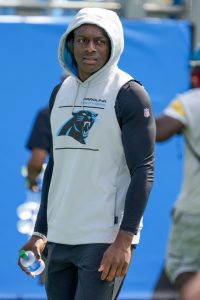 Not much has gone right for the Panthers during the 2020s, but Horn turning his promise into sustained success would give the team another building block on defense. Rhule took his fair share of criticism; Horn following Brown as a difference-maker would paint the short-tenured HC’s career in a new light.
Not much has gone right for the Panthers during the 2020s, but Horn turning his promise into sustained success would give the team another building block on defense. Rhule took his fair share of criticism; Horn following Brown as a difference-maker would paint the short-tenured HC’s career in a new light.
The Panthers are open to an extension with Horn, but they now have him signed through 2025. This gives Morgan and Co. more time to evaluate him, with health looming as the top concern here. The Panthers need their top CB on the field, as they are reeling at the position presently.
Dane Jackson (28 Buffalo starts) will miss the start of the season with a hamstring issue. The Panthers were linked to bringing back Clowney high school teammate Stephon Gilmore at a few offseason junctures. Nothing panned out, however, as the Vikings ended up with the 33-year-old corner. Carolina did make an offer to a player it once traded for after Horn’s initial NFL injury, but Gilmore opted to rejoin ex-Patriots assistant Brian Flores in the Twin Cities. Post-Donte Jackson, Carolina is suddenly shorthanded here.
Top 10 cap charges for 2024:
- Taylor Moton, RT: $29.75MM
- Austin Corbett, G: $10.13MM
- Diontae Johnson, WR: $10MM
- Adam Thielen, WR: $9.92MM
- Bryce Young, QB: $8.63MM
- Shy Tuttle, DT: $8.31MM
- Xavier Woods, S: $7.76MM
- Miles Sanders, RB: $7.7MM
- Ikem Ekwonu, LT: $7.52MM
- Jaycee Horn, CB: $6.72MM
Unless Tepper can prove to be a more stable owner, Panthers personnel successes may matter too much. Fined for throwing a drink on a fan, the volatile Carolina czar has become the unfortunate face of this franchise. He generated buzz about being difficult to work for before the Reich tenure even began and has been widely blamed for the Young decision. While Tepper had indicated upon pairing Morgan with Canales he would step back, a recent rumor indicates this has not yet happened. As Major League and Ted Lasso highlight, winning in spite of an owner has made for quality onscreen content. But Tepper continuing down this path would certainly mar a real-life Panthers resurgence.
Young’s QBR ranked ahead of only Zach Wilson last season, but the 2021 Heisman winner should not be deemed a bust yet. The Panthers devoted their offseason to bettering his situation, revamping their receiving corps and spending big on interior protection. Not much is expected of this year’s team, but Young growth will be paramount if the organization hopes to contend again in the near future.
By Sam Robinson |
at August 22, 2024 9:57 pm
The Chiefs once again flipped a regular-season loss to the Bills into a playoff win, continuing a series that keeps seeing Buffalo’s Super Bowl path blocked despite the AFC East champions holding their own in the matchup. After an injury-battered Bills defense came up short in Round 2 last year, the team set about a retooling effort that featured more notable changes on the other side of the ball. Josh Allen has a new-look receiving corps. For the first time since his ascent to superstardom, the do-it-all QB will not be targeting Stefon Diggs.
Additional Bills moves centered on cap-based adjustments, with a few longtime starters — some longer in the tooth, others who had dealt with injuries — also out of the picture. As a result, curiosity surrounds Sean McDermott‘s team and perhaps the eighth-year HC’s status. But the Bills still have Allen and many key pieces from their early-2020s stay atop their division. While they should still remain a factor in the Super Bowl chase, plenty of eyes will be on this team as it reshapes its blueprint to reach its long-sought-after goal.
Trades:
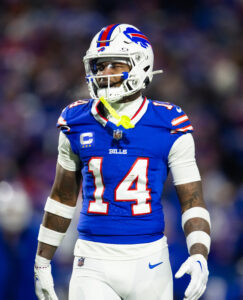 As difficult as it appeared Diggs was for the Bills to manage at points, his 2020 arrival played a pivotal role in Allen catapulting toward his current place in the game. The 2018 first-round pick took a seminal step in Diggs’ debut, and the former Vikings draftee became one of the NFL’s most consistent pass catchers in Buffalo.
As difficult as it appeared Diggs was for the Bills to manage at points, his 2020 arrival played a pivotal role in Allen catapulting toward his current place in the game. The 2018 first-round pick took a seminal step in Diggs’ debut, and the former Vikings draftee became one of the NFL’s most consistent pass catchers in Buffalo.
The Allen-Diggs tandem produced three straight 1,200-plus-yard seasons, with Year 1 doubling as Diggs’ lone first-team All-Pro showing. The elite route runner also displayed durability for a Bills team that shuffled through second bananas in the passing game, missing only one contest in four seasons. Though, last year brought some concerning signs.
Diggs, 30, struggled down the stretch, averaging only 41 yards per game and scoring just once over the Bills’ final 10 contests; Joe Brady‘s offense did not coax the nine-year veteran’s best work. Diggs’ 1,183-yard season brought speedbumps and produced a brutal final act — dropping a well-placed Allen deep ball late in another narrow January loss to the Chiefs.
Diggs’ sudden production decline came a year after he stormed out of Buffalo’s locker room following a one-sided loss to Cincinnati. During the 2023 offseason program, Diggs left the Bills’ facility unexpectedly — before McDermott called the confusing matter, which may or may not have stemmed from the wideout’s role in the offense, “very concerning.” A year later, Diggs will be asked to help the Texans develop C.J. Stroud.
 A report pointed to the Texans including a 2025 second-rounder as changing Buffalo brass’ mind on retaining the WR. That said, this trade brought a non-QB record for single-player dead money ($31.1MM). That full amount is on the Bills’ 2024 cap sheet. Considering what it cost the Bills to trade their top target, it clearly did not take too much convincing on the Texans’ part. Indeed, an April report indicated Diggs’ antics had worn thin and Bills higher-ups were ready to move on. Ultimately, Diggs (zero TDs with Brady at the controls) expected to be traded for a second time.
A report pointed to the Texans including a 2025 second-rounder as changing Buffalo brass’ mind on retaining the WR. That said, this trade brought a non-QB record for single-player dead money ($31.1MM). That full amount is on the Bills’ 2024 cap sheet. Considering what it cost the Bills to trade their top target, it clearly did not take too much convincing on the Texans’ part. Indeed, an April report indicated Diggs’ antics had worn thin and Bills higher-ups were ready to move on. Ultimately, Diggs (zero TDs with Brady at the controls) expected to be traded for a second time.
The Texans had pursued Keenan Allen; they needed to give the Bills more than the Bears sent the Chargers. Houston curiously removed the final three seasons of Diggs’ Bills-constructed extension — four years, $96MM — in a reported effort to better motivate the veteran playmaker. That odd decision will put Diggs on track for free agency come March, barring an extension before that point. Diggs exiting western New York with four years remaining on his contract injects uncertainty into the Bills’ equation, as Allen’s age-28 season does not seem likely to include a true No. 1 receiver. Allen has obviously displayed tremendous growth since his rocky pre-Diggs years, but his team has an issue to sort out soon.
Playing on a Bears-designed contract for the past two seasons, Bates is now part of that team. The Bills matched the Bears’ RFA offer sheet during Ryan Poles‘ first offseason running the NFC North franchise, but after using Bates as a starter in 15 games in 2022, they demoted him upon adding guards Connor McGovern and O’Cyrus Torrence. Bates worked strictly as a backup last season; the 27-year-old blocker is vying for Chicago’s starting center role while giving the team an option at right guard.
Extensions and restructures:
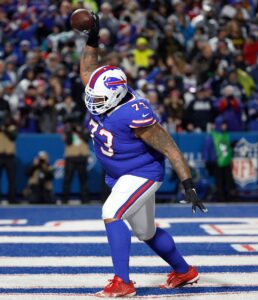 More attention surrounded the players the Bills lost this offseason, but the team paid two core performers. Dawkins is the longest-tenured Bills left tackle since Jim Kelly– and Doug Flutie-era blindsider John Fina. Only Fina (131) and 1970s and ’80s LT bastion Ken Jones (130) have served longer in this role. Carrying 106 career starts, Dawkins will have a chance to top this list during the 2025 season. Cordy Glenn‘s LT successor has made the past three Pro Bowls, anchoring an O-line that has seen changes come to pass everywhere else during his eight-year tenure.
More attention surrounded the players the Bills lost this offseason, but the team paid two core performers. Dawkins is the longest-tenured Bills left tackle since Jim Kelly– and Doug Flutie-era blindsider John Fina. Only Fina (131) and 1970s and ’80s LT bastion Ken Jones (130) have served longer in this role. Carrying 106 career starts, Dawkins will have a chance to top this list during the 2025 season. Cordy Glenn‘s LT successor has made the past three Pro Bowls, anchoring an O-line that has seen changes come to pass everywhere else during his eight-year tenure.
Pass block win rate placed Dawkins fourth overall among tackles last season, and Pro Football Focus has ranked him outside the top 25 among tackles only once (2018). Dawkins, 30, has also avoided injuries. A second-round pick during the draft McDermott and Doug Whaley shepherded (one that also produced Tre’Davious White and Matt Milano), Dawkins has been one of the team’s catalysts during this rise. This third contract should include more prime years for the Temple product, who is now the NFL’s sixth-highest-paid LT. Given Dawkins’ stability, the Bills having him at this rate represents good value.
Coming into the offseason, the slot cornerback market had stagnated. Neither Johnson nor Kenny Moore were able to score deals beyond where 2010s All-Decade slot Chris Harris went ($8.5MM AAV) during the 2014 season. Both current AFC slot staples finally elevated the market to eight-figure-per-year territory. Moore re-signed with the Colts at three years and $30MM; Johnson topped that days later to become the league’s highest-paid inside corner. The Bills CB’s guarantee at signing also narrowly topped Moore’s $16MM figure, which is impressive considering the latter hit free agency.
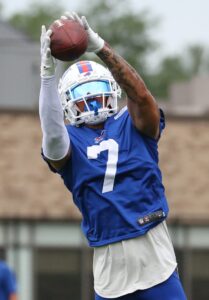 During Johnson’s second contract, the Bills have seen their outside corners struggle to either stay healthy (Tre’Davious White) or justify a first-round investment (Kaiir Elam). Johnson, meanwhile, has anchored Buffalo’s CB corps during the 2020s. PFF gave the 2018 fourth-rounder a career-best grade last season, ranking him 17th among all corners, and his 7.4 yards per target figure was his best mark since his rookie season. Johnson also forced three fumbles in 2023. As the Bills transition from White, they will need Johnson (28) to keep delivering top-shelf work inside.
During Johnson’s second contract, the Bills have seen their outside corners struggle to either stay healthy (Tre’Davious White) or justify a first-round investment (Kaiir Elam). Johnson, meanwhile, has anchored Buffalo’s CB corps during the 2020s. PFF gave the 2018 fourth-rounder a career-best grade last season, ranking him 17th among all corners, and his 7.4 yards per target figure was his best mark since his rookie season. Johnson also forced three fumbles in 2023. As the Bills transition from White, they will need Johnson (28) to keep delivering top-shelf work inside.
Miller’s status loomed as tenuous during a season in which he was clearly hampered by a second ACL tear. The year ended with the future Hall of Famer being arrested on a third-degree felony charge of assaulting a pregnant person. Both Miller and the alleged victim, his girlfriend, denied a crime occurred. An NFL suspension would void Miller’s remaining guarantees — $8.5MM for 2024. After this year, no guaranteed money remains on a deal that has not worked out the way the Bills hoped. Nothing has come out in 2024 regarding any potential punishment for the 35-year-old edge rusher, and the Bills restructuring the deal firmly keeps Miller in their plans.
The former Broncos and Rams superstar said he is 100% healthy; he is now nearly 21 months removed from the knee injury that ended his 2022 season — a promising campaign that featured eight sacks in 11 games — and sidetracked his 2023 slate. Miller played in 12 games, starting none, last season and did not resemble the dominant sack artist the Bills signed for $20MM per. The team will hope the 14th-year vet has another rebound season in him, as it lost Leonard Floyd in free agency. Due to this restructure, the Bills would take on $15.4MM in dead money if they released Miller next year.
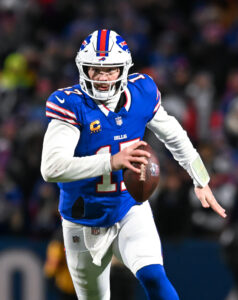 Allen denied he is unhappy with his contract, but the Bills have an incredible bargain atop their payroll. Their $43MM-per-year Allen accord has aged remarkably well, as the perennial MVP candidate — after Jared Goff, Trevor Lawrence, Tua Tagovailoa and Jordan Love joined the $50MM-AAV club — is the NFL’s 13th-highest-paid QB. The Bills could move money around the way the Chiefs did to accommodate Patrick Mahomes‘ deal.
Allen denied he is unhappy with his contract, but the Bills have an incredible bargain atop their payroll. Their $43MM-per-year Allen accord has aged remarkably well, as the perennial MVP candidate — after Jared Goff, Trevor Lawrence, Tua Tagovailoa and Jordan Love joined the $50MM-AAV club — is the NFL’s 13th-highest-paid QB. The Bills could move money around the way the Chiefs did to accommodate Patrick Mahomes‘ deal.
Thus far, Allen is the only QB who has emulated Mahomes by signing an extension longer than five years. The six-year pact Allen signed runs through 2028, and like Mahomes’ deal, Allen’s has extended space for base-to-bonus restructures. The Bills took advantage of that flexibility in March.
The Bills will need to address this matter in the not-too-distant future. With five more seasons on the contract, the team can sit tight for now. As is the case with Mahomes and the Chiefs, however, the QB carries significant leverage due simply to his franchise-elevating skillset. It will be interesting to see if the seventh-year passer uses it soon, especially when factoring in the run-game role the former No. 7 overall pick has taken on — only two QBs (Lamar Jackson and Cam Newton) have logged more carries through six seasons — thus far in his career.
Free agency additions:
- Curtis Samuel, WR. Three years, $24MM ($14.02MM guaranteed)
- Austin Johnson, DT. One year, $3.5MM ($3.05MM guaranteed)
- Mitch Trubisky, QB. Two years, $5.25MM ($2.71MM guaranteed)
- Marquez Valdes-Scantling, WR. One year, $2.25MM ($2.25MM guaranteed)
- Dawuane Smoot, DE. One year, $2.5MM ($1.75MM guaranteed)
- Mike Edwards, S. One year, $2.8MM ($1.6MM guaranteed)
- La’el Collins, OL. One year, $1.75MM ($1.5MM guaranteed)
- Mack Hollins, WR. One year, $2.6MM ($1.1MM guaranteed)
- Nicholas Morrow, LB. One year, $1.5MM ($750K guaranteed)
- Will Clapp, OL. One year, $1.29MM ($288K guaranteed)
- Casey Toohill, DE. One year, $1.16MM ($15K guaranteed)
- DeShawn Williams, DT. One year, $1.16MM ($15K guaranteed)
- Damiere Byrd, WR. One year, $1.21MM
- Kareem Jackson, S. One year, $1.21MM
- Deion Jones, LB. One year, $1.21MM
- Dee Delaney, CB. One year, $1.13MM
- KJ Hamler, WR. One year, $1.1MM
Buffalo began to reassemble its wide receiver pieces in March, though Samuel and Hollins joined the team when Diggs was still expected to be the WR1. This equation soon involved Valdes-Scantling, Byrd, Hamler and Chase Claypool. The twice-traded WR, however, is out of the picture via an injury settlement. Holdover Khalil Shakir and second-round pick Keon Coleman figure to lead the way for the Bills, with a heavy assist from TEs Dalton Kincaid and Dawson Knox, but the team will need auxiliary help at least from free agents.
Read more
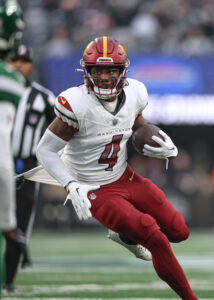 Samuel, 28, worked with Brady during the latter’s first season as Carolina’s OC. The former second-round pick eclipsed 600 receiving yards in each of the past two seasons, profiling as more of a slot/gadget weapon than an outside option. ESPN’s Open Score metric rated Samuel as a bottom-20 wideout last season, but the Ohio State alum is known for short-area production. However, the Bills relied on Shakir in this role late last season. It will be interesting to see how the team uses the third-year player and veteran FA addition together.
Samuel, 28, worked with Brady during the latter’s first season as Carolina’s OC. The former second-round pick eclipsed 600 receiving yards in each of the past two seasons, profiling as more of a slot/gadget weapon than an outside option. ESPN’s Open Score metric rated Samuel as a bottom-20 wideout last season, but the Ohio State alum is known for short-area production. However, the Bills relied on Shakir in this role late last season. It will be interesting to see how the team uses the third-year player and veteran FA addition together.
A Chiefs cap casualty, Valdes-Scantling drew interest from multiple teams. He struggled for most of last season before making some crucial contributions — including two long-range grabs against the Bills — in the playoffs. MVS sustained a neck injury and may not be ready for Week 1. This obviously hurts the ex-Packers and Chiefs deep threat’s roster chances, as he was viewed as a bubble player recently.
Despite carrying a lower profile and making fewer career starts (60-27), Hollins consistently played ahead of Valdes-Scantling in camp. Set to turn 31 in September, Hollins has surpassed 250 receiving just once in his seven-year career. It would be odd for the Bills to give Hollins a key role, but he appears a roster lock. The Bills also worked out Corey Davis recently, adding intrigue to a group that does not seem full yet. This is an area to monitor ahead of November’s trade deadline.
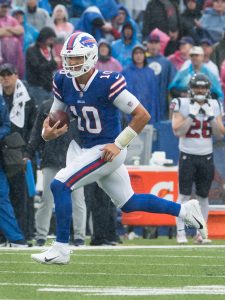 Allen has not missed a game due to injury since his rookie season, but he has run into health issues over the past two seasons. This makes the Bills’ backup plan curious, as Trubisky has generally inspired little confidence since being a defining QB bust. The Bills rostered Trubisky in 2021 and quickly brought him back following the Steelers’ release. Trubisky beat out Mason Rudolph for Pittsburgh’s QB2 gig last season and received the first crack when Kenny Pickett went down. The former No. 2 overall pick lost the job and watched Rudolph excel down the stretch. Trubisky, 30, averaged just 5.9 yards per attempt last season, lost both his starts and finished with a 4-5 TD-INT ratio.
Allen has not missed a game due to injury since his rookie season, but he has run into health issues over the past two seasons. This makes the Bills’ backup plan curious, as Trubisky has generally inspired little confidence since being a defining QB bust. The Bills rostered Trubisky in 2021 and quickly brought him back following the Steelers’ release. Trubisky beat out Mason Rudolph for Pittsburgh’s QB2 gig last season and received the first crack when Kenny Pickett went down. The former No. 2 overall pick lost the job and watched Rudolph excel down the stretch. Trubisky, 30, averaged just 5.9 yards per attempt last season, lost both his starts and finished with a 4-5 TD-INT ratio.
Moving away from one of this century’s best safety duos, the Bills added Edwards after his Chiefs one-and-done included part-time starter duty. This came after Julian Blackmon visited. The former Buccaneers contributor started in the Chiefs’ four playoff games, replacing an injured Bryan Cook, and the veteran played nearly every defensive snap in Kansas City’s Super Bowl win. For his career, Edwards has made 28 starts and snagged nine interceptions.
The Bills met with ex-Jet Foley Fatukasi and showed interest in Arik Armstead and Malcolm Roach. Armstead took a big Jaguars offer, reuniting with ex-49ers GM Trent Baalke. Buffalo added Johnson at a much lower rate. Johnson, 30, spent the past two seasons with the Chargers. The former Titans second-rounder has been something of a late bloomer. After making 13 starts through five seasons, he has logged 42 over the past three.
Beane proclaimed this free agency period would not feature splashy Bills additions. Excepting Samuel, the eighth-year GM stuck to his word.
Re-signings:
- DaQuan Jones, DT. Two years, $16MM ($10.5MM guaranteed)
- A.J. Epenesa, DE. Two years, $12MM ($6.56MM guaranteed)
- Taylor Rapp, S. Three years, $10.63MM ($3.68MM guaranteed)
- David Edwards, G. Two years, $6MM ($2.95MM guaranteed)
- Cameron Lewis, CB. Two years, $3.1MM ($1.13MM guaranteed)
- Ty Johnson, RB. One year, $1.29MM ($668K guaranteed)
Epenesa has a chance to move into Buffalo’s starting lineup, ahead of one of the greatest edge rushers in NFL history, following Leonard Floyd‘s 49ers defection. The former second-rounder has started just four games and has never topped 41% usage on defense. With Miller a wild card, the Bills will need Epenesa to unlock another level. The Iowa alum produced the same pass rush stat line (6.5 sacks, 10 QB hits) over the past two seasons. The Bills have him back on a low-middle-class rate and will hope for more, with Miller potentially in his final year with the team.
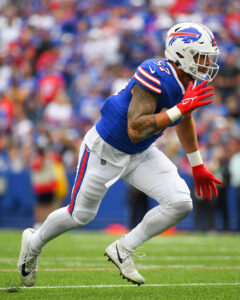 The Bills missed Jones for most of last season. Enjoying a quality start before suffering a torn pec, Jones managed to score an eight-figure guarantee at 32. Not re-signing Jordan Phillips or Linval Joseph, Buffalo will again ask Jones to anchor its interior run defense. Run stop win rate placed Jones sixth among D-tackles in 2022, and he remained effective as an Ed Oliver complement despite a 61% snap rate. With Jones out of the picture for much of last season, the Bills dropped from fifth to 15th against the run from 2022-23.
The Bills missed Jones for most of last season. Enjoying a quality start before suffering a torn pec, Jones managed to score an eight-figure guarantee at 32. Not re-signing Jordan Phillips or Linval Joseph, Buffalo will again ask Jones to anchor its interior run defense. Run stop win rate placed Jones sixth among D-tackles in 2022, and he remained effective as an Ed Oliver complement despite a 61% snap rate. With Jones out of the picture for much of last season, the Bills dropped from fifth to 15th against the run from 2022-23.
Edwards at $3MM per represents a borderline steal. Prior to a concussion-marred 2022 and working as a Bills swingman on a near-veteran-minimum contract last year, Edwards started every game for the Super Bowl-winning Rams. The former fifth-round pick also moved into Los Angeles’ starting lineup under now-Bills O-line coach Aaron Kromer. PFF ranked Edwards as a top-30 guard in 2020 and ’21; for what it’s worth, the advanced metrics site graded his 194 2023 snaps immaculately, ranking no guard higher. Even if Edwards cannot come too close to replicating that small sample size-based placement, this could still be a bargain for Buffalo.
Notable losses:
- Kyle Allen, QB
- Gabe Davis, WR
- Tyrel Dodson, LB
- Leonard Floyd, DE
- Poona Ford, DT
- Damien Harris, RB (retired)
- Deonte Harty, WR (released)
- Nyheim Hines, RB (released)
- Micah Hyde, S
- Dane Jackson, CB
- A.J. Klein, LB (retired)
- Linval Joseph, DT
- Shaq Lawson, DE
- Tyler Matakevich, LB
- Mitch Morse, C (released)
- Latavius Murray, RB
- Siran Neal, CB (released)
- Jordan Phillips, DT
- Jordan Poyer, S (released)
- Tim Settle, DT
- Trent Sherfield, WR
- Tre’Davious White, CB (post-June 1 cut)
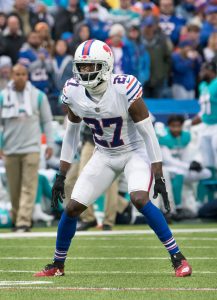 Just as the Packers’ David Bakhtiari injury “what if?” loomed over their early-2020s teams, White’s Thanksgiving 2021 ACL tear keeping him out of the divisional-round shootout in Kansas City may well have denied the Bills a Super Bowl berth. Like Bakhtiari, White’s injury woes lingered to the point he could no longer live up to his contract.
Just as the Packers’ David Bakhtiari injury “what if?” loomed over their early-2020s teams, White’s Thanksgiving 2021 ACL tear keeping him out of the divisional-round shootout in Kansas City may well have denied the Bills a Super Bowl berth. Like Bakhtiari, White’s injury woes lingered to the point he could no longer live up to his contract.
The Bills, who chose White after picking up an extra first-rounder from the Chiefs in the 2017 Mahomes swap, received good value early. White became a two-time All-Pro and anchored Buffalo’s CB corps, but following the ACL tear, he missed 35 games. White, 29, will count more than $10MM in dead money across the next two years.
A bigger loss comes elsewhere in the secondary. The rare seven-year starting safety duo, Hyde and Poyer — part of McDermott’s first Bills free agency class — were instrumental in the team snapping a 17-year playoff drought and becoming an AFC power. Given midlevel deals as first-time free agents in 2017, each signed a more lucrative contract. Hyde did not receive a third deal from Buffalo — though, the suddenly safety-depleted team has not ruled out one more pact — and the club dropped Poyer’s from the books, leading the latter to Miami.
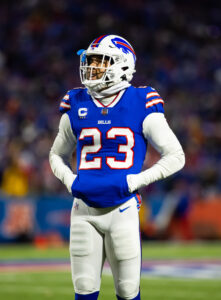 Both players are now 33; the Bills certainly received their prime years. The initial Hyde and Poyer pacts represent top-flight free agency steals, and the Bills never needed to venture into eight-figure AAV territory to extend either. Both overdelivered. While there have been better position groups in Bills history, not too many top what this safety pair accomplished during its time together.
Both players are now 33; the Bills certainly received their prime years. The initial Hyde and Poyer pacts represent top-flight free agency steals, and the Bills never needed to venture into eight-figure AAV territory to extend either. Both overdelivered. While there have been better position groups in Bills history, not too many top what this safety pair accomplished during its time together.
Floyd continued his post-Chicago surge in New York. The former Aaron Donald wingman has been one of the decade’s most consistent pass rushers. He has posted between nine and 10.5 sacks each year from 2020-23 and tallied between 18-22 QB hits each season. Adding Floyd as part-Miller insurance proved vital for the Bills, as they soon needed a true starter due to Miller’s diminished ’23 form.
The 49ers poached Floyd to complement Nick Bosa; the ninth-year vet used his one-year, $7MM Bills deal to score a two-year, $20MM contract ($12MM guaranteed). While Epenesa (soon to be 26) is six years younger, the Bills will take a risk by losing a durable, dependable edge. Of course, having Miller and Oliver’s contracts on the books present some limitations.
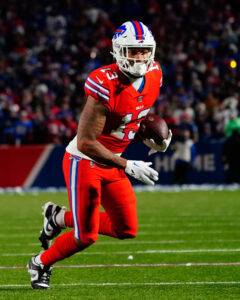 Buffalo’s 2019 Morse addition also overlapped with the team’s Beane-McDermott-era climb, as the former Kansas City second-rounder elevated his game to become a dependable Dawkins sidekick up front. Morse made a Pro Bowl and only missed six games in that five-year span. The Bills gave him two deals around the same rate (four years, $44.5MM and then a two-year, $19.5MM pact in 2022). That said, the Mizzou alum has sustained six documented concussions as a pro. The 32-year-old blocker will continue his career in Jacksonville, though his history of head injuries will unfortunately be an area to monitor regarding his future.
Buffalo’s 2019 Morse addition also overlapped with the team’s Beane-McDermott-era climb, as the former Kansas City second-rounder elevated his game to become a dependable Dawkins sidekick up front. Morse made a Pro Bowl and only missed six games in that five-year span. The Bills gave him two deals around the same rate (four years, $44.5MM and then a two-year, $19.5MM pact in 2022). That said, the Mizzou alum has sustained six documented concussions as a pro. The 32-year-old blocker will continue his career in Jacksonville, though his history of head injuries will unfortunately be an area to monitor regarding his future.
Davis and Morse can bounce Jacksonville restaurant ideas off one another — depending on the ex-Bills-turned-Floridians’ off-field rapport, of course — with the former signing with the AFC South team shortly before the center committed. The Bills will either miss Davis’ downfield chops, or the former auxiliary weapon will see his numbers impacted by Allen no longer targeting him.
Davis’ camp reminded suitors of the former fourth-rounder’s Buffalo success by pointing out the WR2 led the NFL in average depth of target, first-down rate and touchdown rate among WRs from 2020-23. Davis scored 33 TDs in that span, highlighted by his four-score performance against the Chiefs in the 2021 divisional-round epic. While the Bills might miss Davis, Allen’s skills stand to create another version at some point.
Draft:
- Round 2, No. 33 (from Panthers): Keon Coleman (WR, Florida State) (signed)
- Round 2, No. 60: Cole Bishop (S, Utah) (signed)
- Round 3, No. 95 (from Chiefs): DeWayne Carter, DT (Duke) (signed)
- Round 4, No. 128: Ray Davis (RB, Kentucky) (signed)
- Round 5, No. 141 (from Giants through Panthers): Sedrick Van Pran-Granger (C, Georgia) (signed)
- Round 5, No. 160 (from Packers): Edefuan Ulofoshio (LB, Washington) (signed)
- Round 5, No. 168 (from Saints): Javon Solomon (EDGE, Troy) (signed)
- Round 6, No. 204: Tylan Grable (T, Central Florida) (signed)
- Round 6, No. 219 (from Packers): Daequan Hardy (CB, Penn State) (signed)
- Round 7, No. 221 (from Panthers through Titans and Chiefs): Travis Clayton (T, England) (signed)
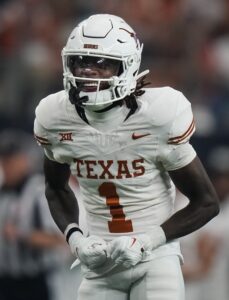 With the draft coming three weeks after the Bills traded the second-most productive wide receiver in team history, the four-time reigning division champs brought an obvious need to Detroit. How they went about filling it presents big-picture questions, as the effort involved a few other teams. One such transaction stands out.
With the draft coming three weeks after the Bills traded the second-most productive wide receiver in team history, the four-time reigning division champs brought an obvious need to Detroit. How they went about filling it presents big-picture questions, as the effort involved a few other teams. One such transaction stands out.
The Bills hosted Xavier Worthy on a “30” visit and met with Xavier Legette. On draft night, though, the made the scrutinized decision to trade down from No. 28 overall, passing on the Texas speedster. More significantly, Buffalo allowed its January nemesis to acquire him. The Chiefs are taking a gamble they can get by with a sub-170-pound speed merchant, but Worthy’s career will be tied to the Bills’ decision.
Buffalo also passed on this draft’s other high-end WR Xavier, giving the Panthers No. 32 (Legette). The Bills moved up 38 spots, collecting third-round real estate, in the Worthy trade and climbed up 59 (for early-Round 5 space) in giving the Panthers Legette. This set up the Coleman move to start Round 2.
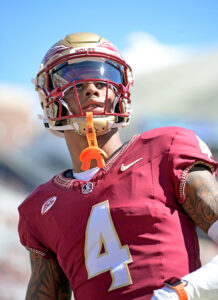 Shakir and Samuel will play big roles post-Diggs, but the Bills are counting on Coleman after he produced modest success in college. Transferring from Michigan State, Coleman did not eclipse 800 receiving yards in a season with the Spartans or Seminoles. He also lumbered to a 4.61-second 40-yard dash at the Combine. Though, the 6-foot-3 weapon’s top speed of 20.36 mph in the Combine’s gauntlet drill led all receivers over the past two years. Already submitting memorable interviews as a pro, Coleman is coming off an 11-touchdown season. Allen offered his approval after scouting wide receivers as well.
Shakir and Samuel will play big roles post-Diggs, but the Bills are counting on Coleman after he produced modest success in college. Transferring from Michigan State, Coleman did not eclipse 800 receiving yards in a season with the Spartans or Seminoles. He also lumbered to a 4.61-second 40-yard dash at the Combine. Though, the 6-foot-3 weapon’s top speed of 20.36 mph in the Combine’s gauntlet drill led all receivers over the past two years. Already submitting memorable interviews as a pro, Coleman is coming off an 11-touchdown season. Allen offered his approval after scouting wide receivers as well.
Buffalo’s decision atop its draft came down to trade offers, as the Patriots attempted to move up for Worthy as well. Given the Chiefs’ staunch postseason deterrence efforts, it is risky to provide them draft help at this juncture — especially considering the Patriots’ recent struggles. Of course, it is not known the difference in the clubs’ proposals.
The Pats ended up making their WR splash with Washington’s Ja’Lynn Polk at No. 37. He and Coleman figure to face off for years to come, while the Bills will naturally hope Worthy does not rearm the Chiefs to a frightening degree. Buffalo is believed to have shown interest in Deebo Samuel. If the 49ers extend Brandon Aiyuk soon, the Bills may be able to revisit a Samuel trade in 2025.
 Mike Edwards may be asked to start early — though, the Bills have run into injury trouble at safety — Bishop will be where the Bills want this position to settle soon. The Utah product has not gotten much practice work in due to an early-camp injury, but plans will still be in place for him to team with Rapp. Edwards and Damar Hamlin are not signed for 2025. A second-team All-Pac-12 safety in 2023, Bishop was strong against the run (21.5 career tackles for loss) and as a blitzer (7.5 sacks in three Utes seasons). He will have big shoes to fill in coverage, however, with few teams possessing the capabilities the Bills recently had at safety.
Mike Edwards may be asked to start early — though, the Bills have run into injury trouble at safety — Bishop will be where the Bills want this position to settle soon. The Utah product has not gotten much practice work in due to an early-camp injury, but plans will still be in place for him to team with Rapp. Edwards and Damar Hamlin are not signed for 2025. A second-team All-Pac-12 safety in 2023, Bishop was strong against the run (21.5 career tackles for loss) and as a blitzer (7.5 sacks in three Utes seasons). He will have big shoes to fill in coverage, however, with few teams possessing the capabilities the Bills recently had at safety.
Carter earned first-team All-ACC acclaim last season but was more productive in 2022, when he registered 5.5 sacks and tallied 11 TFLs. Carter also posted 4.5 sacks in 2021, and he was consistently disruptive at the line of scrimmage. The 302-pounder batted down 11 passes from 2021-23. Obtained via the Worthy trade, Carter will settle in behind Ed Oliver and DaQuan Jones for the time being. He could be a key supplementary rusher early.
Other:
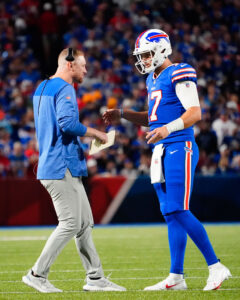 The Bills prioritized continuity at their coordinator positions, retaining Brady and promoting Babich. Brady’s offense leaned more on the run game, and while Allen did not curb his turnover issue following Ken Dorsey‘s firing, the Bills did fare better in the win column with the former Panthers OC calling the shots. The Bills have ranked as a top-six offense in each of the past four years, owing more to Allen’s prodigious talents than the play-caller. Considering the Bills only interviewed one other candidate — Buccaneers QBs coach Thad Lewis, satisfying the Rooney Rule — they did not appear interested in ditching another OC.
The Bills prioritized continuity at their coordinator positions, retaining Brady and promoting Babich. Brady’s offense leaned more on the run game, and while Allen did not curb his turnover issue following Ken Dorsey‘s firing, the Bills did fare better in the win column with the former Panthers OC calling the shots. The Bills have ranked as a top-six offense in each of the past four years, owing more to Allen’s prodigious talents than the play-caller. Considering the Bills only interviewed one other candidate — Buccaneers QBs coach Thad Lewis, satisfying the Rooney Rule — they did not appear interested in ditching another OC.
Forcing out Leslie Frazier and calling the shots in 2023, McDermott is considering handing the play sheet to Babich. The younger of two Babiches to work for the Bills in recent years, Bobby drew DC interview requests from the Dolphins, Giants and Packers. Babich has been on the Bills’ staff since 2017, being Hyde and Poyer’s position coach for four seasons before coaching linebackers over the past two. Father Bob Babich, a former NFL DC, had coached Buffalo’s LBs from 2017-21. The production of Buffalo’s safety tandem, along with Milano’s 2022 All-Pro season, garnered Babich interest elsewhere.
The Bills have routinely put up high defensive rankings in the regular season, being in the top four in scoring four times since 2019, before crumbling in the playoffs. Last season’s undoing — against a Chiefs offense that had been oddly shaky all season — may have been less on the coaches, as injuries sidelined roughly half the team’s starting defense. This included Milano, who missed most of last season with a severe leg injury. Despite making it back in time for training camp, the All-Pro LB faces another lengthy rehab timetable due.
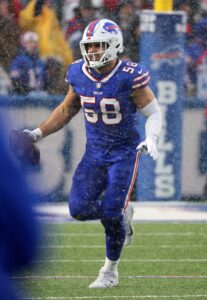 Milano’s biceps injury may not keep him out all season, but even if he returns late, the Bills are not getting much return on their recent extension (two years, $28.33MM). The 2017 fifth-rounder turned 30 this offseason, and although no guarantees are on his deal beyond 2024, a 2022 restructure will make it pricey to move on next year. It would cost the Bills $17.2MM in dead money (while generating no cap savings) to cut Milano in 2025. The team has its top linebacker signed through 2026, but the converted safety is no longer dependable. Dorian Williams, a 2023 third-rounder, will have the first shot at replacing him as a three-down player post-Dodson.
Milano’s biceps injury may not keep him out all season, but even if he returns late, the Bills are not getting much return on their recent extension (two years, $28.33MM). The 2017 fifth-rounder turned 30 this offseason, and although no guarantees are on his deal beyond 2024, a 2022 restructure will make it pricey to move on next year. It would cost the Bills $17.2MM in dead money (while generating no cap savings) to cut Milano in 2025. The team has its top linebacker signed through 2026, but the converted safety is no longer dependable. Dorian Williams, a 2023 third-rounder, will have the first shot at replacing him as a three-down player post-Dodson.
While Rousseau only totaled five sacks last season, he set career-highs in TFLs (12) and QB hits (18). The 2021 first-rounder ranked 41st in pressures as well and has batted down four passes in each of his three seasons. The Bills will continue to work with the Miami alum, who is now their top edge rusher with Floyd gone and Miller’s form uncertain. Rousseau will probably need to get home more often to prop up this year’s Bills pass rush, but Oliver’s presence will continue to help the cause.
Top 10 cap charges for 2024:
- Josh Allen, QB: $30.36MM
- Von Miller, DE: $15.15MM
- Matt Milano, LB: $12.44MM
- Dion Dawkins, LT: $11.51MM
- Ed Oliver, DT: $9.73MM
- Taron Johnson, CB: $8.45MM
- Dawson Knox, TE: $7.73MM
- DaQuan Jones, DT: $4.5MM
- Tyler Bass, K: $4.42MM
- Connor McGovern, C: $4.16MM
Allen’s presence should keep Bills championship windows open throughout his prime, but the team will test its quarterback with the rearranged receiving corps. Buffalo does return a strong offensive line and has James Cook on a rookie deal through 2025, providing some cover for the superstar QB.
The two agonizing divisional-round losses to the Chiefs have provided a roadblock, denying Super Bowl-caliber teams. Buffalo has continued to respond from postseason defeats well, earning No. 2 seeds in 2022 and ’23. More questions abound regarding the Bills’ capabilities this year, and the team will need to navigate the Dolphins once again and what should be (QB health permitting) a more imposing Jets outfit. Allen and his remaining veteran supporting cast still make the AFC East run through Buffalo, but the margin for error — both in the division and in the AFC — should probably be considered slimmer this year due to the events of this offseason.
By Sam Robinson |
at August 20, 2024 10:17 pm
Continuing to zag when it comes to quarterback development and roster construction, the Packers centered their offseason around a Jordan Love commitment. After seeing a promising second half from their Aaron Rodgers successor nearly produce a voyage to the NFC championship game, the Pack are back in the franchise-QB payment business.
Love’s monster extension complements an offense that lost two of its veteran pillars — in Aaron Jones and David Bakhtiari — as the team continues to build around lofty investments on the defensive side. But the Packers’ Love decision, which is certainly a different route when it comes to an experience-to-dollars ratio, will define the franchise for the foreseeable future.
Extensions and restructures:
When Rodgers agreed to his first extension during his 2008 starter debut season — a six-year, $63.52MM deal, illustrating where QB contracts have gone — it did not check in as a record-setting payday. It was not particularly close, either. Carson Palmer‘s Bengals extension outflanked Rodgers’ first Packers deal. So did Peyton Manning‘s 2004 Colts payday, along with Tom Brady‘s first Patriots re-up and Ben Roethlisberger‘s initial Steelers extension. That gave the Packers a runway to better learn about Rodgers’ capabilities. The organization was certainly proven right and suddenly had a bargain deal at quarterback until the 2013 offseason.
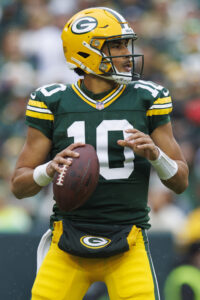 Today’s skyrocketing QB market changed the equation for Love and the team, which needed to match an NFL-record AAV for a player with 18 regular-season starts. This era of one-upping differs from how a few teams handled QB contracts even following Rodgers’ 2013 extension. No one topped the Packer QB’s $22MM-per-year deal until the 2016 offseason. A host of deals in 2015 (for Roethlisberger, Wilson, Cam Newton, Eli Manning and Philip Rivers) settled between $20MM and $21.9MM per year, acknowledging Rodgers’ place in the game. For the most part, these sort of acknowledgments no longer exist.
Today’s skyrocketing QB market changed the equation for Love and the team, which needed to match an NFL-record AAV for a player with 18 regular-season starts. This era of one-upping differs from how a few teams handled QB contracts even following Rodgers’ 2013 extension. No one topped the Packer QB’s $22MM-per-year deal until the 2016 offseason. A host of deals in 2015 (for Roethlisberger, Wilson, Cam Newton, Eli Manning and Philip Rivers) settled between $20MM and $21.9MM per year, acknowledging Rodgers’ place in the game. For the most part, these sort of acknowledgments no longer exist.
Love’s deal not coming with a discount keeps the Packers in the high-cost QB business, as 2023 — which featured near-record-tying (pre-Russell Wilson, at least) dead money from the Rodgers trade — did not bring a reprieve. Diving right back into a top-market contract, as Rodgers’ deal came off the books this year, ramps up the pressure for Brian Gutekunst and Co. to be right on the player they traded up for in 2020.
Both parties wanted this deal done by training camp, and Love held in to complete the process. The Packers agreeing to a half-measure extension, rather than pick up a fully guaranteed fifth-year option on a player who entered 2023 with one career start, provided Love leverage. The QB capitalized, joining Tua Tagovailoa in this regard, on his contract-year status. The Packers would have faced a $40MM-plus 2025 cap hold had Love played out this season and brought the threat of a franchise tag. Whereas teams have held more control during this process by extending a first-round quarterback after his third season, Green Bay’s outlier three-year apprenticeship program did not give the team that option. After a promising close to last season, Love was able to exert more control in this process.
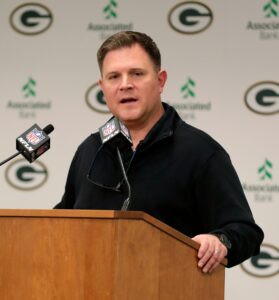 Struggling during much of the season’s first half, Love led the NFL in QBR from Weeks 11-18 — a stretch that included 18 TD passes and one INT. The four-year veteran was then tremendous in the Packers’ wild-card upset over the Cowboys, before leading the NFC’s first competitive No. 7 seed to a narrow loss over the eventual NFC champion 49ers. Love obviously made for an atypical extension candidate, but the Packers are all in.
Struggling during much of the season’s first half, Love led the NFL in QBR from Weeks 11-18 — a stretch that included 18 TD passes and one INT. The four-year veteran was then tremendous in the Packers’ wild-card upset over the Cowboys, before leading the NFC’s first competitive No. 7 seed to a narrow loss over the eventual NFC champion 49ers. Love obviously made for an atypical extension candidate, but the Packers are all in.
Contract structure was believed to be the final issue for Love’s camp. A team that does not do post-Year 1 guarantees beyond signing bonuses again bent for a quarterback, and Love secured the increasingly popular rolling guarantee structure on this deal.
Love’s 2025 salary is guaranteed at signing, and his 2026 base salary is partially guaranteed already. That 2026 figure will become fully guaranteed in 2025. That structure pertains to Love’s 2027 base salary as well. The team guaranteed $20MM of the QB’s ’27 base ($41.9MM) for injury at signing; that $20MM shifts to a full guarantee a year early. Love did remarkably well on this contract and will be positioned, should his late-season form be indicative of his career trajectory, to cash in again before age 30.
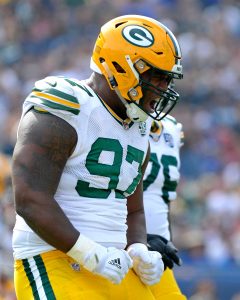 The Packers took care of Clark before his contract year, bringing up an extension earlier this offseason and completing the agreement before training camp. Despite coming into the league in 2016, Clark will not turn 29 until October. The Pack should have more prime years coming from the former first-round pick — one of six first-rounders still on Green Bay’s defense — and they completed a deal without going into the top 10 on a swiftly rising D-tackle market. Clark’s $21.33MM AAV both marked a notable raise and the 11th-highest-paid DT accord.
The Packers took care of Clark before his contract year, bringing up an extension earlier this offseason and completing the agreement before training camp. Despite coming into the league in 2016, Clark will not turn 29 until October. The Pack should have more prime years coming from the former first-round pick — one of six first-rounders still on Green Bay’s defense — and they completed a deal without going into the top 10 on a swiftly rising D-tackle market. Clark’s $21.33MM AAV both marked a notable raise and the 11th-highest-paid DT accord.
Keeping with the Pack’s non-QB standard, the only guaranteed money in Clark’s deal comes from his signing bonus. But the eighth-year DT is owed a $7.5MM roster bonus next March. That ups the practical guarantee to $25MM. It would cost the Packers $17MM in dead money to move on from Clark in 2026, due to signing bonus proration. This gives the veteran a good chance of staying on this through-2027 deal for at least three seasons. Clark is due an $11MM roster bonus in 2026.
The UCLA alum ranks seventh in starts (109) by a Packer D-lineman. He can move into first all time on this contract; Dave Hanner (1953-64) holds that mark at 141.
Free agency additions:
- Xavier McKinney, S. Four years, $67MM ($23MM guaranteed)
- Josh Jacobs, RB. Four years, $48MM ($12.5MM guaranteed)
- Greg Joseph, K. One year, $1.29MM
- Andre Dillard, T. One year, $1.13MM
- Jacob Eason, QB. One year, $985K
Although Hard Knocks primarily focused on the Giants’ Saquon Barkley loss, it also revealed surprise on Giants GM Joe Schoen‘s part upon learning McKinney’s contract.After factoring in a McKinney extension upon letting Julian Love walk in 2023, the Giants did not keep him off the market for the transition tag sum ($13.8MM). That may have been a mistake. The former second-round pick proceeded to score a top-four safety contract, with the Packers paying up to address an issue.
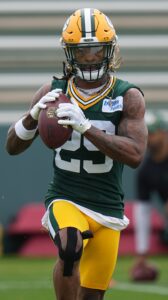 Green Bay moved on from its top three safeties last year (Darnell Savage. Jonathan Owens, Rudy Ford) and paid McKinney, who submitted two quality Giants seasons and two injury-plagued years. After a McKinney ATV accident led to him missing much of the 2022 campaign, Pro Football Focus graded him as the No. 4 overall safety last season. McKinney, 26, represents an out-of-character move from the Packers, who are not known for paying safeties or signing off on — even in the Gutekunst era — top-market free agency accords.
Green Bay moved on from its top three safeties last year (Darnell Savage. Jonathan Owens, Rudy Ford) and paid McKinney, who submitted two quality Giants seasons and two injury-plagued years. After a McKinney ATV accident led to him missing much of the 2022 campaign, Pro Football Focus graded him as the No. 4 overall safety last season. McKinney, 26, represents an out-of-character move from the Packers, who are not known for paying safeties or signing off on — even in the Gutekunst era — top-market free agency accords.
McKinney played the Jessie Bates role on this year’s market. As another macro safety evaluation appeared to take place this year — leading to the releases of several prominent veterans and a slew of mid-market payments for unrestricted free agents — McKinney’s price came in nearly $8MM higher (in terms of AAV) than any other UFA safety. After Bates (four years, $64MM) rewarded the Falcons for their high-cost addition, the Packers won a bidding war for McKinney, who has also shown quality ball skills in his career. The Alabama alum intercepted five passes in 2021 and three last season. Referring to himself as the game’s best safety, McKinney will attempt to prove it in Wisconsin.
Perhaps the most notable participant on a historically busy day at the running back position, the Packers said goodbye to a seven-year regular (Aaron Jones) and brought in Jacobs. The five-year Raiders starter is three years younger than Jones, and while the former has not proven as dynamic, the incumbent approaching his 30th birthday undoubtedly played into Green Bay’s thinking here. Jacobs, 26, won the 2022 rushing title but is coming off a far less productive year on the franchise tag. The Packers will bet on more prime years remaining for Jacobs, who was part of last year’s famous RB macro evaluation.
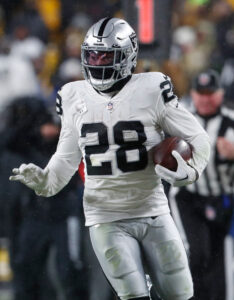 The Raiders, Giants and Cowboys respectively not extending their tagged running backs — after the Packers had given Jones a pay cut and the Cowboys (Ezekiel Elliott) and Vikings (Dalvin Cook) had released longtime starters — prompted a Zoom meeting among key backs about their state of the union. Jacobs, who rampaged for an NFL-high 2,053 scrimmage yards and 12 touchdowns in 2022, accumulated only 1,101 last season — before missing four games due to multiple contusions. After producing the fifth-most rushing yards over expected in 2022 (158), Jacobs finished with the fifth-worst number (minus-86) last year.
The Raiders, Giants and Cowboys respectively not extending their tagged running backs — after the Packers had given Jones a pay cut and the Cowboys (Ezekiel Elliott) and Vikings (Dalvin Cook) had released longtime starters — prompted a Zoom meeting among key backs about their state of the union. Jacobs, who rampaged for an NFL-high 2,053 scrimmage yards and 12 touchdowns in 2022, accumulated only 1,101 last season — before missing four games due to multiple contusions. After producing the fifth-most rushing yards over expected in 2022 (158), Jacobs finished with the fifth-worst number (minus-86) last year.
Matt LaFleur admitted he was caught off-guard by how the Packers’ running back situation shook out, and Jacobs also indicated he turned down more money elsewhere. More pass-game opportunities should be expected to emerge for Jacobs, who did catch 107 combined passes from 2021-22.
Green Bay’s Jones-to-Jacobs transition is also interesting due to the younger back having more career touches (1,502) compared to Jones (1,449). Jacobs has missed 10 career games; since 2019, Jones has also missed 10. Six of those came last season. While the Packers guaranteed Jacobs just $12.5MM, he is due a $5.93MM signing bonus if on Green Bay’s roster on Day 5 of the 2025 league year.
This profiles as a two-year deal before a year-to-year scenario takes shape in 2026. Even if Jacobs’ 2025 roster bonus is included, he still fetched far less in fully guaranteed money than Barkley, who secured $26MM from the Eagles despite a well-documented injury history and a higher touch total.
Re-signings:
- Keisean Nixon, CB. Three years, $18MM ($6.5MM guaranteed)
- Corey Ballentine, CB. One year, $2.1MM ($500K guaranteed)
- AJ Dillon, RB. One year, $2.74MM ($168K guaranteed)
- Eric Wilson, LB. One year, $1.38MM ($168K guaranteed)
- Robert Rochell, CB. One year, $1.1MM
Adding slot cornerback to his duties along with return specialist, Nixon scored a solid veteran deal two years after following Rich Bisaccia from Las Vegas. The Raiders nontendered Nixon as an RFA in 2022, leading to Bisaccia’s new team reaching out. Nixon mostly focused on a return-game role in 2022; he blazed to first-team All-Pro status as a kick returner. Nixon repeated that feat in 2023, and the Packers re-signed him just before the NFL radically revamped its kickoff setup. That change stands to make Nixon more valuable.
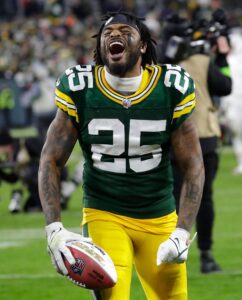 Of course, Nixon receiving a $6MM-per-year deal was also contingent on him continuing as the team’s slot corner. The Packers abandoned their Rasul Douglas slot experiment during the 2022 season and went into last year with Nixon in that role. He played 937 defensive snaps — by far a career high — and while PFF graded him outside the top 80 and Pro-Football-Reference’s coverage metrics applied higher numbers in terms of completion percentage (77.8%) and passer rating (104.8), the Packers clearly value the former UDFA in a cornerback group that features little certainty beyond Jaire Alexander.
Of course, Nixon receiving a $6MM-per-year deal was also contingent on him continuing as the team’s slot corner. The Packers abandoned their Rasul Douglas slot experiment during the 2022 season and went into last year with Nixon in that role. He played 937 defensive snaps — by far a career high — and while PFF graded him outside the top 80 and Pro-Football-Reference’s coverage metrics applied higher numbers in terms of completion percentage (77.8%) and passer rating (104.8), the Packers clearly value the former UDFA in a cornerback group that features little certainty beyond Jaire Alexander.
Dillon did not do nearly as well in free agency. On a crowded RB market, the inside grinder settled for a deal that provided next to no guaranteed money. Jones’ powerful complementary option for four seasons, Dillon averaged a career-worst 3.4 yards per carry last year — his first under 4.1 per tote.
The former second-round pick has been effective in the past, and while he said a bit more money may have been out there for him, the Green Bay aficionado — Dillon plans to camp in the city following his NFL career — entered training camp on the roster bubble.
Notable losses:
- David Bakhtiari, LT (released)
- De’Vondre Campbell, LB (post-June 1 cut)
- Josiah Deguara, FB
- Rudy Ford, S
- Aaron Jones, RB (released)
- Yosh Nijman, OL
- Jonathan Owens, RB
- Jon Runyan Jr., G
- Darnell Savage, S
- Patrick Taylor, RB
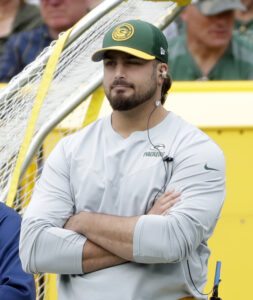 As Shaq Barrett and Jason Pierre-Paul ran wild during the 2020 NFC championship game, Bakhtiari’s absence created one of the bigger what-ifs in offensive line history. The Packers saw an ACL tear sustained during a New Year’s Eve practice change their left tackle course, as Bakhtiari — a first-team All-Pro that season and a five-time All-Pro over his career — has been unable to stay healthy since.
As Shaq Barrett and Jason Pierre-Paul ran wild during the 2020 NFC championship game, Bakhtiari’s absence created one of the bigger what-ifs in offensive line history. The Packers saw an ACL tear sustained during a New Year’s Eve practice change their left tackle course, as Bakhtiari — a first-team All-Pro that season and a five-time All-Pro over his career — has been unable to stay healthy since.
The stalwart LT missed all but 27 snaps in 2021, returning to the sideline after debuting in a meaningless Week 18 game, and — after showing promising form in 11 games back in 2022 — missed almost all of last season. This all pointed to a 2024 separation.
Green Bay had restructured Bakhtiari’s deal in 2021 and ’22, immediately seeing the four-year, $92MM extension — only Rodgers and Love have signed more lucrative deals among Packers — become an issue quickly due to the once-dependable LT signing it weeks before his knee injury. Bakhtiari, who has undergone five knee surgeries since that fateful practice, will count $18.15MM in dead money this year. Like Rodgers’ dead cap hit in 2023, Bakhtiari’s contract will be off the team’s books for good after a year. The 11-year veteran, 33 in September, wants to keep playing but has not caught on anywhere.
Read more
Post-Ahman Green, Packers RB1s had been one-contract players. Ryan Grant and Eddie Lacy did not see second contracts, and the team’s rushing attack had bottomed out by the mid-2010s. Enter Jones and Jamaal Williams. The Packers continued their one-contract RB stretch with Williams, but Jones became a priority. Green Bay gave its lead back a four-year, $48MM deal shortly after a host of extensions — for fellow 2017 draftees Christian McCaffrey, Alvin Kamara, Dalvin Cook and Joe Mixon — set the market. A former fifth-round pick, Jones rewarded the team by running his 1,000-yard season count to three and being one of the NFL’s most well-rounded backs.
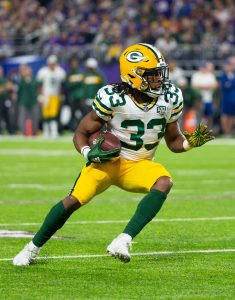 Jones powered a Packers offense flooded with rookie contracts to the playoffs, zooming to five straight 100-yard rushing performances to close out last season. Jones showing vintage form during that stretch somewhat obscured his missing six games due to multiple injuries early that season.
Jones powered a Packers offense flooded with rookie contracts to the playoffs, zooming to five straight 100-yard rushing performances to close out last season. Jones showing vintage form during that stretch somewhat obscured his missing six games due to multiple injuries early that season.
The Packers gave Jones a $5MM pay cut in exchange for 2023 guarantees last year, with that transaction coming first during a wave of developments that impacted the RB position’s value. Gutekunst said at the Combine he expected Jones back, but that ended up being contingent on the accomplished vet taking a bigger pay cut. Jones balked, being released shortly before the Jacobs signing commenced.
This closed out one of the better skill-position partnerships in modern Packers history. Jones was easily the best running back of the Rodgers era, and his 2023 work gave Love a solid starter onramp. The Vikings observed this firsthand and quickly signed the eighth-year vet to a one-year, $7MM deal. Jones is expected to be the clear starter in Minnesota, which is making a midlevel bet on another 2017 draftee a year after deeming Cook too expensive. The Packers having conserved Jones — as Williams and Dillon operated as regular 1-B options — may extend his career, and their rivals will count on the UTEP alum having one more quality season in him.
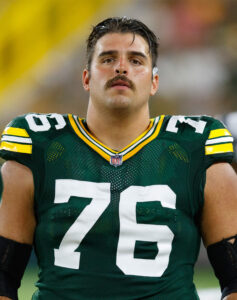 With Elgton Jenkins one of the NFL’s highest-paid guards, the Packers were never expected to offer much competition in the Runyan market. One of five guard FAs who commanded an eight-figure-per-year salary (from the Giants), the second-generation NFL blocker leaves Green Bay after three starter seasons. A former sixth-round find, Runyan started at both left and right guard in Green Bay. He ranked 17th among interior O-linemen in pass block win rate last season.
With Elgton Jenkins one of the NFL’s highest-paid guards, the Packers were never expected to offer much competition in the Runyan market. One of five guard FAs who commanded an eight-figure-per-year salary (from the Giants), the second-generation NFL blocker leaves Green Bay after three starter seasons. A former sixth-round find, Runyan started at both left and right guard in Green Bay. He ranked 17th among interior O-linemen in pass block win rate last season.
Savage’s Jacksonville defection leaves the Green Bay defense with only six first-round picks. How will it survive? Savage’s stock eventually placed him on the expanding middle tier at the safety position, becoming one of the many non-Bates/McKinney safeties to land a deal between $6-$9MM per year over the past two offseasons. While Savage showed versatility by contributing in the slot, he also lost snaps during a down 2022 season. Viewing the 2019 first-rounder as above average in coverage and elite against the run last season, PFF ranked him 15th among safeties.
The Packers still viewed a big upgrade as a priority, letting Savage, Owens and Ford walk and paying up for McKinney. Due to the Packers restructuring Savage’s rookie deal, they will carry more than $5MM in dead money by not re-signing him.
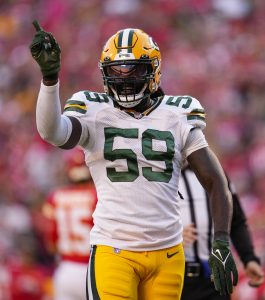 Campbell stabilized his career in Green Bay, coming over after a one-and-done Arizona season generated minimal interest as a 2021 free agent. After a first-team All-Pro 2021 season — when he provided a significant boost to an injury-riddled Packers team — Campbell rocketed back to relevance and scored a five-year, $50MM pact. The Packers were never expected to roster Campbell for the duration of that lengthy accord, and they cut ties with him two years into it. The three remaining years of signing bonus proration will will tag the Pack with $3.7MM in dead money this year and $7.9MM in 2025.
Campbell stabilized his career in Green Bay, coming over after a one-and-done Arizona season generated minimal interest as a 2021 free agent. After a first-team All-Pro 2021 season — when he provided a significant boost to an injury-riddled Packers team — Campbell rocketed back to relevance and scored a five-year, $50MM pact. The Packers were never expected to roster Campbell for the duration of that lengthy accord, and they cut ties with him two years into it. The three remaining years of signing bonus proration will will tag the Pack with $3.7MM in dead money this year and $7.9MM in 2025.
Campbell, whom PFF tabbed as a top-15 off-ball ‘backer in 2021 and ’22, missed six games last season and turned 31 this offseason. He signed to be Fred Warner‘s three-down tandem partner while Dre Greenlaw recovers from his Super Bowl Achilles tear. Campbell (40 starts with Green Bay) figures to be a part-timer after Greenlaw returns.
Draft:
- Round 1, No. 25: Jordan Morgan (T, Arizona) (signed)
- Round 2, No. 45 (from Broncos through Saints): Edgerrin Cooper (LB, Texas A&M) (signed)
- Round 2, No. 58: Javon Bullard (S, Georgia) (signed)
- Round 3, No. 88: MarShawn Lloyd (RB, USC) (signed)
- Round 3, No. 91 (from Bills): Ty’Ron Hopper (LB, Missouri) (signed)
- Round 4, No. 111 (from Jets): Evan Williams (S, Oregon) (signed)
- Round 5, No. 163 (from Bills): Jacob Monk (C, Duke) (signed)
- Round 5, No. 169: Kitan Oladapo (S, Oregon State) (signed)
- Round 6, No. 202: Travis Glover (T, Georgia State) (signed)
- Round 7, No. 245: Michael Pratt (QB, Tulane) (signed)
- Round 7, No. 255: Kalen King (CB, Penn State) (signed)
As the Packers have placed a heavy emphasis on defense early in drafts, Morgan joins Love as the only offensive players the franchise has chosen in Round 1 over the past 12 years. While the Love pick generated controversy due to Rodgers’ status and the move not helping Green Bay’s Super Bowl-contending teams in 2020 and ’21, the team is planning for Morgan to help Love immediately. The Packers appear to have a multi-pronged plan in place for the former Pac-12 standout.
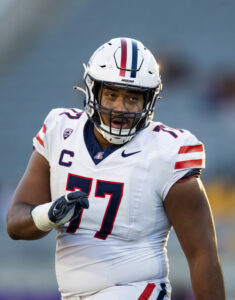 Morgan excelled at tackle with the Wildcats, bouncing back from a 2022 ACL tear to craft a first-round resume despite a deep 2024 tackle crop. Making starts at left tackle as early as his 2019 freshman season, Morgan earned first-team all-conference acclaim for his blindside work last year. LaFleur said Morgan would start the offseason program at that position, but by training camp, 2023 primary starter Rasheed Walker joined incumbent RT Zach Tom as the tackle starters. Morgan slid to right guard, and although the team is still giving him reps at tackle in case of emergency, a “best five” plan is in the works.
Morgan excelled at tackle with the Wildcats, bouncing back from a 2022 ACL tear to craft a first-round resume despite a deep 2024 tackle crop. Making starts at left tackle as early as his 2019 freshman season, Morgan earned first-team all-conference acclaim for his blindside work last year. LaFleur said Morgan would start the offseason program at that position, but by training camp, 2023 primary starter Rasheed Walker joined incumbent RT Zach Tom as the tackle starters. Morgan slid to right guard, and although the team is still giving him reps at tackle in case of emergency, a “best five” plan is in the works.
Six of the eight tackles chosen in Round 1 are switching positions in Year 1, and the Packers could have a multiyear guard plan lined up for Morgan. Walker and Tom are on their rookie contracts through the 2025 season, though Morgan shifting to his natural position during the season or in 2025 should be on the radar. The Cardinals (Paris Johnson Jr.) and Steelers (Broderick Jones) have moved their 2023 first-round tackles to LT after initially stationing them elsewhere as rookies.
The Lions had viewed the Packers as a threat to leapfrog them for Terrion Arnold, and the Seahawks discussed the No. 16 overall pick with Green Bay. Detroit traded up five spots, moving one position ahead of Green Bay for the Alabama cornerback. No corner help arrived in this draft, but the Packers covered themselves at two other defensive positions.
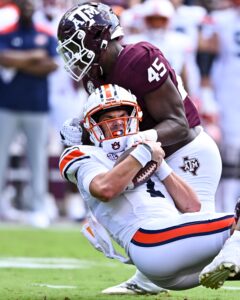 Trading down from No. 41 — the final draft slot from the Rodgers trade — the Packers nabbed Cooper before using their own second-rounder on Bullard. Both should be expected to start at some point, but as of now, the latter looks more likely to be in Green Bay’s Week 1 lineup. Cooper has missed multiple weeks due to a hip injury and had not previously supplanted 2021 sixth-rounder Isaiah McDuffie for the starting gig. McDuffie played 48% of Green Bay’s defensive snaps last season and may see that number expand post-Campbell, but Cooper will be lurking.
Trading down from No. 41 — the final draft slot from the Rodgers trade — the Packers nabbed Cooper before using their own second-rounder on Bullard. Both should be expected to start at some point, but as of now, the latter looks more likely to be in Green Bay’s Week 1 lineup. Cooper has missed multiple weeks due to a hip injury and had not previously supplanted 2021 sixth-rounder Isaiah McDuffie for the starting gig. McDuffie played 48% of Green Bay’s defensive snaps last season and may see that number expand post-Campbell, but Cooper will be lurking.
With the Packers making McKinney the priciest free agency addition in team history, a cost-controlled complementary piece becomes critical. The second safety chosen in this draft — albeit in a thinner class at the position — Bullard started for two seasons at Georgia. He intercepted two passes in the Bulldogs’ national championship demolition over TCU and earned second-team All-SEC honors last season. Bullard rejoins ex-Georgia teammates Quay Walker and Devonte Wyatt on Green Bay’s defense.
Not big on investing early-round draft capital in off-ball linebackers for over a decade, the Packers have now chosen three Day 1 or Day 2 ILBs in three years. Cooper and Hopper followed Walker into Green Bay’s LB room, adding some muscle to the team’s second-level troops.
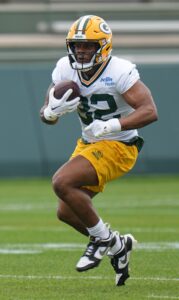 The Pack made Cooper this year’s first off-ball linebacker chosen, after seeing him become a first-team All-American in 2023. Showing tremendous promise as a blitzer, Cooper tallied eight sacks and 17 tackles for loss last season. It would surprise if he was not challenging for a starting role soon. A Florida transfer, Hopper followed Mizzou LBs Nick Bolton and Sean Weatherspoon as a Butkus Award finalist. After the Pack went from 2007-21 without choosing a non-rush ‘backer in the first three rounds, the Walker-Cooper-Hopper tandem gives them plenty of options over the next few years.
The Pack made Cooper this year’s first off-ball linebacker chosen, after seeing him become a first-team All-American in 2023. Showing tremendous promise as a blitzer, Cooper tallied eight sacks and 17 tackles for loss last season. It would surprise if he was not challenging for a starting role soon. A Florida transfer, Hopper followed Mizzou LBs Nick Bolton and Sean Weatherspoon as a Butkus Award finalist. After the Pack went from 2007-21 without choosing a non-rush ‘backer in the first three rounds, the Walker-Cooper-Hopper tandem gives them plenty of options over the next few years.
The third running back chosen, Lloyd joins a currently crowded backfield. His arrival probably makes this Dillon’s final Packers season. The Giants and Cowboys had the USC product on their radars; either having selected him would have made a path to a starting lineup clearer.
With Jacobs in the fold for at least two seasons, the Packers added a cheap supplementary option behind a $12MM-per-year player. Lloyd transferred from South Carolina to USC in 2023, totaling a career-high 820 rushing yards (7.1 per carry) last season. He tallied nine rushing touchdowns with the Gamecocks in 2022. Potentially a long-term threat to Jacobs, Lloyd may be a short-term IR candidate due to a hamstring injury.
Other:
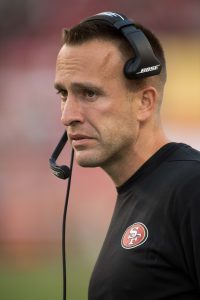 For the first time in 16 years, the Packers will use a 4-3 look as their primary base defense. That will add clarity to Lukas Van Ness‘ position, as the 2023 first-round ‘tweener now plays defensive end. This change comes about because the Packers dipped into the college ranks to find their next DC. After attempting to give the job to former Wisconsin DC Jim Leonhard three years ago, the team handed the reins to Barry. A rough regular season that included a 27th-place defensive DVOA finish — featuring Baker Mayfield carving up Barry’s defense and Tommy DeVito excelling on a nationally televised stage — prompted the Packers to cut bait and went off the board with their next hire. Barry landed as the Dolphins’ LBs coach.
For the first time in 16 years, the Packers will use a 4-3 look as their primary base defense. That will add clarity to Lukas Van Ness‘ position, as the 2023 first-round ‘tweener now plays defensive end. This change comes about because the Packers dipped into the college ranks to find their next DC. After attempting to give the job to former Wisconsin DC Jim Leonhard three years ago, the team handed the reins to Barry. A rough regular season that included a 27th-place defensive DVOA finish — featuring Baker Mayfield carving up Barry’s defense and Tommy DeVito excelling on a nationally televised stage — prompted the Packers to cut bait and went off the board with their next hire. Barry landed as the Dolphins’ LBs coach.
Tasked with maximizing the talent on the Packers’ first-rounder-laden defense, Hafley comes over from Boston College. The recent ACC leader did not mince words about the NCAA’s chaotic landscape pushing him back to the pros, and he did well to land a job with the only team that interviewed him. Hafley, 45, and LaFleur both coached under Kyle Shanahan; though, they were never on the same staff. Hafley worked with Shanahan in Cleveland (2014) and San Francisco (2017-18), serving as a DBs coach each time. He spent the past four seasons as Boston College’s HC, a gig Bill O’Brien now holds.
A mediocre Power 5 program, BC ranked 86th and 100th in scoring defense over the past two seasons. While the Eagles’ defense did place 31st in 2021, Hafley may not have been LaFleur’s first choice. The Packers announced the Hafley hire on January 31, the same day they interviewed Zach Orr. Green Bay was believed to have offered Orr the job, but with a path upward in Baltimore (he took the Ravens’ gig the following day), Orr stayed put. Hafley and LaFleur’s friendship aside, this is an interesting footnote as the two begin working together.
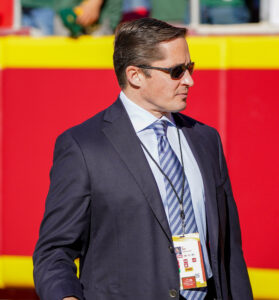 With no owner in place due to the Packers’ unique arrangement with Green Bay, this presidential role brings the most power of any across the league. The bylaws governing the Packers’ board of directors dictate that members must retire upon turning 70, which will be the case for Murphy on July 13, 2025. Murphy has served as Packers president since 2007, presiding over the awkward Brett Favre-to-Aaron Rodgers transition and then the 2021 standoff with Rodgers. Murphy signed off on the 2020 Love trade-up and the 2023 Rodgers trade and will continue in his role for one more season.
With no owner in place due to the Packers’ unique arrangement with Green Bay, this presidential role brings the most power of any across the league. The bylaws governing the Packers’ board of directors dictate that members must retire upon turning 70, which will be the case for Murphy on July 13, 2025. Murphy has served as Packers president since 2007, presiding over the awkward Brett Favre-to-Aaron Rodgers transition and then the 2021 standoff with Rodgers. Murphy signed off on the 2020 Love trade-up and the 2023 Rodgers trade and will continue in his role for one more season.
The son of former Super Bowl-winning 49ers exec Carmen Policy, Ed has been with the Packers since 2012. The 53-year-old staffer currently serves as the team’s COO and general counsel, and he won a pursuit that included as many as 90 potential candidates. That list, which included Commanders president Jason Wright, winnowed to 10 by Memorial Day. Formerly the Arena Football League president, Policy will soon step into a coveted role.
After losing much of the past two seasons to injury, Stokes is near the finish line of a journey back to the Pack’s starting lineup. Knee and foot surgeries, after going down midway through the 2022 season, affected Stokes’ 2023. The former first-rounder attributed his run of hamstring issues — which capped his ’23 season at three games — to overcompensation following his foot issue. After trading Rasul Douglas to the Bills, the Packers did not draft a corner until Round 7. Stokes, who showed promise in his rookie season, clocked two sub-4.3-second 40 times at his 2021 pro day and has a chance to regain value ahead of what could be an interesting free agency next year.
Top 10 cap charges for 2024:
- Kenny Clark, DT: $26.37MM
- Jaire Alexander, CB: $23.49MM
- Jordan Love, QB: $20.76MM
- Elgton Jenkins, G: $14.5MM
- Preston Smith, DE: $14.12MM
- Rashan Gary, DE: $11.15MM
- Xavier McKinney, S: $7.8MM
- Josh Jacobs, RB: $5.31MM
- Keisean Nixon, S: $3.99MM
- Lukas Van Ness, DE: $3.95MM
Losing Bakhtiari, the Packers have just one player (Preston Smith) north of 30. This young roster has received more buzz ahead of Love’s second season, and the team will attempt to catch up to the soaring Lions — as the Bears maneuvered their way to Caleb Williams. The Lions’ roster talent and the Bears having restarted their QB contract clock notwithstanding, it will be difficult to foresee the Packers not being a contender this season.
More pressure will be applied to Love, of course, thanks to the monster extension he secured with far less game experience compared to just about every modern QB given a big-ticket deal. The Packers, however, return their top four wide receivers — with the group’s mysterious hierarchy set to bedevil fantasy GMs — and added Morgan to a promising O-line returning its other four starters.
Green Bay’s latest unorthodox QB approach skipped the rookie-contract shortcut other burgeoning Super Bowl threats have capitalized on during the rookie-scale era, but the team being right on Love will minimize that oft-discussed component. Love delivering on this contract would begin an unfathomable QB stretch for this franchise, as the intriguing starter is the gateway to a reality in which the Packers enjoy 40-plus years of stability at the game’s centerpiece position.
 Playing 17-game seasons and coming along in a pass-friendly era, Brown now holds the top two spots on the franchise’s single-season receiving yardage list. Brown broke Mike Quick‘s 39-year-old record in 2022 and eclipsed it again last season. The Eagles did well to pry Brown from a Titans team that erred in assessing the changing WR market two years ago, and Philly’s latest agreement contributed to another positional boom this year.
Playing 17-game seasons and coming along in a pass-friendly era, Brown now holds the top two spots on the franchise’s single-season receiving yardage list. Brown broke Mike Quick‘s 39-year-old record in 2022 and eclipsed it again last season. The Eagles did well to pry Brown from a Titans team that erred in assessing the changing WR market two years ago, and Philly’s latest agreement contributed to another positional boom this year. Just before the Brown extension, the Eagles made a bit of transaction history by locking down Smith. Since the 2011 CBA introduced the fifth-year option, teams have made those decisions annually since the first draft class eligible brought those decisions in 2014. No team in that span had paid a first-round receiver with two years of rookie-deal control remaining. The Eagles became the first, locking down Smith on an extension that became rather team-friendly as the offseason progressed. Smith’s deal both gives the Eagles five years of control and sets up the former Heisman winner as the NFL’s 11th-highest-paid receiver going into the season.
Just before the Brown extension, the Eagles made a bit of transaction history by locking down Smith. Since the 2011 CBA introduced the fifth-year option, teams have made those decisions annually since the first draft class eligible brought those decisions in 2014. No team in that span had paid a first-round receiver with two years of rookie-deal control remaining. The Eagles became the first, locking down Smith on an extension that became rather team-friendly as the offseason progressed. Smith’s deal both gives the Eagles five years of control and sets up the former Heisman winner as the NFL’s 11th-highest-paid receiver going into the season. Developing under acclaimed O-line coach Jeff Stoutland, Dickerson ranked second in pass block win rate and first in run block win rate in 2022. Dickerson also led all interior O-linemen in run block win rate last season, while also ranking as a top-10 player in pass protection. Going into his age-26 season, Dickerson will be counted on as the Eagles aim to replace future Hall of Famer Jason Kelce.
Developing under acclaimed O-line coach Jeff Stoutland, Dickerson ranked second in pass block win rate and first in run block win rate in 2022. Dickerson also led all interior O-linemen in run block win rate last season, while also ranking as a top-10 player in pass protection. Going into his age-26 season, Dickerson will be counted on as the Eagles aim to replace future Hall of Famer Jason Kelce. As the Eagles rearranged their edge-rushing setup, they prioritized Sweat over Haason Reddick. Though, they took trade calls on both players during an uncertain period ahead of free agency. A 2018 fourth-round pick, Sweat is nearly three years younger (at 27). Sweat was tied to a three-year, $40MM extension that expired after the 2024 season. He agreed to a compromise, accepting a one-year, $10MM redo that came nearly fully guaranteed. With Reddick gone, Sweat is positioned to remain a key piece.
As the Eagles rearranged their edge-rushing setup, they prioritized Sweat over Haason Reddick. Though, they took trade calls on both players during an uncertain period ahead of free agency. A 2018 fourth-round pick, Sweat is nearly three years younger (at 27). Sweat was tied to a three-year, $40MM extension that expired after the 2024 season. He agreed to a compromise, accepting a one-year, $10MM redo that came nearly fully guaranteed. With Reddick gone, Sweat is positioned to remain a key piece. Barkley joined Josh Jacobs and Tony Pollard in being tagged and not extended. This came after the Vikings and Cowboys cut stalwart RBs Dalvin Cook and Ezekiel Elliott, and the offseason ended with Joe Mixon following Aaron Jones in taking pay cuts. Entering last season, no RB had been given an eight-figure-per-year contract since July 2021. After the cap’s record-setting $30.6MM spike, the RB market — following Jonathan Taylor‘s October extension — course corrected a bit. A host of starters landed decent deals in 2024, but the Eagles came in with an outlier pact that rewarded the top talent on the market. Barkley’s $26MM guarantee at signing leads the RB pack, and the Eagles pounced after the Giants passed on a second franchise tag.
Barkley joined Josh Jacobs and Tony Pollard in being tagged and not extended. This came after the Vikings and Cowboys cut stalwart RBs Dalvin Cook and Ezekiel Elliott, and the offseason ended with Joe Mixon following Aaron Jones in taking pay cuts. Entering last season, no RB had been given an eight-figure-per-year contract since July 2021. After the cap’s record-setting $30.6MM spike, the RB market — following Jonathan Taylor‘s October extension — course corrected a bit. A host of starters landed decent deals in 2024, but the Eagles came in with an outlier pact that rewarded the top talent on the market. Barkley’s $26MM guarantee at signing leads the RB pack, and the Eagles pounced after the Giants passed on a second franchise tag. GM Joe Schoen citing the RB’s age (27) as a key factor behind the Giants moving on. Though, FA replacement Devin Singletary turns 27 today. The Giants will see the former Offensive Rookie of the Year again soon. Unlike the Falcons and Kirk Cousins, no tampering penalty ultimately emerged for the Eagles.
GM Joe Schoen citing the RB’s age (27) as a key factor behind the Giants moving on. Though, FA replacement Devin Singletary turns 27 today. The Giants will see the former Offensive Rookie of the Year again soon. Unlike the Falcons and Kirk Cousins, no tampering penalty ultimately emerged for the Eagles. Another case can be made the Seahawks were not the same team once they gave Wilson the first of his three extensions. The Seahawks made the playoffs five times from 2015-20. They won three wild-card games in that span, but they partially benefited from Blair Walsh‘s 27-yard missed field goal (2015) and Carson Wentz sustaining an early concussion (2019). The Lions team they topped in 2016 also ranked 27th in DVOA. This is not to say those Seahawk editions were not worthy playoff squads, but the franchise’s post-Super Bowl XLIX period saw regular check-ins as a second-tier contender. No conference championship appearances have followed since the infamous Marshawn Lynch “what if?”
Another case can be made the Seahawks were not the same team once they gave Wilson the first of his three extensions. The Seahawks made the playoffs five times from 2015-20. They won three wild-card games in that span, but they partially benefited from Blair Walsh‘s 27-yard missed field goal (2015) and Carson Wentz sustaining an early concussion (2019). The Lions team they topped in 2016 also ranked 27th in DVOA. This is not to say those Seahawk editions were not worthy playoff squads, but the franchise’s post-Super Bowl XLIX period saw regular check-ins as a second-tier contender. No conference championship appearances have followed since the infamous Marshawn Lynch “what if?” Carroll had tried to keep the job, but a report also suggested he had made midseason comments about retirement. Carroll’s specialty, Seattle’s defense proved a letdown during the team’s second straight 9-8 season. Struggling in particular against the run, Carroll and Clint Hurtt‘s unit ranked 25th in scoring and 28th in DVOA. Enter Macdonald, who coaxed the Ravens to a No. 1 defensive ranking despite late-summer (Jadeveon Clowney) or in-season (Kyle Van Noy) additions in place as the team’s top edge rushers. Baltimore led the league in defensive DVOA, and the ex-Jim Harbaugh Michigan DC received an early chance at a top NFL job.
Carroll had tried to keep the job, but a report also suggested he had made midseason comments about retirement. Carroll’s specialty, Seattle’s defense proved a letdown during the team’s second straight 9-8 season. Struggling in particular against the run, Carroll and Clint Hurtt‘s unit ranked 25th in scoring and 28th in DVOA. Enter Macdonald, who coaxed the Ravens to a No. 1 defensive ranking despite late-summer (Jadeveon Clowney) or in-season (Kyle Van Noy) additions in place as the team’s top edge rushers. Baltimore led the league in defensive DVOA, and the ex-Jim Harbaugh Michigan DC received an early chance at a top NFL job. Schematic changes will be evident immediately in Seattle, and it will be interesting to see how Smith looks in Grubb’s offense. Macdonald kept the Ravens’ long-running 3-4 scheme in place but hired Durde, who had served as the Cowboys’ D-line coach under Quinn. Durde joined Macdonald as an in-demand candidate. The Falcons, Rams and Packers requested meetings, and the Cowboys interviewed him for their DC post — one that ended up going to Mike Zimmer — after the Commanders poached Joe Whitt. Macdonald also considered ex-Ravens coworker Zach Orr, but he received a Baltimore promotion.
Schematic changes will be evident immediately in Seattle, and it will be interesting to see how Smith looks in Grubb’s offense. Macdonald kept the Ravens’ long-running 3-4 scheme in place but hired Durde, who had served as the Cowboys’ D-line coach under Quinn. Durde joined Macdonald as an in-demand candidate. The Falcons, Rams and Packers requested meetings, and the Cowboys interviewed him for their DC post — one that ended up going to Mike Zimmer — after the Commanders poached Joe Whitt. Macdonald also considered ex-Ravens coworker Zach Orr, but he received a Baltimore promotion. The Seahawks sent the Giants second- and fifth-round picks for Williams at the 2023 deadline. Hours after the Giants then sent second- and fifth-rounders for Brian Burns, the Seahawks did not let the asset they had acquired leave. Williams is back in the fold, representing a shift for a Seahawks team that continues to invest along the D-line after previously not devoting substantial resources — at least, not until the 2023 Dre’Mont Jones signing — to interior defensive linemen. Jones has since been working on the edge, even after spending five seasons as an interior rusher. Through that lens, the Seahawks have an inside-outside rush combo each on contracts north of $17MM per year.
The Seahawks sent the Giants second- and fifth-round picks for Williams at the 2023 deadline. Hours after the Giants then sent second- and fifth-rounders for Brian Burns, the Seahawks did not let the asset they had acquired leave. Williams is back in the fold, representing a shift for a Seahawks team that continues to invest along the D-line after previously not devoting substantial resources — at least, not until the 2023 Dre’Mont Jones signing — to interior defensive linemen. Jones has since been working on the edge, even after spending five seasons as an interior rusher. Through that lens, the Seahawks have an inside-outside rush combo each on contracts north of $17MM per year. Fant joined Williams in hitting the market. Early deals for Dalton Schultz and Hunter Henry helped the 2019 first-round pick, but his Seahawks usage did not create an extensive bidding war. Fant drew 93- and 90-target seasons during his final two Broncos years; after seeing 63 looks in his Seahawks debut, the Iowa product commanded a paltry 43 last season. After 670- and 673-yard showings in offenses with sub-average QB play in Denver, Fant has stalled out in Seattle. This contract, however, would appear to show the team agrees a production uptick should be expected.
Fant joined Williams in hitting the market. Early deals for Dalton Schultz and Hunter Henry helped the 2019 first-round pick, but his Seahawks usage did not create an extensive bidding war. Fant drew 93- and 90-target seasons during his final two Broncos years; after seeing 63 looks in his Seahawks debut, the Iowa product commanded a paltry 43 last season. After 670- and 673-yard showings in offenses with sub-average QB play in Denver, Fant has stalled out in Seattle. This contract, however, would appear to show the team agrees a production uptick should be expected. AFC East fans will recognize several players in this year’s Seahawks starting lineup. Most of the main additions come from that division.
AFC East fans will recognize several players in this year’s Seahawks starting lineup. Most of the main additions come from that division. With the organization again failing to make the playoffs, both the head coach and the GM found themselves on the hot seat. Of course, even the most basic context would indicate that 2023’s failures couldn’t entirely be attributed on the duo, and Woody Johnson seemed to share that sentiment when he announced that he’d retain his HC/GM tandem. Reports of paranoia from within the organization hint that there could be cracks in the foundation, but ownership is willing to give the franchise architectures at least one more shot (this time with a healthy Aaron Rodgers).
With the organization again failing to make the playoffs, both the head coach and the GM found themselves on the hot seat. Of course, even the most basic context would indicate that 2023’s failures couldn’t entirely be attributed on the duo, and Woody Johnson seemed to share that sentiment when he announced that he’d retain his HC/GM tandem. Reports of paranoia from within the organization hint that there could be cracks in the foundation, but ownership is willing to give the franchise architectures at least one more shot (this time with a healthy Aaron Rodgers). The Jets appeared to have it all figured out when they acquired Haason Reddick from the Eagles. The organization had just let Bryce Huff walk to Philly on a lucrative deal, and with Reddick no longer in the Eagles’ plans, the Jets swooped in and acquired the veteran. Unfortunately, Reddick decided to play hardball in pursuit of a contract extension, leading to one of the organization’s biggest offseason headaches in recent years.
The Jets appeared to have it all figured out when they acquired Haason Reddick from the Eagles. The organization had just let Bryce Huff walk to Philly on a lucrative deal, and with Reddick no longer in the Eagles’ plans, the Jets swooped in and acquired the veteran. Unfortunately, Reddick decided to play hardball in pursuit of a contract extension, leading to one of the organization’s biggest offseason headaches in recent years. The Jets were not done making trades, with the organization finally ripping off the human-sized Band-Aid that was quarterback Zach Wilson. There was once hope that the former No. 2 overall pick would help lead a rebuilt Jets squad to the promised land. After struggling as a rookie and failing as a sophomore, the Jets pivoted to veteran Aaron Rodgers as their new QB savior. Still, the organization was confident that Wilson could be a future contributor while learning under Rodgers’ tutelage. Instead, Wilson was thrust right back into the lineup.
The Jets were not done making trades, with the organization finally ripping off the human-sized Band-Aid that was quarterback Zach Wilson. There was once hope that the former No. 2 overall pick would help lead a rebuilt Jets squad to the promised land. After struggling as a rookie and failing as a sophomore, the Jets pivoted to veteran Aaron Rodgers as their new QB savior. Still, the organization was confident that Wilson could be a future contributor while learning under Rodgers’ tutelage. Instead, Wilson was thrust right back into the lineup. With the exception of the Bengals’ rental plans involving Tee Higgins, teams operated intently with their franchise- or transition-tagged players. While the Patriots used the transition tag on Kyle Dugger, the Bucs ensured Winfield could not test the market by slapping the franchise tag on the All-Pro. This turned out to be a significant offseason for the team’s breakthrough 2020 draft class, with pillars Winfield and Wirfs being locked down long term. Months before Wirfs’ payday, Winfield came in with a deal that tops all safeties and proved to outpace all cornerbacks as well.
With the exception of the Bengals’ rental plans involving Tee Higgins, teams operated intently with their franchise- or transition-tagged players. While the Patriots used the transition tag on Kyle Dugger, the Bucs ensured Winfield could not test the market by slapping the franchise tag on the All-Pro. This turned out to be a significant offseason for the team’s breakthrough 2020 draft class, with pillars Winfield and Wirfs being locked down long term. Months before Wirfs’ payday, Winfield came in with a deal that tops all safeties and proved to outpace all cornerbacks as well. This pact checks in more than $2MM north of Derwin James‘ previous safety high-water mark, in terms of AAV, with the $21.03MM-per-year number also coming in higher than Jaire Alexander‘s CB record. In terms of guarantees at signing, Winfield’s $45MM separates him by $7MM from the safety pack. The threat of the Bucs tagging Winfield again in 2025 contributed to the team needing to go here to extend its top DB. Not hailed on the same level as Jamal Adams‘ 2021 extension that provided a gap between the then-Seahawks safety and the field, Winfield’s deal quietly accomplished this as well.
This pact checks in more than $2MM north of Derwin James‘ previous safety high-water mark, in terms of AAV, with the $21.03MM-per-year number also coming in higher than Jaire Alexander‘s CB record. In terms of guarantees at signing, Winfield’s $45MM separates him by $7MM from the safety pack. The threat of the Bucs tagging Winfield again in 2025 contributed to the team needing to go here to extend its top DB. Not hailed on the same level as Jamal Adams‘ 2021 extension that provided a gap between the then-Seahawks safety and the field, Winfield’s deal quietly accomplished this as well. The Bucs saw the tackle market move before acting on Wirfs. While this may have cost the team a bit, this extension was actually early compared to when the team normally does business. Penei Sewell became the rare right tackle to reset the market for all tackles, scoring a $28MM-per-year Lions extension and the Vikings then gave Christian Darrisaw a deal that topped the LT market — at $26MM per.
The Bucs saw the tackle market move before acting on Wirfs. While this may have cost the team a bit, this extension was actually early compared to when the team normally does business. Penei Sewell became the rare right tackle to reset the market for all tackles, scoring a $28MM-per-year Lions extension and the Vikings then gave Christian Darrisaw a deal that topped the LT market — at $26MM per. Mayfield needed to beat out Kyle Trask for the starting job, and Tampa Bay started 4-7. But the veteran showed flashes during the season’s first half and then piloted the team to a division-winning finish — likely saving Todd Bowles‘ job — and a wild-card romp over an Eagles team in crisis.
Mayfield needed to beat out Kyle Trask for the starting job, and Tampa Bay started 4-7. But the veteran showed flashes during the season’s first half and then piloted the team to a division-winning finish — likely saving Todd Bowles‘ job — and a wild-card romp over an Eagles team in crisis. Discussions about the second-best wide receiver in Bucs history — for the handful of folks who have drifted far enough off path to address this matter — probably center on Chris Godwin, Kevin House, Mark Carrier or Vincent Jackson. The gap between this tier and Evans is rather wide.
Discussions about the second-best wide receiver in Bucs history — for the handful of folks who have drifted far enough off path to address this matter — probably center on Chris Godwin, Kevin House, Mark Carrier or Vincent Jackson. The gap between this tier and Evans is rather wide. Evans, 31, had aimed to test the market and later said he would have considered the Chiefs or Texans if a viable Tampa Bay offer did not emerge. Instead, the Bucs gave their dependable pass catcher a frontloaded contract. In addition to the $29MM guaranteed at signing, another $6MM will come Evans’ way if he is on the Bucs’ roster on Day 5 of the 2025 league year. Barring a trade, he almost certainly will be. Regardless, Evans will almost definitely see all $41MM on this deal.
Evans, 31, had aimed to test the market and later said he would have considered the Chiefs or Texans if a viable Tampa Bay offer did not emerge. Instead, the Bucs gave their dependable pass catcher a frontloaded contract. In addition to the $29MM guaranteed at signing, another $6MM will come Evans’ way if he is on the Bucs’ roster on Day 5 of the 2025 league year. Barring a trade, he almost certainly will be. Regardless, Evans will almost definitely see all $41MM on this deal. Bill Belichick’s resume is undeniable, and the organization wouldn’t have won six Super Bowl rings without him roaming the sideline. However, considering his full dominion over every facet of football operations, he was chiefly responsible for the team’s downfall in recent years.
Bill Belichick’s resume is undeniable, and the organization wouldn’t have won six Super Bowl rings without him roaming the sideline. However, considering his full dominion over every facet of football operations, he was chiefly responsible for the team’s downfall in recent years. Mayo was immediately tasked with filling out his coaching staff. On offense, he landed on Alex Van Pelt, who was a surprise scapegoat following Cleveland’s blowout playoff loss last year. Van Pelt got the most out of Nick Chubb and Kareem Hunt during his four-year stint with the Browns, but the passing offense often left much to be desired. The offensive coordinator certainly won’t be evaluated for his rebuilding unit’s performance in 2024, but the organization will be hoping the offense shows some progress before the season is through.
Mayo was immediately tasked with filling out his coaching staff. On offense, he landed on Alex Van Pelt, who was a surprise scapegoat following Cleveland’s blowout playoff loss last year. Van Pelt got the most out of Nick Chubb and Kareem Hunt during his four-year stint with the Browns, but the passing offense often left much to be desired. The offensive coordinator certainly won’t be evaluated for his rebuilding unit’s performance in 2024, but the organization will be hoping the offense shows some progress before the season is through. Curiously, while many pundits critiqued Bill Belichick’s recent draft track record and attributed it partly to his New England demise, the team still put in efforts to retain many of his extension-eligible draft picks.
Curiously, while many pundits critiqued Bill Belichick’s recent draft track record and attributed it partly to his New England demise, the team still put in efforts to retain many of his extension-eligible draft picks. On the offensive side of the ball, the Patriots strayed from Belichick’s former playbook by handing a running back a notable extension. Rhamondre Stevenson’s extension won’t break the bank, but the four-year commitment certainly shows a change in philosophies. The former fourth-round pick has been one of New England’s most consistent offensive contributors in recent years, including a 2022 campaign where he collected 1,461 yards from scrimmage.
On the offensive side of the ball, the Patriots strayed from Belichick’s former playbook by handing a running back a notable extension. Rhamondre Stevenson’s extension won’t break the bank, but the four-year commitment certainly shows a change in philosophies. The former fourth-round pick has been one of New England’s most consistent offensive contributors in recent years, including a 2022 campaign where he collected 1,461 yards from scrimmage. The Patriots didn’t seem entirely committed to Mac Jones during his sophomore season, and the quarterback clearly fell out of the team’s plans following his 2-9 showing as a starter in 2023. Even before the team committed to drafting Drake Maye with the third-overall pick, New England decided to move on from their former first-round pick.
The Patriots didn’t seem entirely committed to Mac Jones during his sophomore season, and the quarterback clearly fell out of the team’s plans following his 2-9 showing as a starter in 2023. Even before the team committed to drafting Drake Maye with the third-overall pick, New England decided to move on from their former first-round pick. Offensively, the team’s most notable free agent addition was also a familiar face. Jacoby Brissett was a third-round pick by the Patriots back in 2016, but the QB only lasted one season in New England before he was dealt to the Colts, where he filled in (and eventually succeeded) Andrew Luck. He proved himself to be a capable starter but not a ceiling-raiser, and he’s since established a reputation as one of the league’s premier QB2s.
Offensively, the team’s most notable free agent addition was also a familiar face. Jacoby Brissett was a third-round pick by the Patriots back in 2016, but the QB only lasted one season in New England before he was dealt to the Colts, where he filled in (and eventually succeeded) Andrew Luck. He proved himself to be a capable starter but not a ceiling-raiser, and he’s since established a reputation as one of the league’s premier QB2s. Moore, 27, said he did not shoot for a Justin Jefferson-level payday; the seventh-year player still did very well. Moore’s total guarantee number ($82.6MM) trails only Jefferson and A.J. Brown — as if we needed even more components impacting Brandon Aiyuk‘s endless 49ers negotiations — and the Bears structured this contract like a team that has a rookie QB deal around which to build. Moore’s cap number jumps from $7.2MM to $24.9MM from 2024-25, and this through-2029 contract — two seasons remained on his 2022 Panthers extension — does not include any void years.
Moore, 27, said he did not shoot for a Justin Jefferson-level payday; the seventh-year player still did very well. Moore’s total guarantee number ($82.6MM) trails only Jefferson and A.J. Brown — as if we needed even more components impacting Brandon Aiyuk‘s endless 49ers negotiations — and the Bears structured this contract like a team that has a rookie QB deal around which to build. Moore’s cap number jumps from $7.2MM to $24.9MM from 2024-25, and this through-2029 contract — two seasons remained on his 2022 Panthers extension — does not include any void years. Poles has made his stamp on this defense, having now given high-end contracts to defenders on all three levels. The third-year GM paid Tremaine Edmunds and Montez Sweat last year and re-upped Johnson days before free agency. Johnson had expressed some frustration Sweat was paid first despite his midseason arrival and mentioned an aim at becoming the NFL’s highest-paid corner. The Bears did not give in there, but the former second-round pick — after a well-timed breakout — did well in terms of guarantees.
Poles has made his stamp on this defense, having now given high-end contracts to defenders on all three levels. The third-year GM paid Tremaine Edmunds and Montez Sweat last year and re-upped Johnson days before free agency. Johnson had expressed some frustration Sweat was paid first despite his midseason arrival and mentioned an aim at becoming the NFL’s highest-paid corner. The Bears did not give in there, but the former second-round pick — after a well-timed breakout — did well in terms of guarantees. Although feigned debate surfaced about this decision, those in the league never seemed to be convinced the Bears strongly considered passing on Williams to keep Fields. The Bears wanted a Day 2 pick for their three-year starter, a player around whom they themed the 2023 trade (which moved them out of C.J. Stroud/Bryce Young territory), and the Falcons were floated as a possibility. The Fields market turned out to be ice cold. If now-starter Russell Wilson can hold off the younger passer and play 50% of the Steelers’ 2024 snaps, the Bears will only collect a 2025 sixth. Fields reaching the 51% play-time barrier would give Chicago Pittsburgh’s 2025 fourth.
Although feigned debate surfaced about this decision, those in the league never seemed to be convinced the Bears strongly considered passing on Williams to keep Fields. The Bears wanted a Day 2 pick for their three-year starter, a player around whom they themed the 2023 trade (which moved them out of C.J. Stroud/Bryce Young territory), and the Falcons were floated as a possibility. The Fields market turned out to be ice cold. If now-starter Russell Wilson can hold off the younger passer and play 50% of the Steelers’ 2024 snaps, the Bears will only collect a 2025 sixth. Fields reaching the 51% play-time barrier would give Chicago Pittsburgh’s 2025 fourth. That said, Fields (23rd in 2023 QBR) would probably still be the Bears’ quarterback had Young elevated the Panthers out of the NFL basement. Though, the Bears landing the Nos. 2 or 3 picks via the Panthers may still have resulted in them dealing Fields and starting over with Jayden Daniels or Drake Maye. Fortunately for Poles, his decision proved easier. The Steelers passed on Fields’ fifth-year option, and the electric runner/sack-prone passer will not be extended in 2024. Fields looks to have a shot at sticking with the Steelers via a 2025 re-signing, but he will need to overtake Wilson and show growth.
That said, Fields (23rd in 2023 QBR) would probably still be the Bears’ quarterback had Young elevated the Panthers out of the NFL basement. Though, the Bears landing the Nos. 2 or 3 picks via the Panthers may still have resulted in them dealing Fields and starting over with Jayden Daniels or Drake Maye. Fortunately for Poles, his decision proved easier. The Steelers passed on Fields’ fifth-year option, and the electric runner/sack-prone passer will not be extended in 2024. Fields looks to have a shot at sticking with the Steelers via a 2025 re-signing, but he will need to overtake Wilson and show growth. Allen is a six-time Pro Bowler who has excelled in the slot and on the perimeter. A strong Bears season could vault the former third-rounder from the Hall of Very Good tier to a player with a viable Canton case. As it stands, Williams will have one of the game’s best separators — ESPN’s Open Score metric placed Allen first in 2023 — to target in Year 1. Allen showed scant decline signs last season, averaging a career-best 95.6 yards per game and surpassing 1,200 for just the second time in a season. He got there in 13 games. The Bears will hope to extract one more prime-level year from the aging talent.
Allen is a six-time Pro Bowler who has excelled in the slot and on the perimeter. A strong Bears season could vault the former third-rounder from the Hall of Very Good tier to a player with a viable Canton case. As it stands, Williams will have one of the game’s best separators — ESPN’s Open Score metric placed Allen first in 2023 — to target in Year 1. Allen showed scant decline signs last season, averaging a career-best 95.6 yards per game and surpassing 1,200 for just the second time in a season. He got there in 13 games. The Bears will hope to extract one more prime-level year from the aging talent. Familiar with Swift from his Lions days, the Bears gave him the second-most money among UFA backs this year. Swift’s $14MM guarantee at signing outflanked Josh Jacobs, Derrick Henry, Devin Singletary and Aaron Jones. The ex-Detroit second-rounder’s age (25) and lighter workload by comparison to the other available backs undoubtedly boosted his stock. Swift will begin his Bears tenure with 788 career touches. Injuries were an issue for the Georgia alum in Detroit, which fetched barely a fourth-rounder in a 2023 trade.
Familiar with Swift from his Lions days, the Bears gave him the second-most money among UFA backs this year. Swift’s $14MM guarantee at signing outflanked Josh Jacobs, Derrick Henry, Devin Singletary and Aaron Jones. The ex-Detroit second-rounder’s age (25) and lighter workload by comparison to the other available backs undoubtedly boosted his stock. Swift will begin his Bears tenure with 788 career touches. Injuries were an issue for the Georgia alum in Detroit, which fetched barely a fourth-rounder in a 2023 trade. Holmes continually resisted labeling Goff a stopgap, and the Lions then benefited from what became a team-friendly contract over the past two seasons. Goff played well on his $33.5MM-per-year Rams deal, ranking fifth and 11th in QBR during Ben Johnson‘s play-calling years. The Lions passed on the 2021 first-round QB contingent, instead taking Penei Sewell to protect Goff in Round 1. A maligned 2022 first-round QB crop followed, and the Lions took Aidan Hutchinson and Jameson Williams. After Goff’s promising 2022, Detroit continued to build around him rather than take the traditional route and find a younger arm at a rookie-scale rate.
Holmes continually resisted labeling Goff a stopgap, and the Lions then benefited from what became a team-friendly contract over the past two seasons. Goff played well on his $33.5MM-per-year Rams deal, ranking fifth and 11th in QBR during Ben Johnson‘s play-calling years. The Lions passed on the 2021 first-round QB contingent, instead taking Penei Sewell to protect Goff in Round 1. A maligned 2022 first-round QB crop followed, and the Lions took Aidan Hutchinson and Jameson Williams. After Goff’s promising 2022, Detroit continued to build around him rather than take the traditional route and find a younger arm at a rookie-scale rate. Perhaps best known for the five-QB first round that failed to produce franchise options, the 2021 draft nevertheless equipped the Lions with offensive cornerstones. After the Bengals chose Ja’Marr Chase over Sewell, the Lions pounced. Both players have become standouts. While Cincinnati is angling to pay Chase in 2025, Detroit stepped up early on a market-changing deal.
Perhaps best known for the five-QB first round that failed to produce franchise options, the 2021 draft nevertheless equipped the Lions with offensive cornerstones. After the Bengals chose Ja’Marr Chase over Sewell, the Lions pounced. Both players have become standouts. While Cincinnati is angling to pay Chase in 2025, Detroit stepped up early on a market-changing deal. St. Brown will not turn 25 until October. At the rate receivers are being paid, his third contract will probably be north of $40MM per year when the time arrives. The Lions expected to have a franchise tackle when they chose Sewell; St. Brown provided a surprise.
St. Brown will not turn 25 until October. At the rate receivers are being paid, his third contract will probably be north of $40MM per year when the time arrives. The Lions expected to have a franchise tackle when they chose Sewell; St. Brown provided a surprise. Holmes still found room to circle back to Decker, doing so despite the dependable left tackle arriving as a Bob Quinn pick and going into his age-30 season. Decker has started since his 2016 rookie year and turns 30 just this week. This marks the former first-rounder’s third NFL contract. Decker’s $20MM-per-year deal does not have rolling guarantee mechanisms like Goff, Sewell and St. Brown’s do, but he did well to lock in nearly $32MM at signing on a three-year accord.
Holmes still found room to circle back to Decker, doing so despite the dependable left tackle arriving as a Bob Quinn pick and going into his age-30 season. Decker has started since his 2016 rookie year and turns 30 just this week. This marks the former first-rounder’s third NFL contract. Decker’s $20MM-per-year deal does not have rolling guarantee mechanisms like Goff, Sewell and St. Brown’s do, but he did well to lock in nearly $32MM at signing on a three-year accord. The Lions’ cornerback situation would soon become more complicated, but they saw it prove unreliable on the field in 2023. (Aaron Glenn‘s pass defense ranked 27th.) This led to Detroit starting the league year by obtaining Davis, whose three-year, $45MM Tampa Bay contract expires after this season. Despite Davis being in a walk year, the Lions gave up a third-rounder in a pick-swap deal. Making corner a priority, the Lions subsequently paired the former Super Bowl starter with a host of new names.
The Lions’ cornerback situation would soon become more complicated, but they saw it prove unreliable on the field in 2023. (Aaron Glenn‘s pass defense ranked 27th.) This led to Detroit starting the league year by obtaining Davis, whose three-year, $45MM Tampa Bay contract expires after this season. Despite Davis being in a walk year, the Lions gave up a third-rounder in a pick-swap deal. Making corner a priority, the Lions subsequently paired the former Super Bowl starter with a host of new names. Jonah Jackson served as the Lions’ second-longest-tenured O-line starter, holding that role from 2020-23, but proved too expensive — as could be expected, given the guard market and the Lions’ offseason extension plans — to retain. Enter Zeitler, who continues to excel for northern-based teams. The former Bengals first-rounder has remained a reliable piece for the Browns (2017-18), Giants (2019-20) and Ravens (2021-23). Zeitler is going into his age-34 season, but he snared his first Pro Bowl honor in 2023.
Jonah Jackson served as the Lions’ second-longest-tenured O-line starter, holding that role from 2020-23, but proved too expensive — as could be expected, given the guard market and the Lions’ offseason extension plans — to retain. Enter Zeitler, who continues to excel for northern-based teams. The former Bengals first-rounder has remained a reliable piece for the Browns (2017-18), Giants (2019-20) and Ravens (2021-23). Zeitler is going into his age-34 season, but he snared his first Pro Bowl honor in 2023. Tied to wanting an offensive coach once again, even after a preference for this coaching background brought an 11-game Reich stint, Tepper was closely linked to Lions OC Ben Johnson for a second offseason. Johnson dropped out of the Panthers’ HC search last year but interviewed with the team once again in January. Carolina sent a request a day after the regular season ended, and a mid-January report listed Johnson as both the Panthers and Commanders’ top choice. The Panthers may well have received word Johnson was not interested, as they hired Canales on Jan. 25. Johnson was still in the mix for the Commanders until Jan. 30.
Tied to wanting an offensive coach once again, even after a preference for this coaching background brought an 11-game Reich stint, Tepper was closely linked to Lions OC Ben Johnson for a second offseason. Johnson dropped out of the Panthers’ HC search last year but interviewed with the team once again in January. Carolina sent a request a day after the regular season ended, and a mid-January report listed Johnson as both the Panthers and Commanders’ top choice. The Panthers may well have received word Johnson was not interested, as they hired Canales on Jan. 25. Johnson was still in the mix for the Commanders until Jan. 30. Canales, 43, is one of the fastest-rising assistants in recent memory, not being on the HC radar until 2024. Although the Panthers did not present the top job for aspiring HCs this offseason, they have an intriguing option who will be tasked with rebuilding Young’s stock.
Canales, 43, is one of the fastest-rising assistants in recent memory, not being on the HC radar until 2024. Although the Panthers did not present the top job for aspiring HCs this offseason, they have an intriguing option who will be tasked with rebuilding Young’s stock. Canales brought Idzik, the Bucs’ wide receivers coach, with him as a non-play-calling OC. The son of ex-Jets GM John Idzik, Brad also worked with Canales in Seattle — as a lower-level assistant. Idzik, at 32, is the NFL’s youngest active OC. No OC interest elsewhere developed for Idzik, but plenty of teams wanted to interview Evero for both HC and DC positions.
Canales brought Idzik, the Bucs’ wide receivers coach, with him as a non-play-calling OC. The son of ex-Jets GM John Idzik, Brad also worked with Canales in Seattle — as a lower-level assistant. Idzik, at 32, is the NFL’s youngest active OC. No OC interest elsewhere developed for Idzik, but plenty of teams wanted to interview Evero for both HC and DC positions. Morgan and Schoen worked together in Buffalo, and this relationship catalyzed this saga’s culmination. Fitterer and Rhule prioritized an extension with Burns, but the former waited until last year to enter serious negotiations. Trade offers that did not rival the Rams’ 2022 presentation emerged at the 2023 deadline, and after franchise-tagging Burns, the Panthers paused extension talks. Hard Knocks revealed this came as trade buzz percolated. This worked out quite well for for the tagged OLB, who signed a $28.2MM-per-year Giants extension that came with $87.5MM guaranteed.
Morgan and Schoen worked together in Buffalo, and this relationship catalyzed this saga’s culmination. Fitterer and Rhule prioritized an extension with Burns, but the former waited until last year to enter serious negotiations. Trade offers that did not rival the Rams’ 2022 presentation emerged at the 2023 deadline, and after franchise-tagging Burns, the Panthers paused extension talks. Hard Knocks revealed this came as trade buzz percolated. This worked out quite well for for the tagged OLB, who signed a $28.2MM-per-year Giants extension that came with $87.5MM guaranteed. Carolina acquired Johnson’s two-year, $36.71MM contract, which pairs with Young’s rookie deal and the rookie-scale pacts of Xavier Legette and Jonathan Mingo. Last year’s Panthers receiving leader, Adam Thielen, is now 34 and does not have any guarantees on his contract post-2024. Johnson is interested in a Panthers extension, and unless this fit proves poor, the team is in position to authorize one. If nothing else, the five-year Steeler should give Young an open target in a crucial season for his development.
Carolina acquired Johnson’s two-year, $36.71MM contract, which pairs with Young’s rookie deal and the rookie-scale pacts of Xavier Legette and Jonathan Mingo. Last year’s Panthers receiving leader, Adam Thielen, is now 34 and does not have any guarantees on his contract post-2024. Johnson is interested in a Panthers extension, and unless this fit proves poor, the team is in position to authorize one. If nothing else, the five-year Steeler should give Young an open target in a crucial season for his development. Week 18 of the 2022 season saw Panthers starters Austin Corbett and Brady Christensen go down with major injuries. Both sustained new maladies in 2023, with the latter lost for the season in Week 1. The Panthers struggled to protect Young, and just as the Saints did during Drew Brees‘ tenure, the team sought interior protection for a short quarterback. Two teams signed multiple guards in PFR’s top 50; the Panthers joined the Rams in that regard. Four of the five eight-figure-per-year free agency deals for guards came from Carolina or Los Angeles, and Hunt’s led the way by a notable margin.
Week 18 of the 2022 season saw Panthers starters Austin Corbett and Brady Christensen go down with major injuries. Both sustained new maladies in 2023, with the latter lost for the season in Week 1. The Panthers struggled to protect Young, and just as the Saints did during Drew Brees‘ tenure, the team sought interior protection for a short quarterback. Two teams signed multiple guards in PFR’s top 50; the Panthers joined the Rams in that regard. Four of the five eight-figure-per-year free agency deals for guards came from Carolina or Los Angeles, and Hunt’s led the way by a notable margin. As difficult as it appeared Diggs was for the Bills to manage at points, his 2020 arrival played a pivotal role in Allen catapulting toward his current place in the game. The 2018 first-round pick took a seminal step in Diggs’ debut, and the former Vikings draftee became one of the NFL’s most consistent pass catchers in Buffalo.
As difficult as it appeared Diggs was for the Bills to manage at points, his 2020 arrival played a pivotal role in Allen catapulting toward his current place in the game. The 2018 first-round pick took a seminal step in Diggs’ debut, and the former Vikings draftee became one of the NFL’s most consistent pass catchers in Buffalo. A report pointed to the Texans including a 2025 second-rounder as changing Buffalo brass’ mind on retaining the WR. That said, this trade brought a non-QB record for single-player dead money ($31.1MM). That full amount is on the Bills’ 2024 cap sheet. Considering what it cost the Bills to trade their top target, it clearly did not take too much convincing on the Texans’ part. Indeed, an April report indicated Diggs’ antics had worn thin and Bills higher-ups were ready to move on. Ultimately, Diggs (zero TDs with Brady at the controls) expected to be traded for a second time.
A report pointed to the Texans including a 2025 second-rounder as changing Buffalo brass’ mind on retaining the WR. That said, this trade brought a non-QB record for single-player dead money ($31.1MM). That full amount is on the Bills’ 2024 cap sheet. Considering what it cost the Bills to trade their top target, it clearly did not take too much convincing on the Texans’ part. Indeed, an April report indicated Diggs’ antics had worn thin and Bills higher-ups were ready to move on. Ultimately, Diggs (zero TDs with Brady at the controls) expected to be traded for a second time. More attention surrounded the players the Bills lost this offseason, but the team paid two core performers. Dawkins is the longest-tenured Bills left tackle since Jim Kelly– and Doug Flutie-era blindsider John Fina. Only Fina (131) and 1970s and ’80s LT bastion Ken Jones (130) have served longer in this role. Carrying 106 career starts, Dawkins will have a chance to top this list during the 2025 season. Cordy Glenn‘s LT successor has made the past three Pro Bowls, anchoring an O-line that has seen changes come to pass everywhere else during his eight-year tenure.
More attention surrounded the players the Bills lost this offseason, but the team paid two core performers. Dawkins is the longest-tenured Bills left tackle since Jim Kelly– and Doug Flutie-era blindsider John Fina. Only Fina (131) and 1970s and ’80s LT bastion Ken Jones (130) have served longer in this role. Carrying 106 career starts, Dawkins will have a chance to top this list during the 2025 season. Cordy Glenn‘s LT successor has made the past three Pro Bowls, anchoring an O-line that has seen changes come to pass everywhere else during his eight-year tenure. During Johnson’s second contract, the Bills have seen their outside corners struggle to either stay healthy (Tre’Davious White) or justify a first-round investment (Kaiir Elam). Johnson, meanwhile, has anchored Buffalo’s CB corps during the 2020s. PFF gave the 2018 fourth-rounder a career-best grade last season, ranking him 17th among all corners, and his 7.4 yards per target figure was his best mark since his rookie season. Johnson also forced three fumbles in 2023. As the Bills transition from White, they will need Johnson (28) to keep delivering top-shelf work inside.
During Johnson’s second contract, the Bills have seen their outside corners struggle to either stay healthy (Tre’Davious White) or justify a first-round investment (Kaiir Elam). Johnson, meanwhile, has anchored Buffalo’s CB corps during the 2020s. PFF gave the 2018 fourth-rounder a career-best grade last season, ranking him 17th among all corners, and his 7.4 yards per target figure was his best mark since his rookie season. Johnson also forced three fumbles in 2023. As the Bills transition from White, they will need Johnson (28) to keep delivering top-shelf work inside. Allen denied he is unhappy with his contract, but the Bills have an incredible bargain atop their payroll. Their $43MM-per-year Allen accord has aged remarkably well, as the perennial MVP candidate — after Jared Goff, Trevor Lawrence, Tua Tagovailoa and Jordan Love joined the $50MM-AAV club — is the NFL’s 13th-highest-paid QB. The Bills could move money around the way the Chiefs did to accommodate Patrick Mahomes‘ deal.
Allen denied he is unhappy with his contract, but the Bills have an incredible bargain atop their payroll. Their $43MM-per-year Allen accord has aged remarkably well, as the perennial MVP candidate — after Jared Goff, Trevor Lawrence, Tua Tagovailoa and Jordan Love joined the $50MM-AAV club — is the NFL’s 13th-highest-paid QB. The Bills could move money around the way the Chiefs did to accommodate Patrick Mahomes‘ deal. Today’s skyrocketing QB market changed the equation for Love and the team, which needed to match an NFL-record AAV for a player with 18 regular-season starts. This era of one-upping differs from how a few teams handled QB contracts even following Rodgers’ 2013 extension. No one topped the Packer QB’s $22MM-per-year deal until the 2016 offseason. A host of deals in 2015 (for Roethlisberger, Wilson, Cam Newton, Eli Manning and Philip Rivers) settled between $20MM and $21.9MM per year, acknowledging Rodgers’ place in the game. For the most part, these sort of acknowledgments no longer exist.
Today’s skyrocketing QB market changed the equation for Love and the team, which needed to match an NFL-record AAV for a player with 18 regular-season starts. This era of one-upping differs from how a few teams handled QB contracts even following Rodgers’ 2013 extension. No one topped the Packer QB’s $22MM-per-year deal until the 2016 offseason. A host of deals in 2015 (for Roethlisberger, Wilson, Cam Newton, Eli Manning and Philip Rivers) settled between $20MM and $21.9MM per year, acknowledging Rodgers’ place in the game. For the most part, these sort of acknowledgments no longer exist. Struggling during much of the season’s first half, Love led the NFL in QBR from Weeks 11-18 — a stretch that included 18 TD passes and one INT. The four-year veteran was then tremendous in the Packers’ wild-card upset over the Cowboys, before leading the NFC’s first competitive No. 7 seed to a narrow loss over the eventual NFC champion 49ers. Love obviously made for an atypical extension candidate, but the Packers are all in.
Struggling during much of the season’s first half, Love led the NFL in QBR from Weeks 11-18 — a stretch that included 18 TD passes and one INT. The four-year veteran was then tremendous in the Packers’ wild-card upset over the Cowboys, before leading the NFC’s first competitive No. 7 seed to a narrow loss over the eventual NFC champion 49ers. Love obviously made for an atypical extension candidate, but the Packers are all in. The Packers took care of Clark before his contract year, bringing up an extension earlier this offseason and completing the agreement before training camp. Despite coming into the league in 2016, Clark will not turn 29 until October. The Pack should have more prime years coming from the former first-round pick — one of six first-rounders still on Green Bay’s defense — and they completed a deal without going into the top 10 on a swiftly rising D-tackle market. Clark’s $21.33MM AAV both marked a notable raise and the 11th-highest-paid DT accord.
The Packers took care of Clark before his contract year, bringing up an extension earlier this offseason and completing the agreement before training camp. Despite coming into the league in 2016, Clark will not turn 29 until October. The Pack should have more prime years coming from the former first-round pick — one of six first-rounders still on Green Bay’s defense — and they completed a deal without going into the top 10 on a swiftly rising D-tackle market. Clark’s $21.33MM AAV both marked a notable raise and the 11th-highest-paid DT accord. Green Bay moved on from its top three safeties last year (Darnell Savage. Jonathan Owens, Rudy Ford) and paid McKinney, who submitted two quality Giants seasons and two injury-plagued years. After a McKinney ATV accident led to him missing much of the 2022 campaign, Pro Football Focus graded him as the No. 4 overall safety last season. McKinney, 26, represents an out-of-character move from the Packers, who are not known for paying safeties or signing off on — even in the Gutekunst era — top-market free agency accords.
Green Bay moved on from its top three safeties last year (Darnell Savage. Jonathan Owens, Rudy Ford) and paid McKinney, who submitted two quality Giants seasons and two injury-plagued years. After a McKinney ATV accident led to him missing much of the 2022 campaign, Pro Football Focus graded him as the No. 4 overall safety last season. McKinney, 26, represents an out-of-character move from the Packers, who are not known for paying safeties or signing off on — even in the Gutekunst era — top-market free agency accords. The Raiders, Giants and Cowboys respectively not extending their tagged running backs — after the Packers had given Jones a pay cut and the Cowboys (Ezekiel Elliott) and Vikings (Dalvin Cook) had released longtime starters — prompted a Zoom meeting among key backs about their state of the union. Jacobs, who rampaged for an NFL-high 2,053 scrimmage yards and 12 touchdowns in 2022, accumulated only 1,101 last season — before missing four games due to multiple contusions. After producing the fifth-most rushing yards over expected in 2022 (158), Jacobs finished with the fifth-worst number (minus-86) last year.
The Raiders, Giants and Cowboys respectively not extending their tagged running backs — after the Packers had given Jones a pay cut and the Cowboys (Ezekiel Elliott) and Vikings (Dalvin Cook) had released longtime starters — prompted a Zoom meeting among key backs about their state of the union. Jacobs, who rampaged for an NFL-high 2,053 scrimmage yards and 12 touchdowns in 2022, accumulated only 1,101 last season — before missing four games due to multiple contusions. After producing the fifth-most rushing yards over expected in 2022 (158), Jacobs finished with the fifth-worst number (minus-86) last year. Of course, Nixon receiving a $6MM-per-year deal was also contingent on him continuing as the team’s slot corner. The Packers abandoned their Rasul Douglas slot experiment during the 2022 season and went into last year with Nixon in that role. He played 937 defensive snaps — by far a career high — and while PFF graded him outside the top 80 and Pro-Football-Reference’s coverage metrics applied higher numbers in terms of completion percentage (77.8%) and passer rating (104.8), the Packers clearly value the former UDFA in a cornerback group that features little certainty beyond Jaire Alexander.
Of course, Nixon receiving a $6MM-per-year deal was also contingent on him continuing as the team’s slot corner. The Packers abandoned their Rasul Douglas slot experiment during the 2022 season and went into last year with Nixon in that role. He played 937 defensive snaps — by far a career high — and while PFF graded him outside the top 80 and Pro-Football-Reference’s coverage metrics applied higher numbers in terms of completion percentage (77.8%) and passer rating (104.8), the Packers clearly value the former UDFA in a cornerback group that features little certainty beyond Jaire Alexander. As Shaq Barrett and Jason Pierre-Paul ran wild during the 2020 NFC championship game, Bakhtiari’s absence created one of the bigger what-ifs in offensive line history. The Packers saw an ACL tear sustained during a New Year’s Eve practice change their left tackle course, as Bakhtiari — a first-team All-Pro that season and a five-time All-Pro over his career — has been unable to stay healthy since.
As Shaq Barrett and Jason Pierre-Paul ran wild during the 2020 NFC championship game, Bakhtiari’s absence created one of the bigger what-ifs in offensive line history. The Packers saw an ACL tear sustained during a New Year’s Eve practice change their left tackle course, as Bakhtiari — a first-team All-Pro that season and a five-time All-Pro over his career — has been unable to stay healthy since.







































































